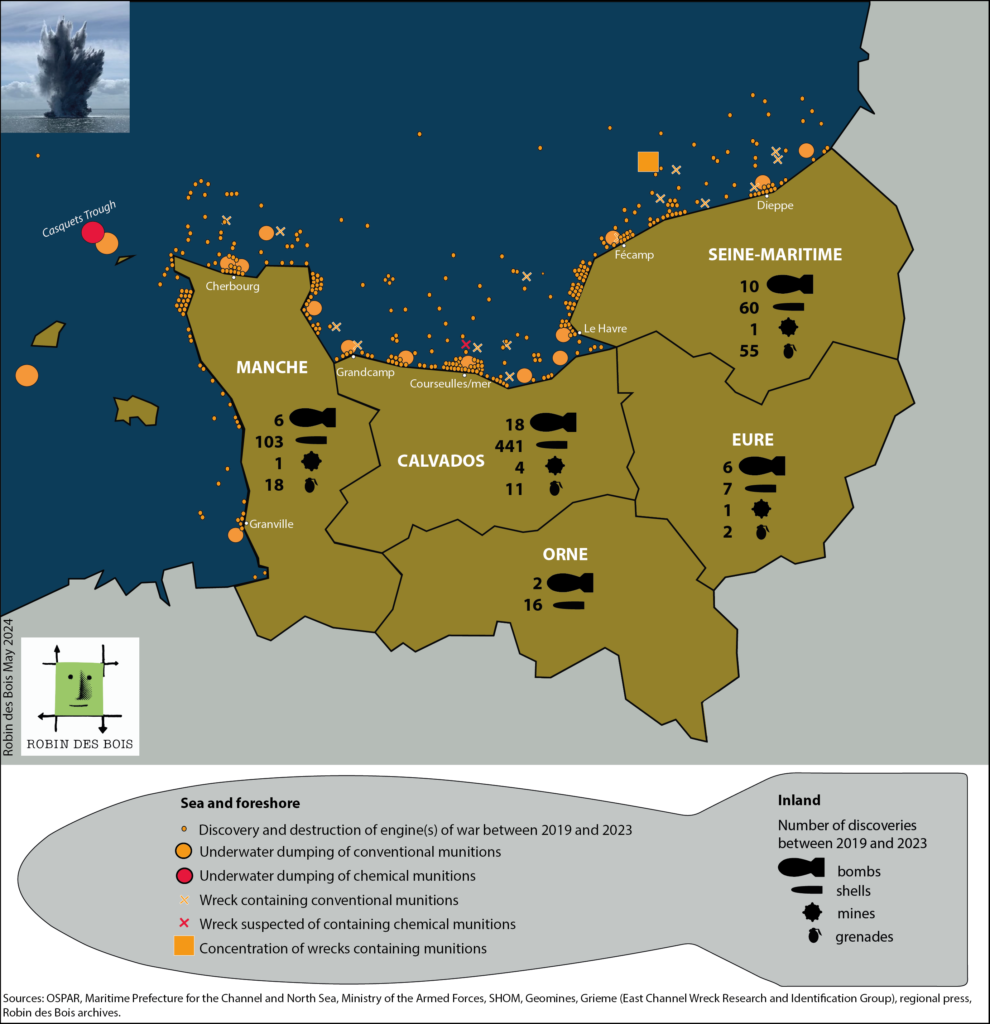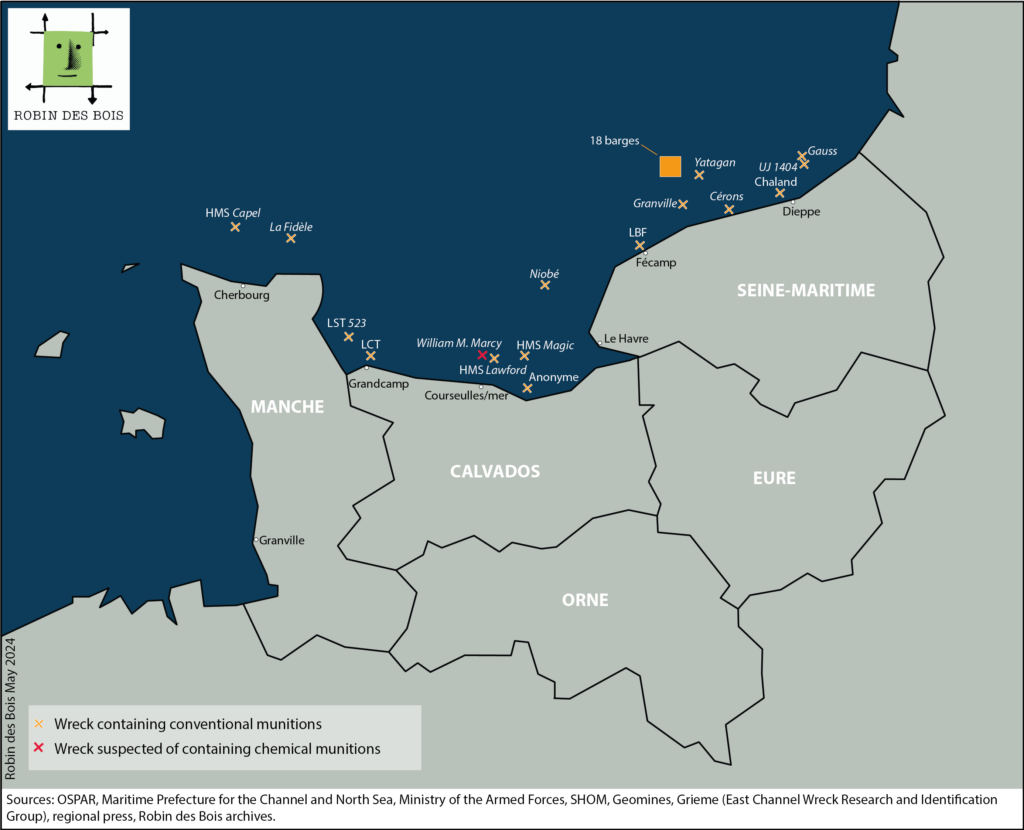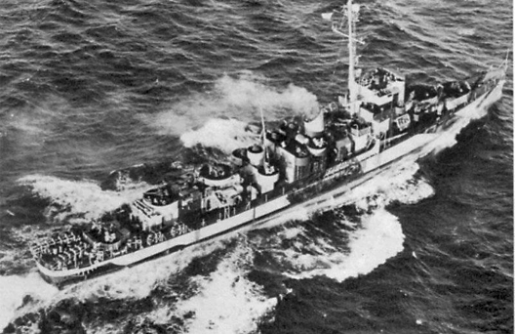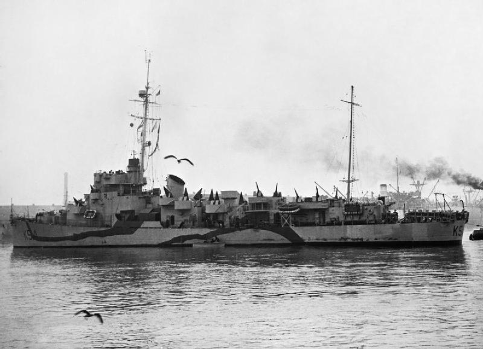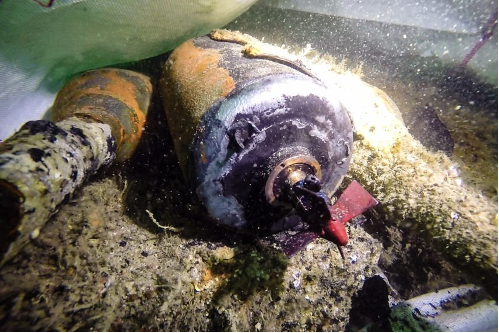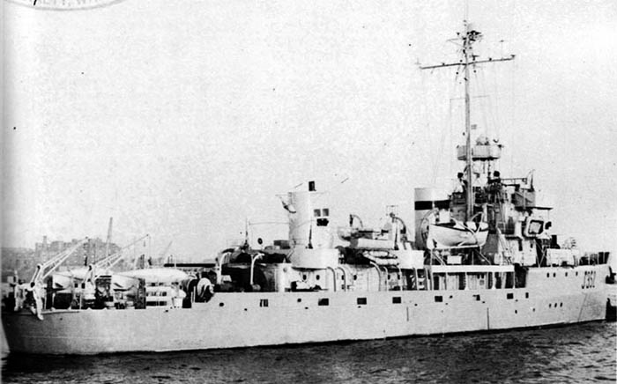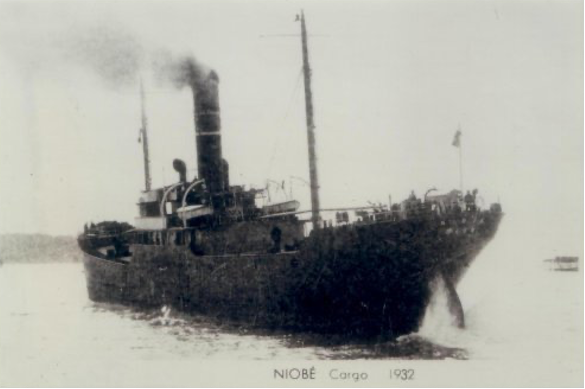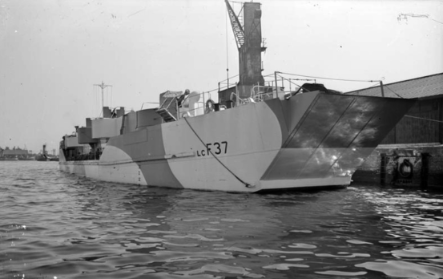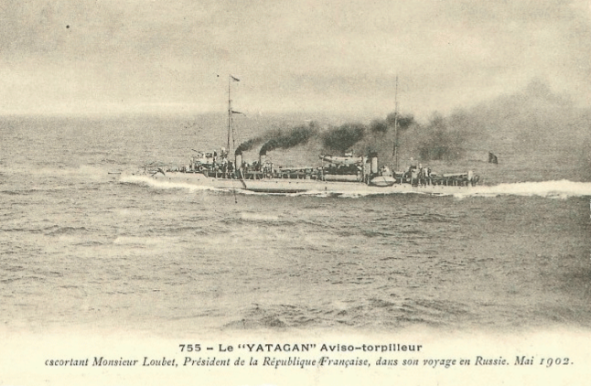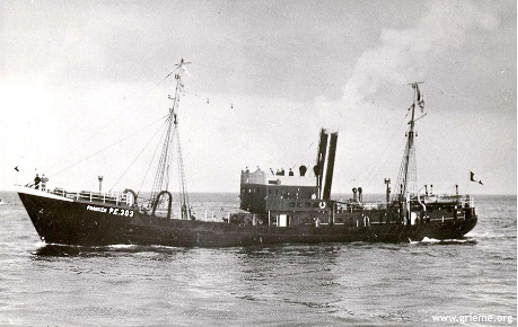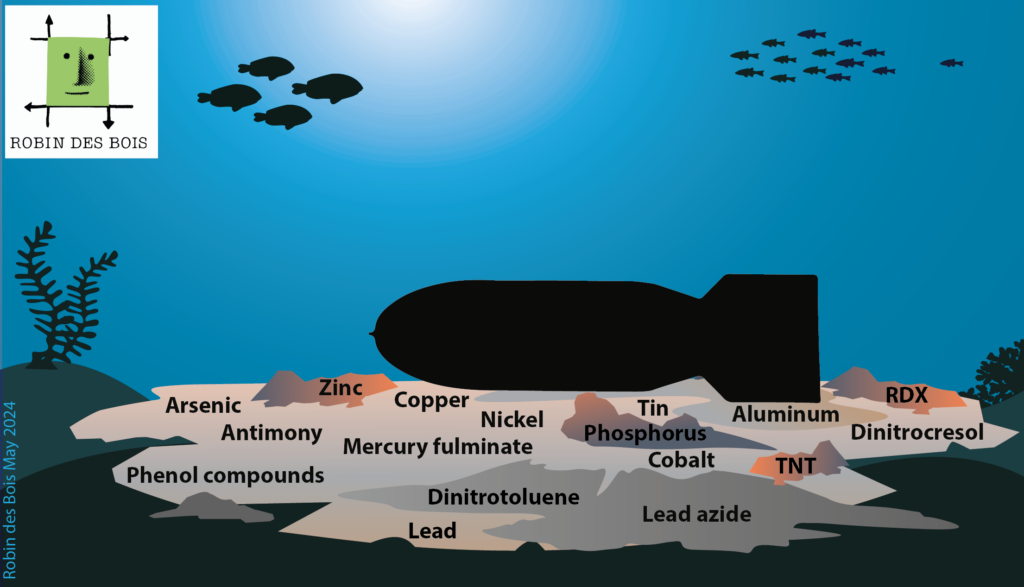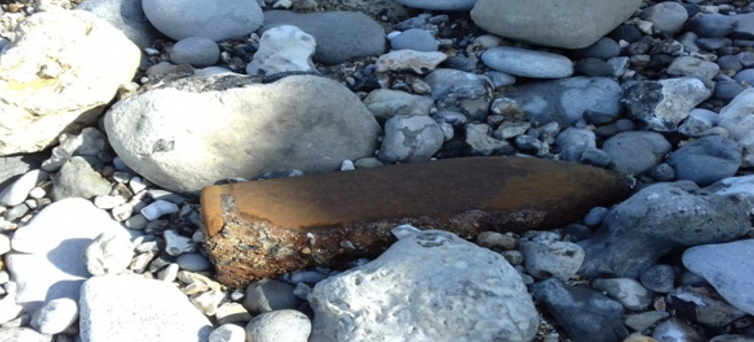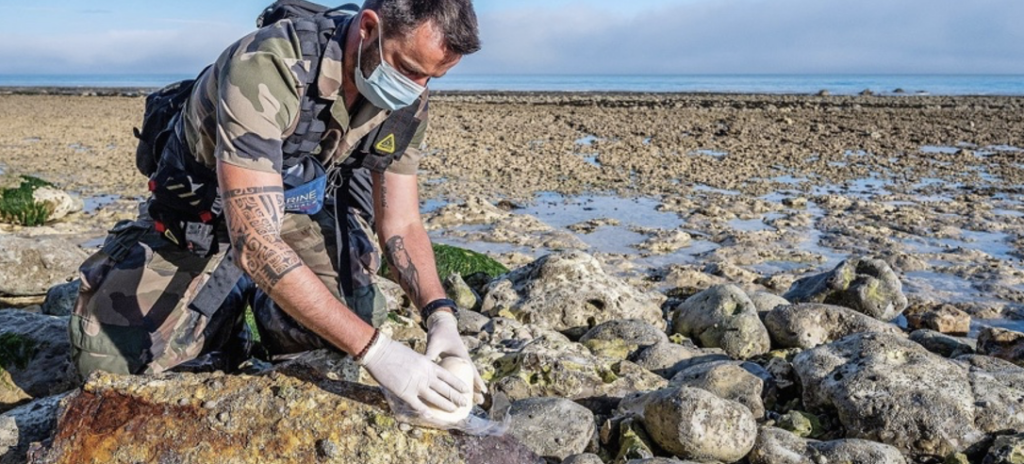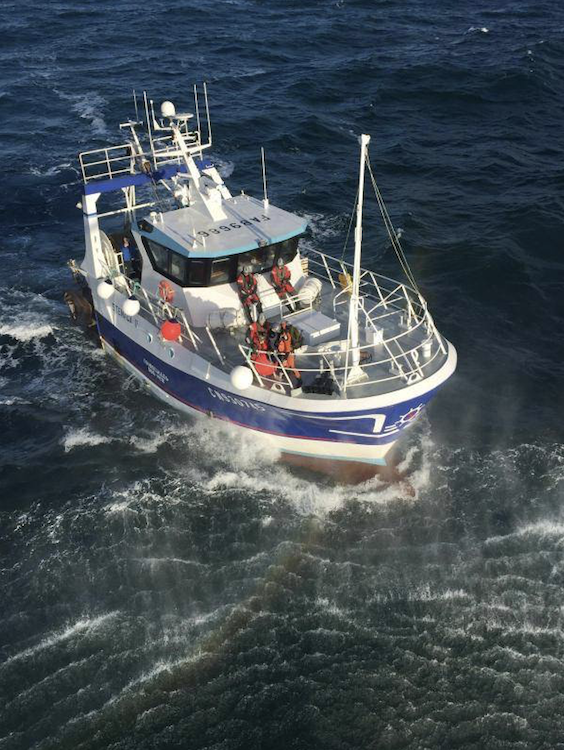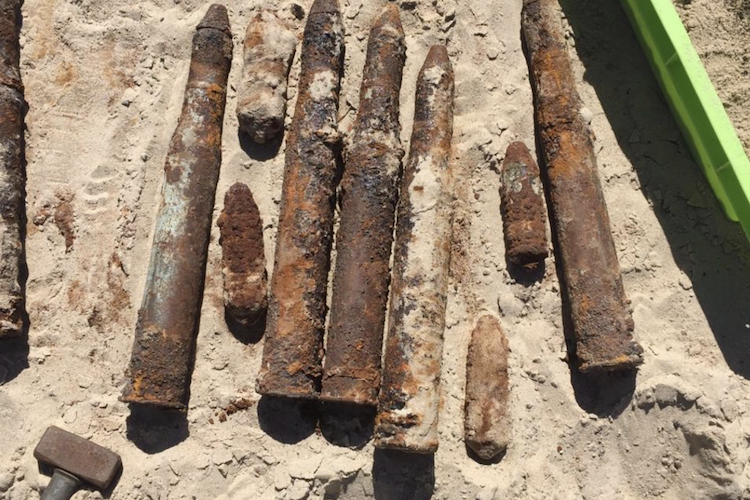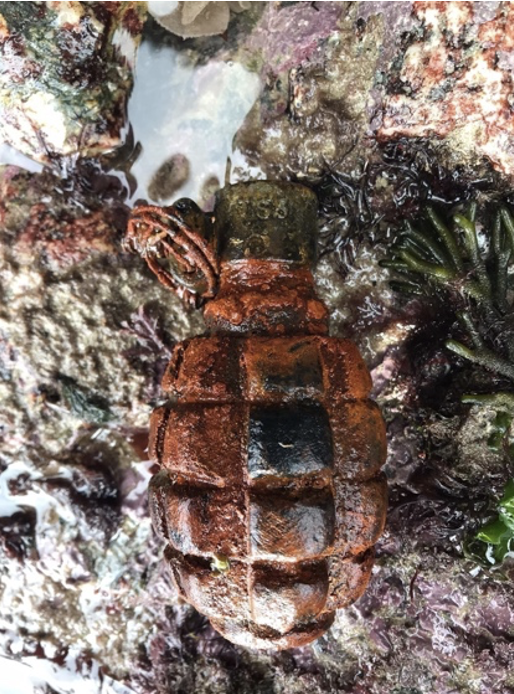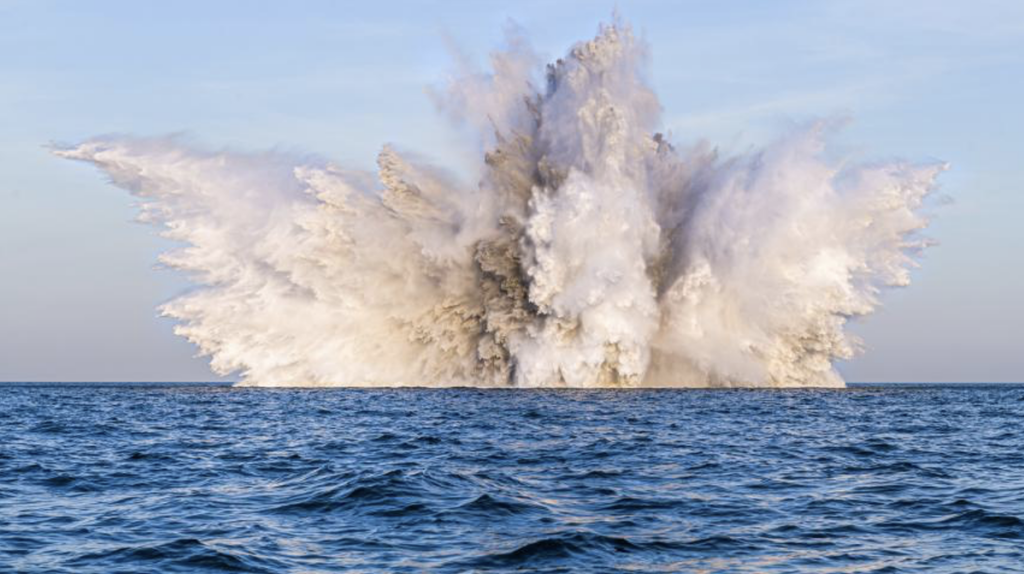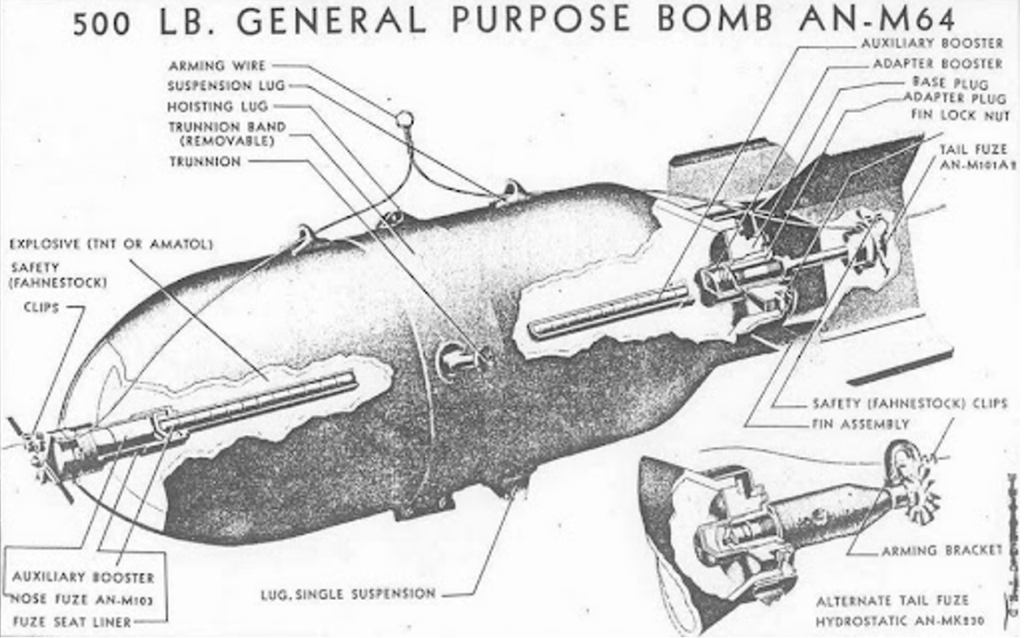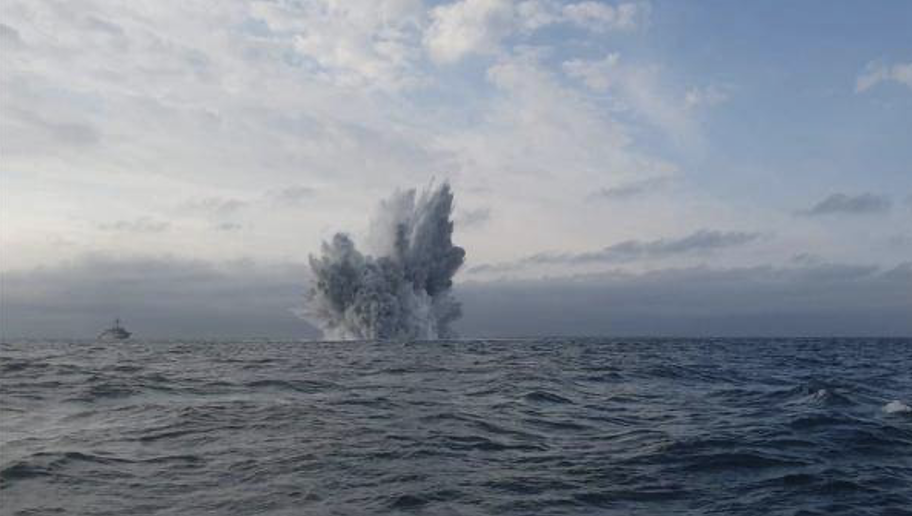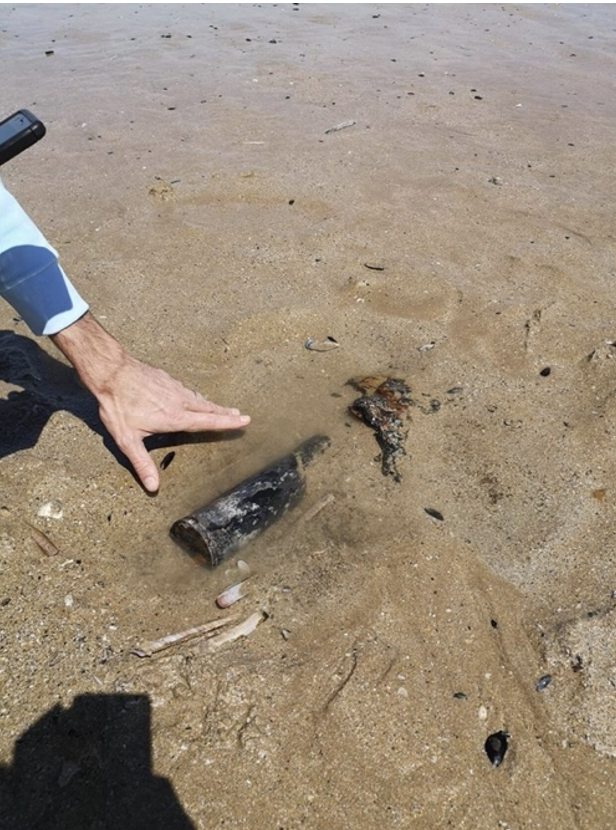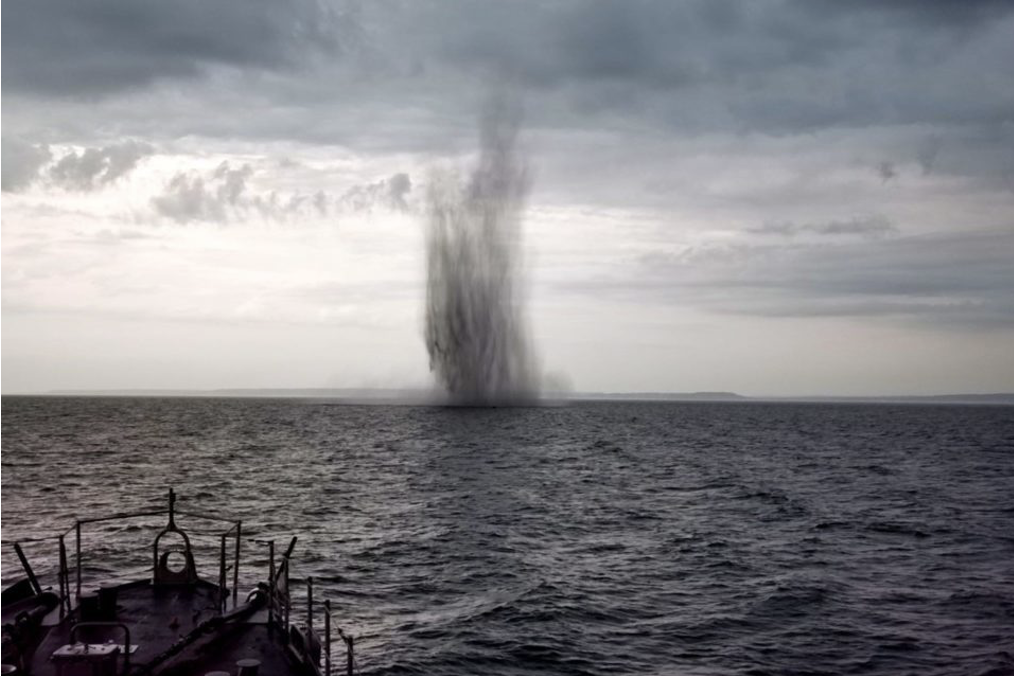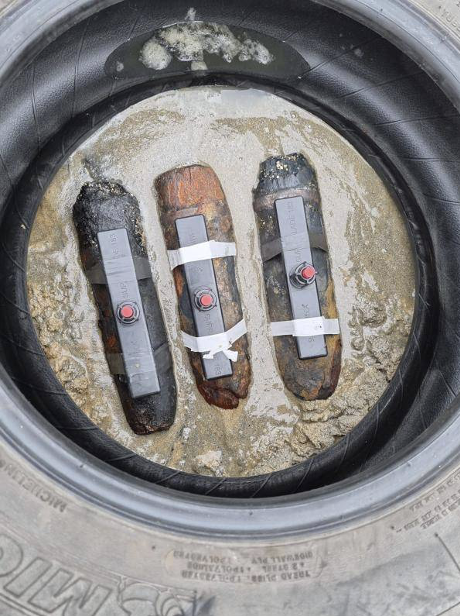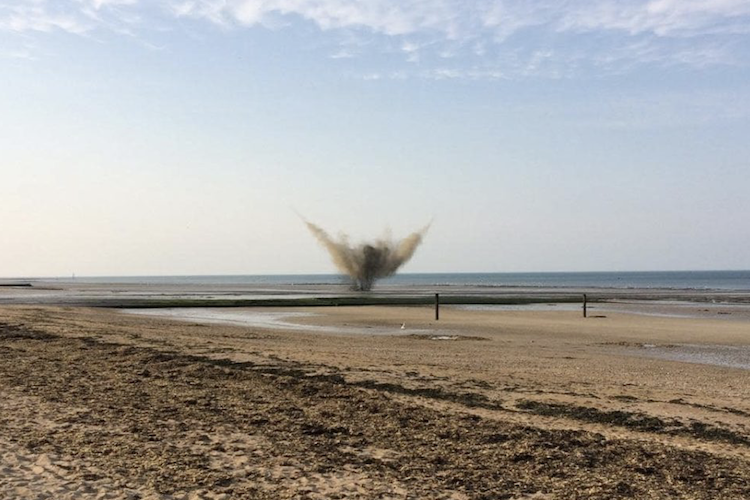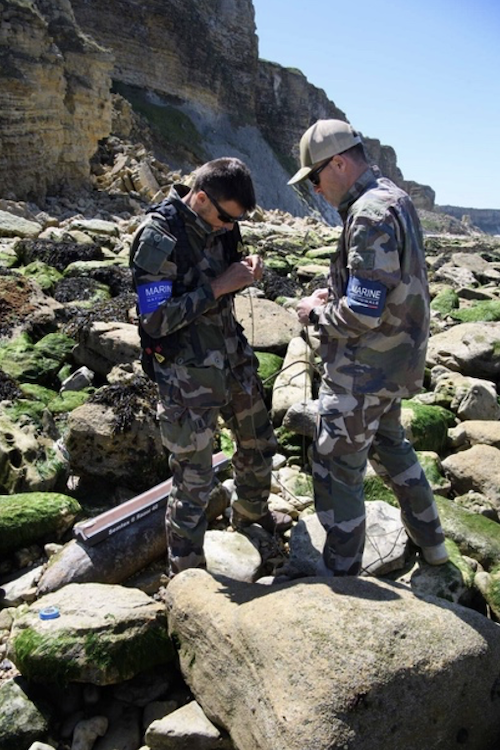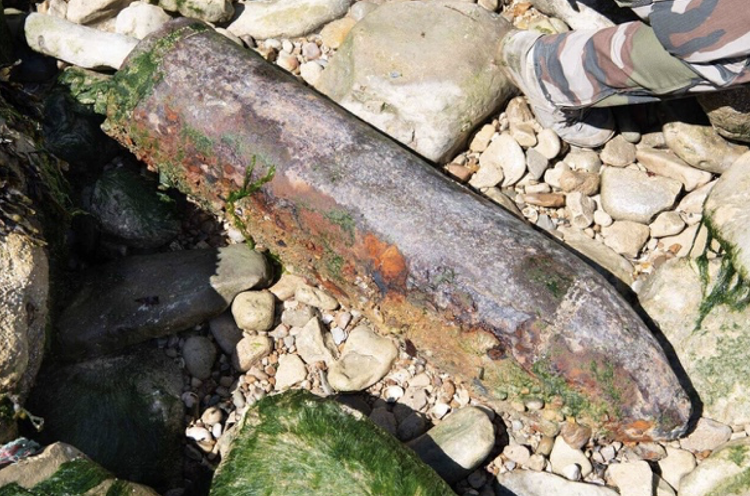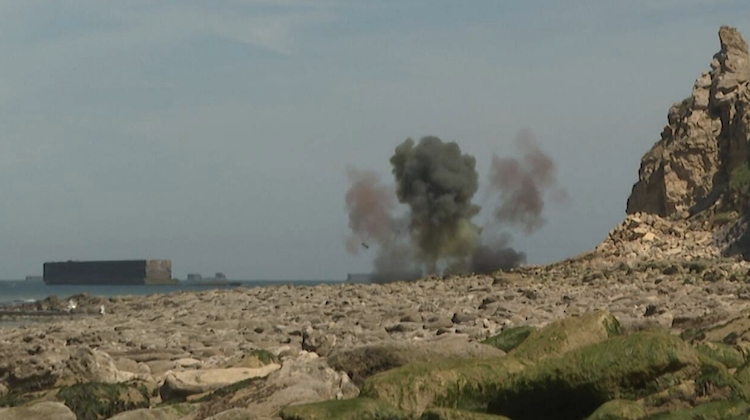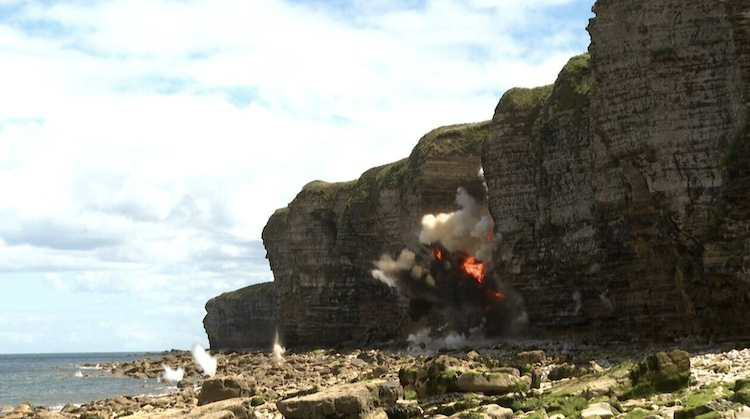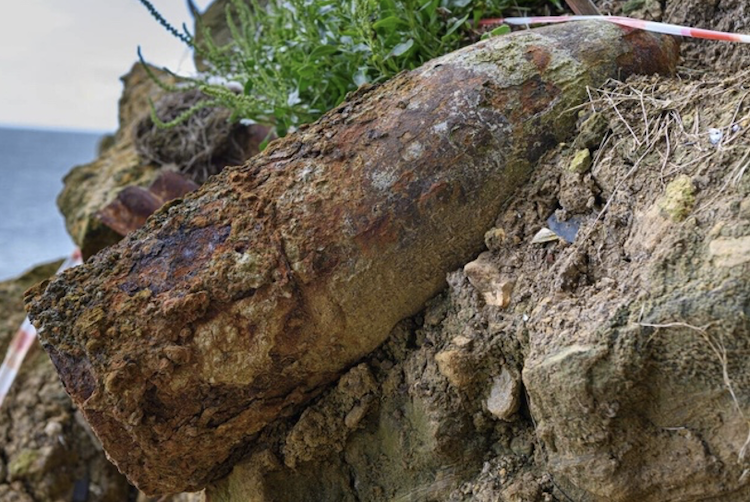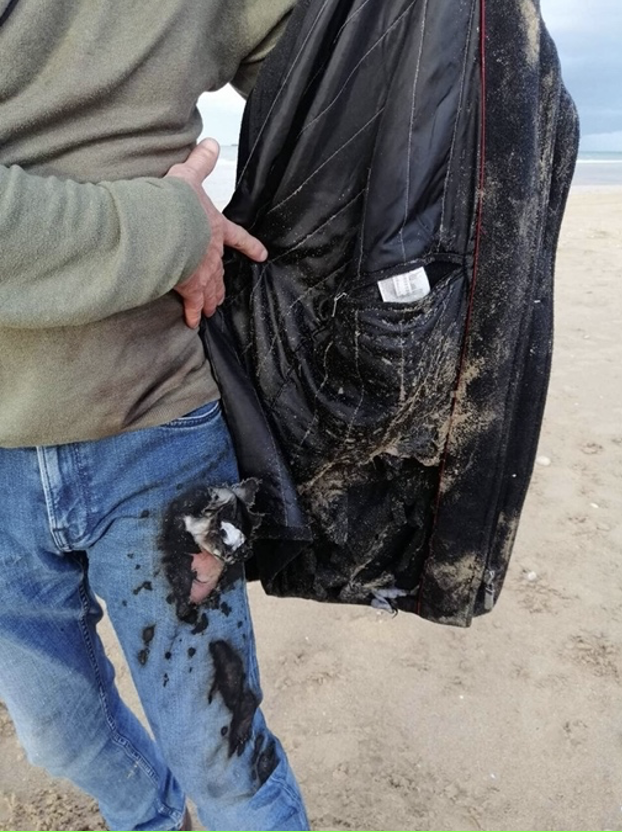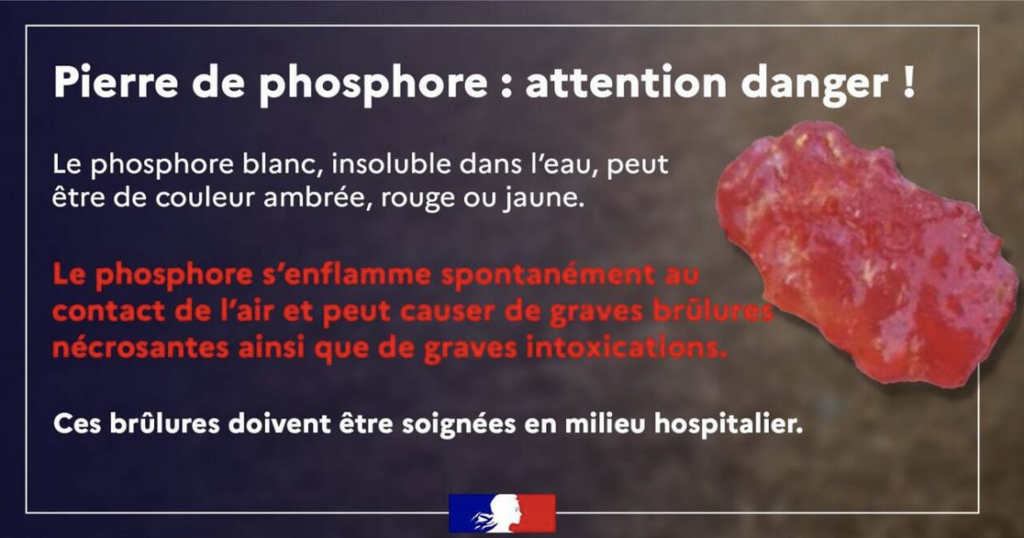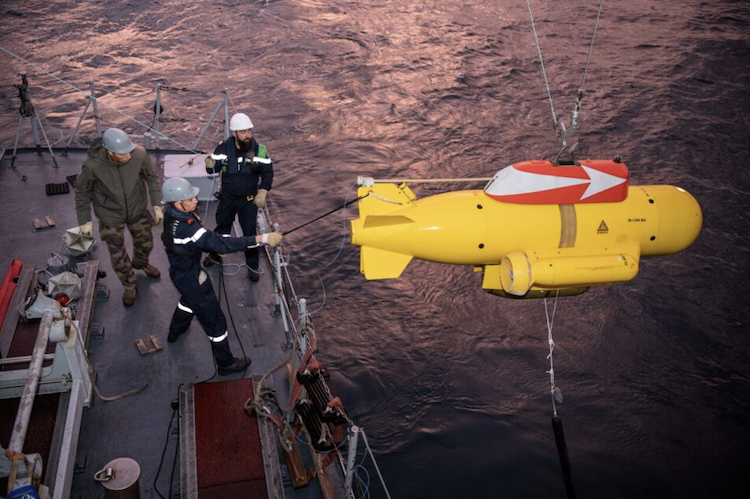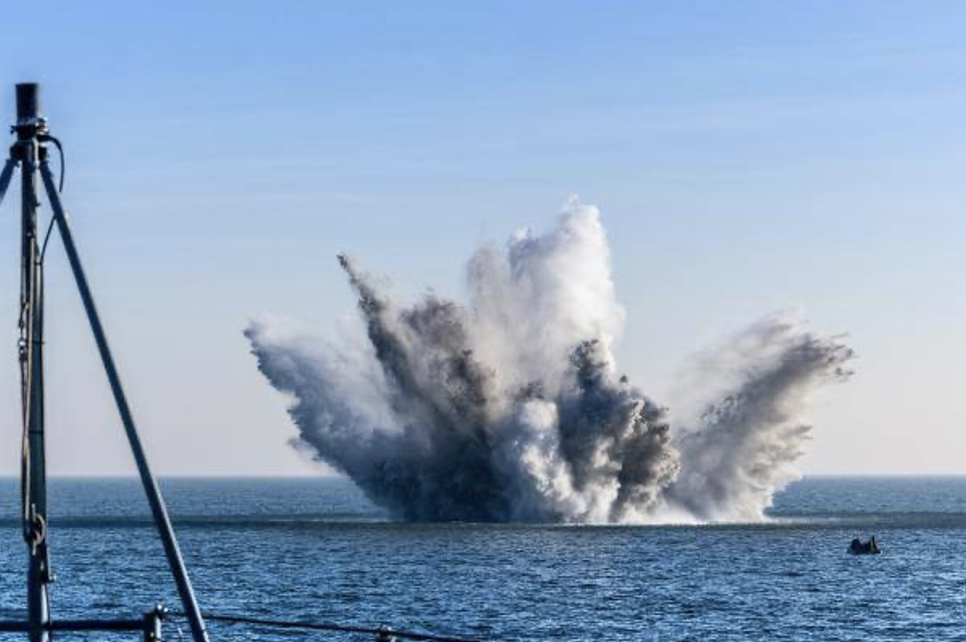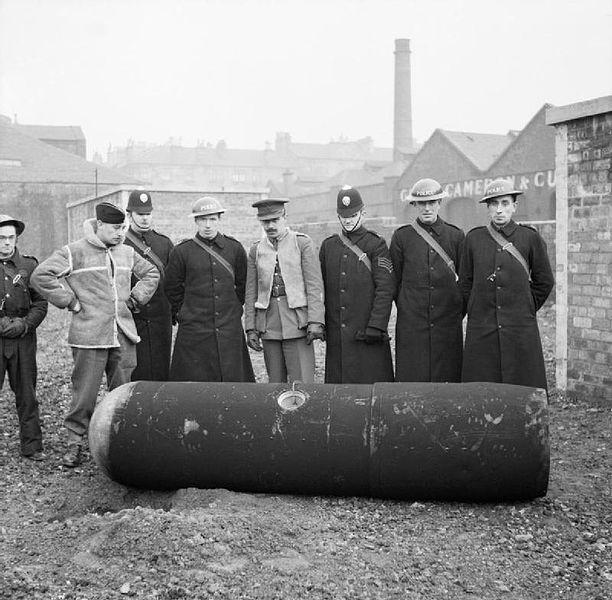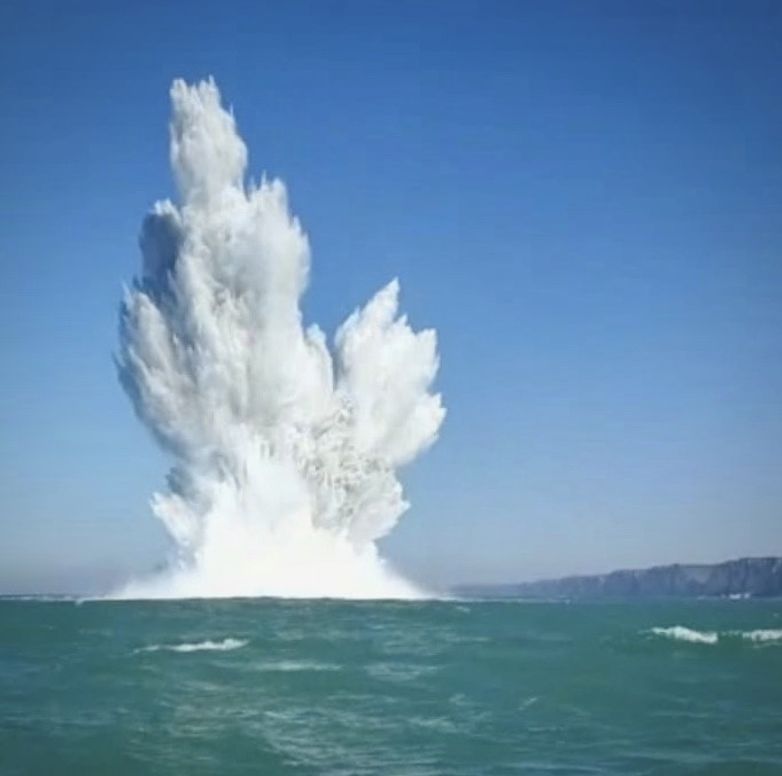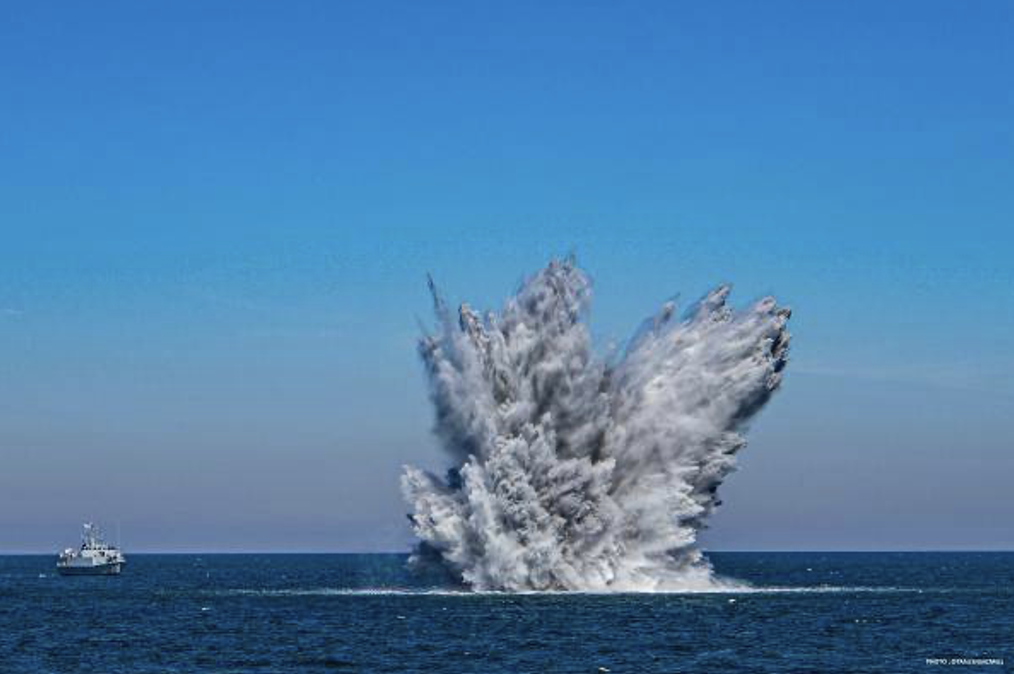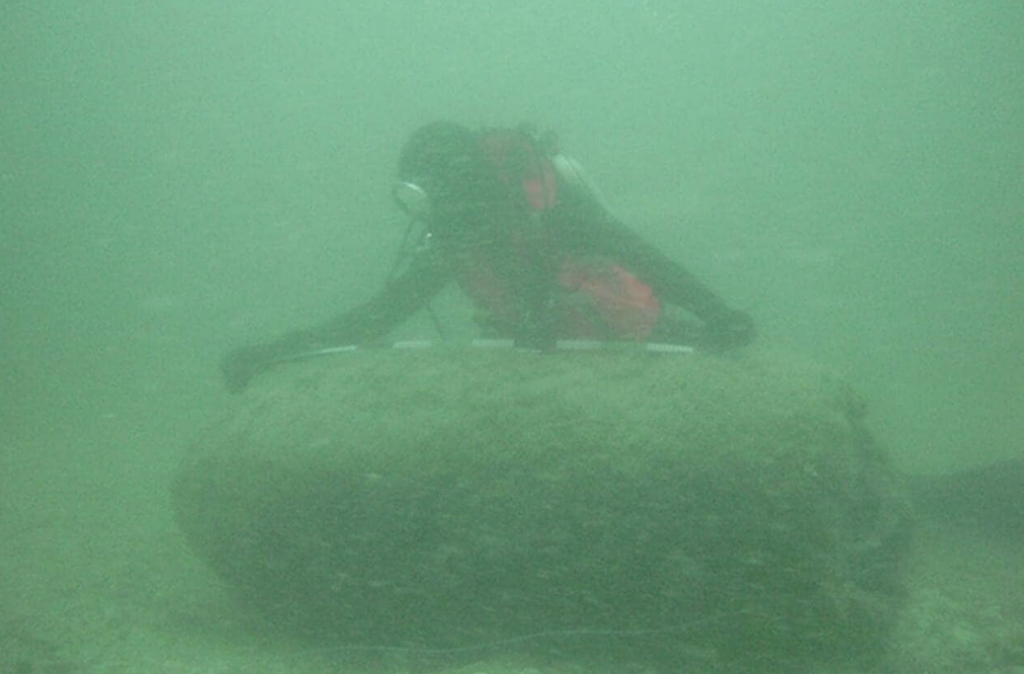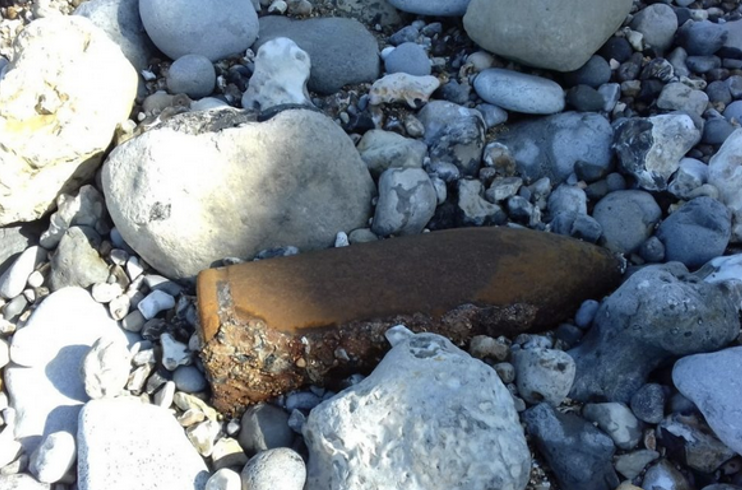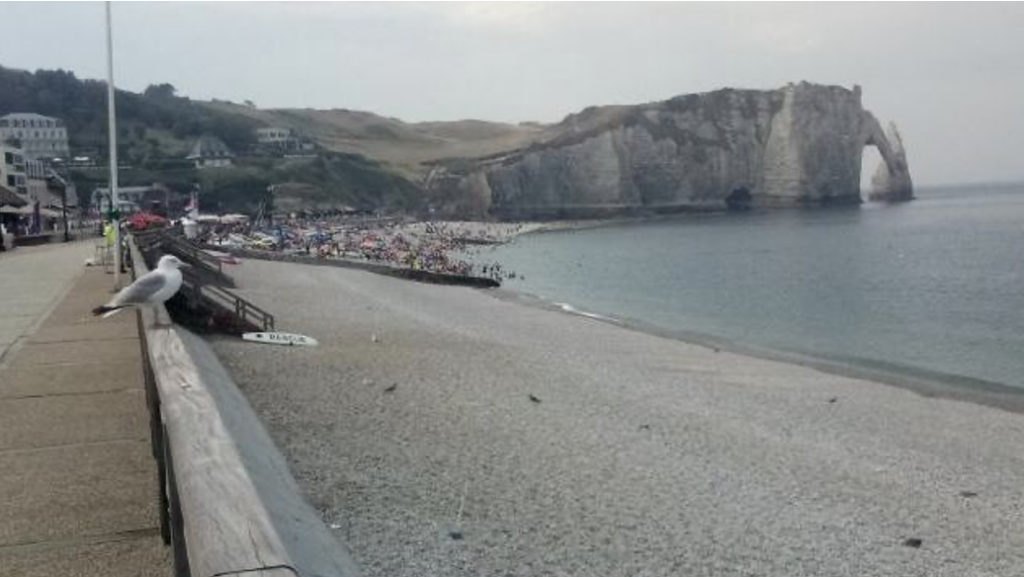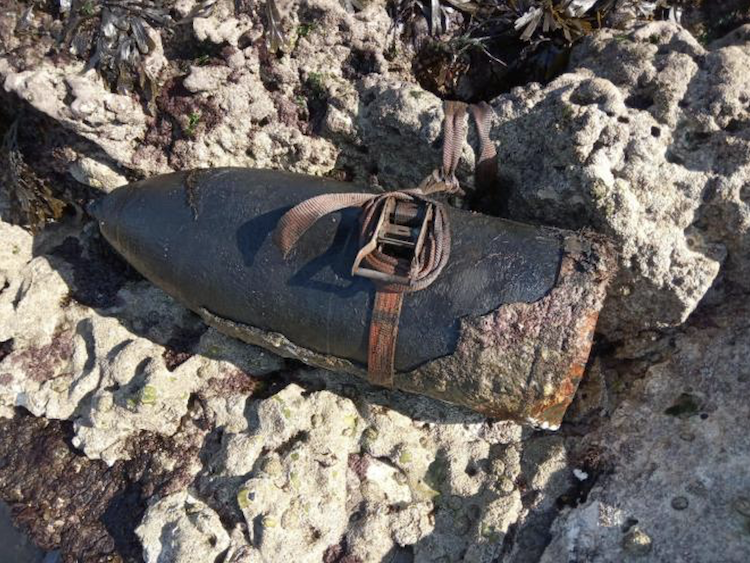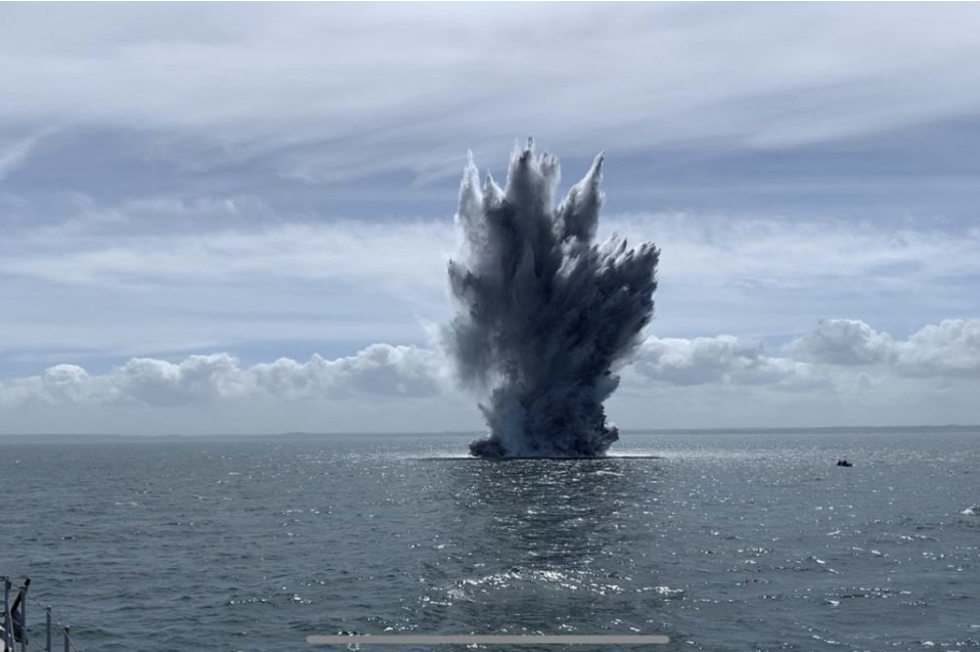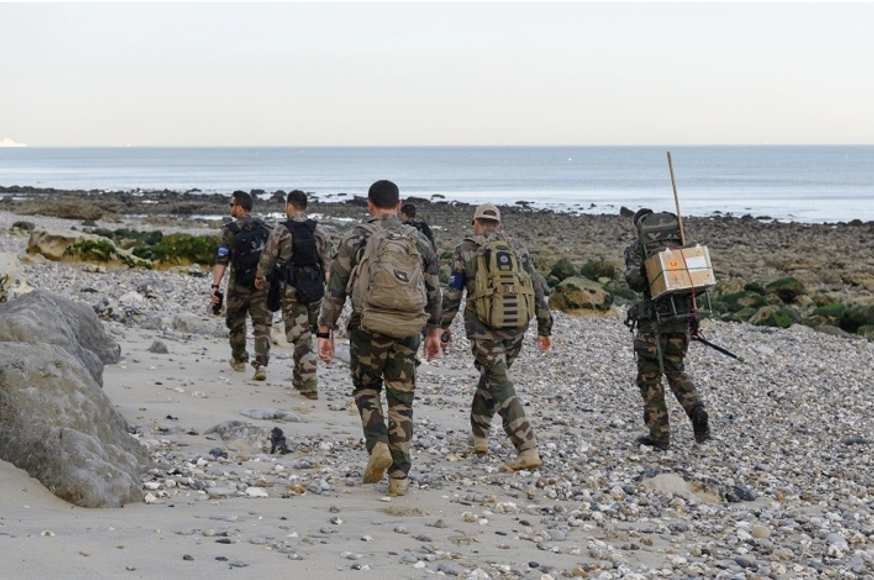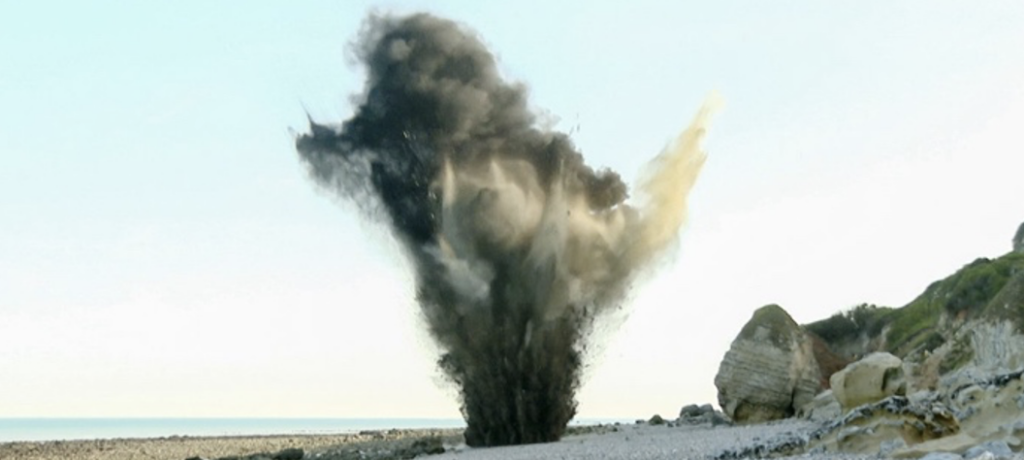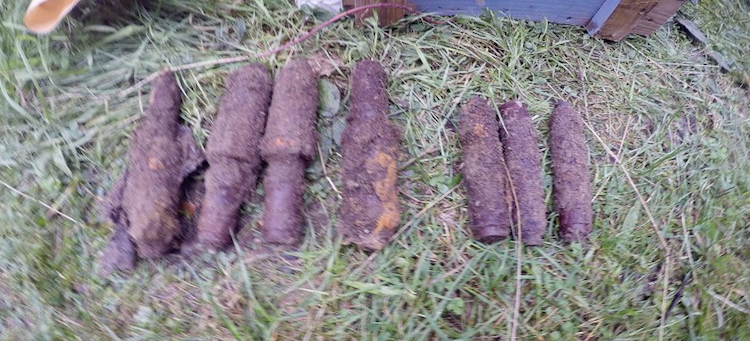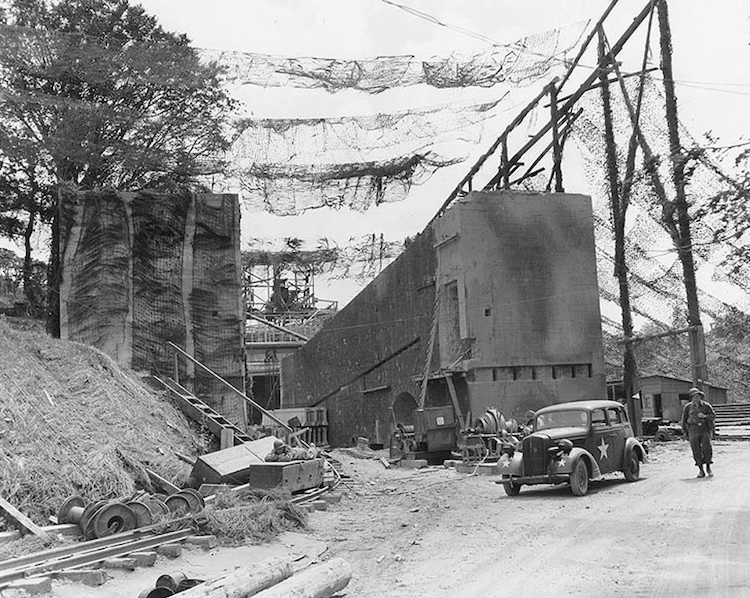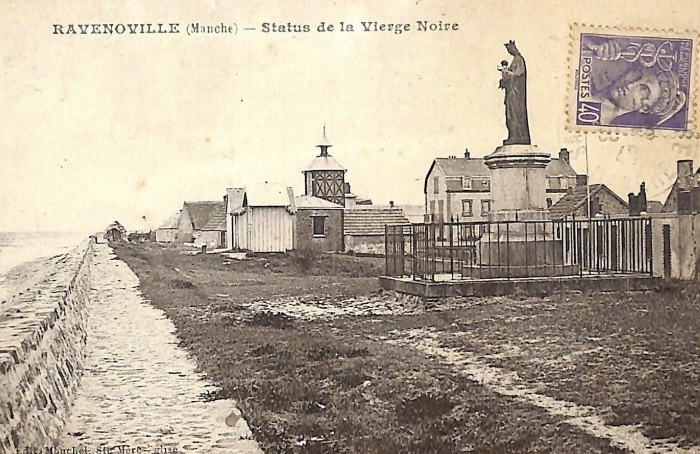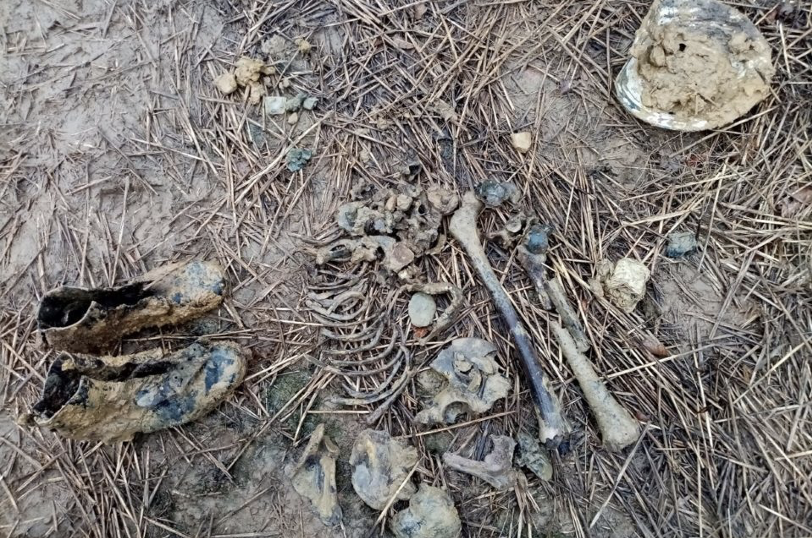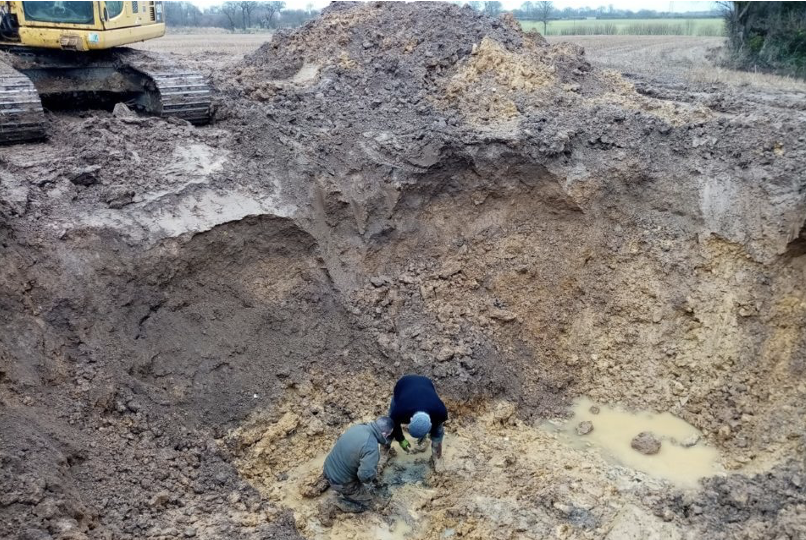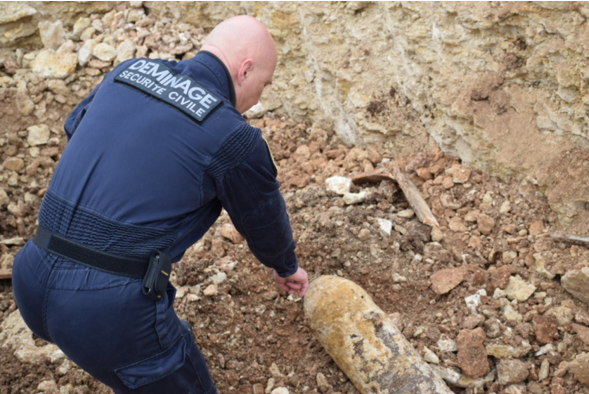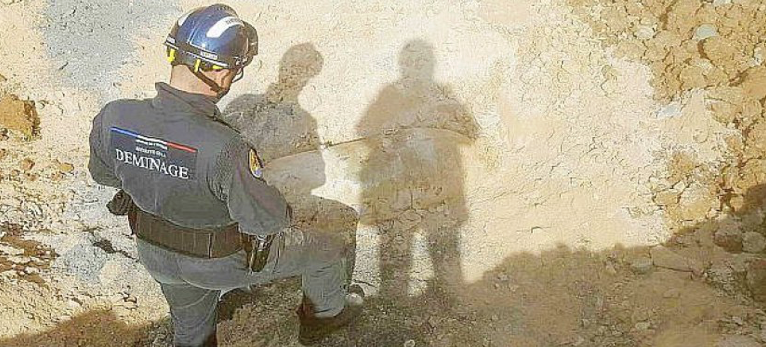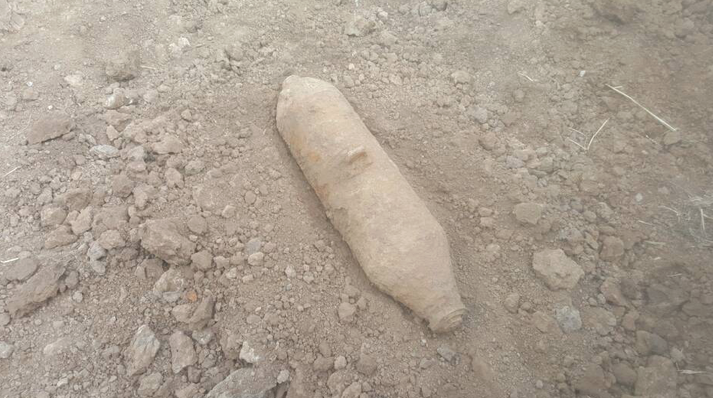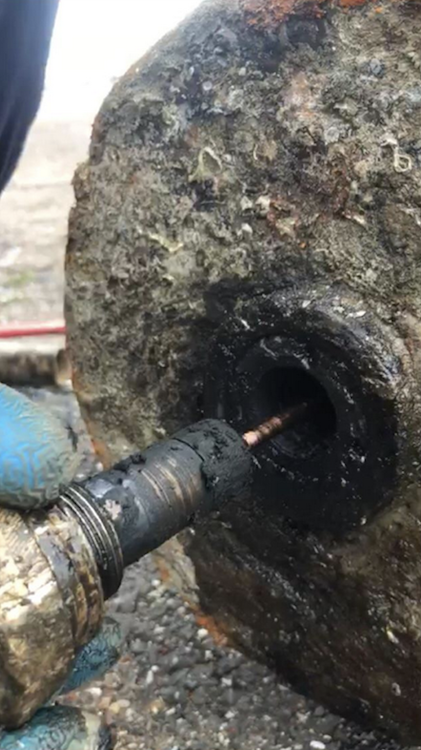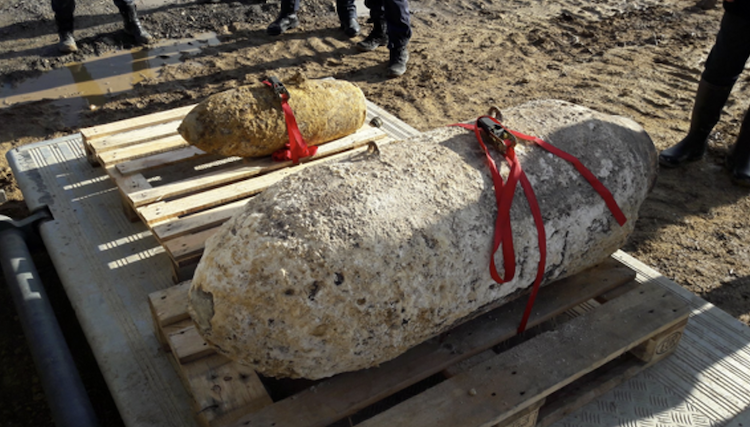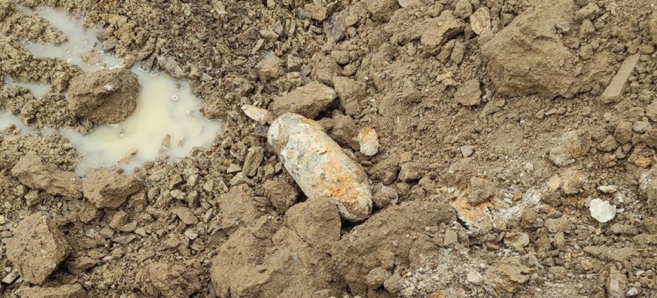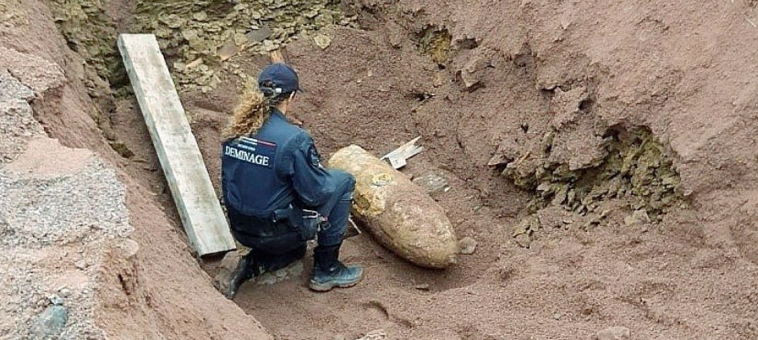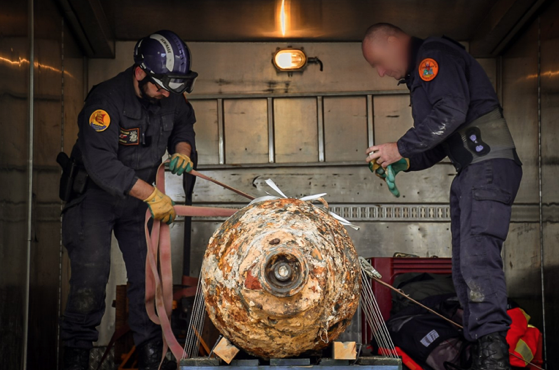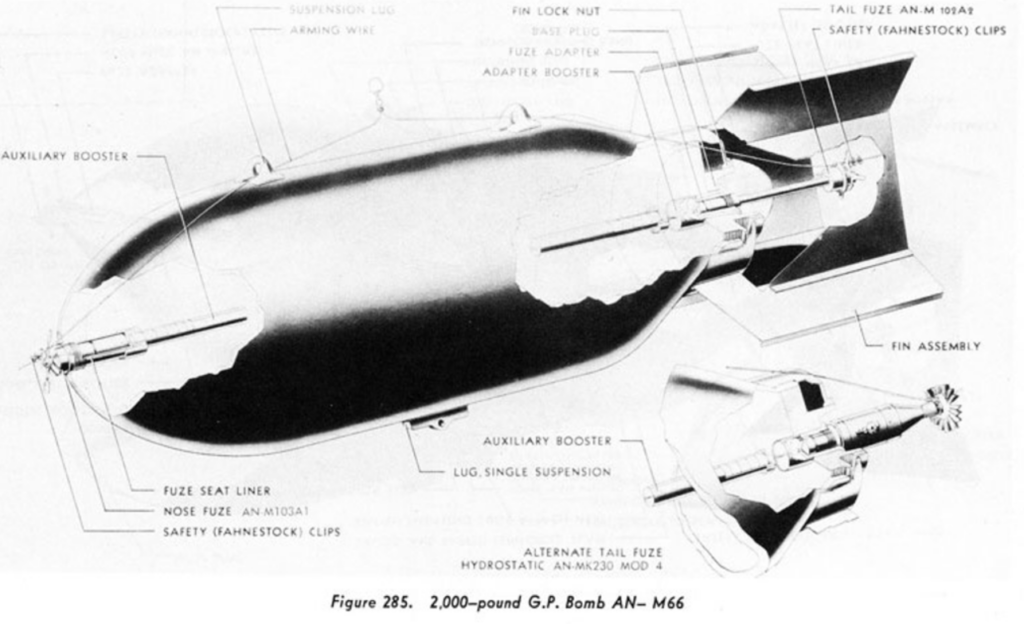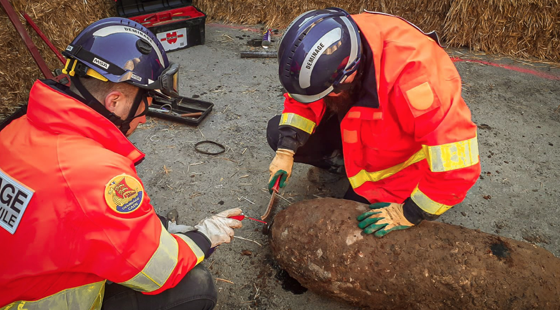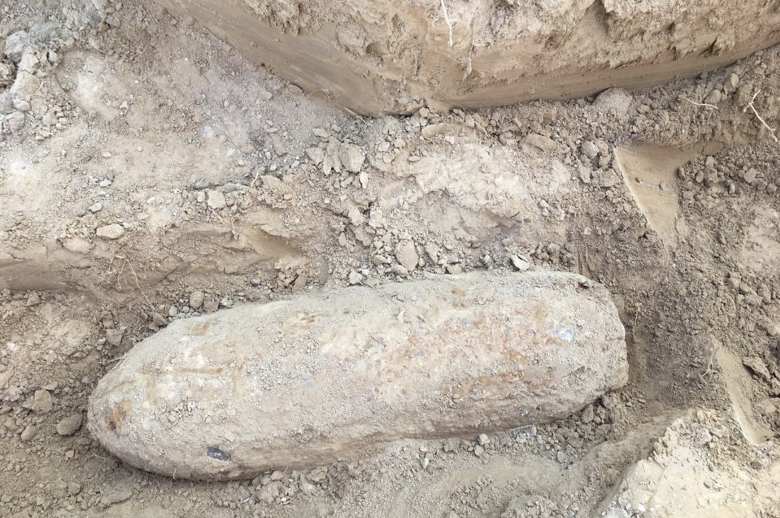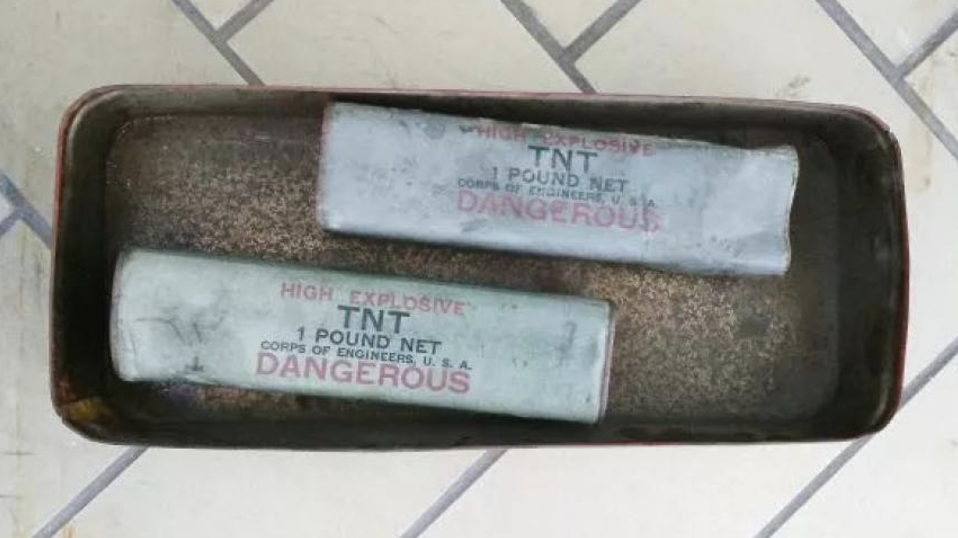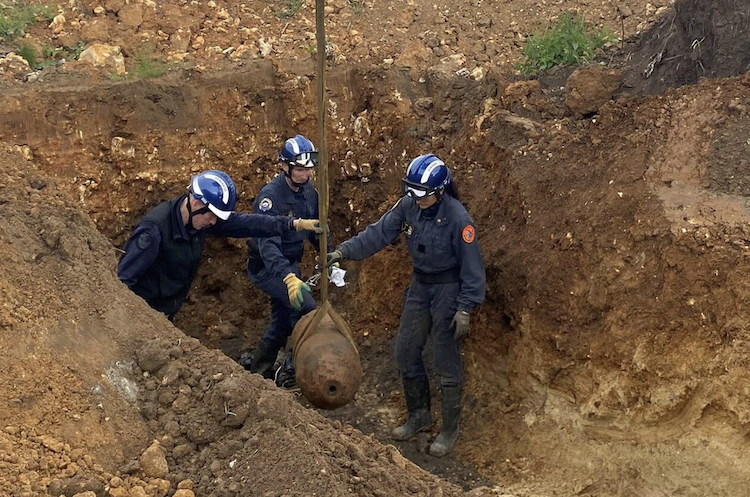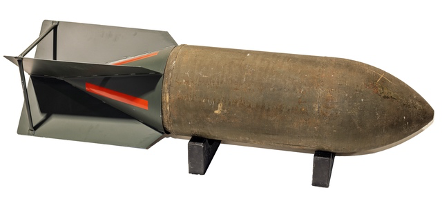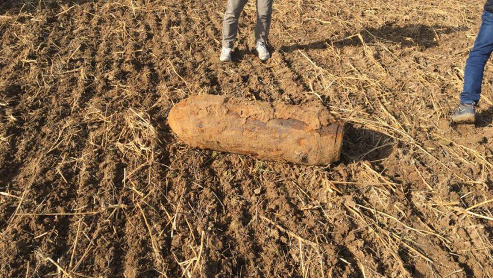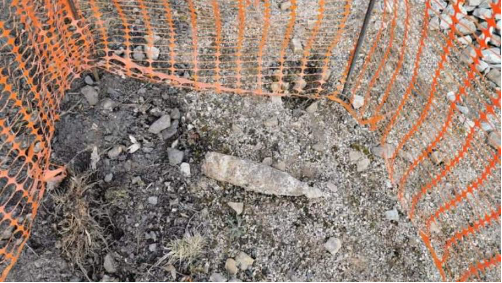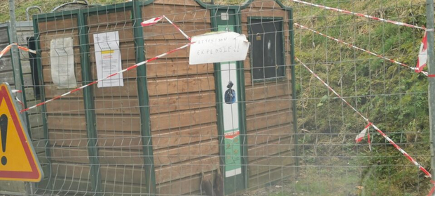On the 80th commemoration of the Normandy landings, Robin des Bois publishes its 9th inventory of discoveries and blasting of unexploded ordnance after the wars.
In pyrotechnic jargon, these UXO (Unexploded Ordnance) are also known as “duds”. Fortunately, these countless duds have prevented the loss of human life and additional ruin during wars. But today, 80 years after the Allied landings in Normandy, they continue to endanger civilians and explosive ordnance disposal teams alike, and pollute soil, and surface, groundwater, and marine water. Operation Overlord became Operation Overdose. This 9th inventory covers the 5 departments of Normandy, the foreshore (i.e. the part of the coastline between the highest and lowest tides), the Bay of Seine, and the Channel Sea.
15% of the ammunitions fired or dropped during the Second World War failed to explode. Their discovery and neutralization will take several centuries. In the meantime, they represent a major risk to the environment and public safety. In Germany, ordnance clearing experts are realistic and consider that “the time of the last bomb will never come”. In France, Olivier Saint-Hilaire, a great photographer and historian of war remnants, says that “the last dead of 1914-1918 is not yet born”.
The explosive and incendiary masses used by the warring countries in the last world war were made of penthrite, thermite, magnesium, phosphorus, petroleum, TNT, naphthalene, flammable oils, RDX (Royal Demolition eXplosive) known by the evocative name of cyclonite. Germany also used cluster bombs loaded with 46 kg of ammonium nitrate.
Floods, mudslides, cliff erosion and waves of submersion will set the army of forgotten shells in motion once again. Water-scarce rivers will more and more unearth the wastes of war. Beneath the red risk of forest fires lurks the risk of bombs and other abandoned explosive engines of war.
Blue, orange, red, black and khaki
80 years later, Robin des Bois’s map illustrates the blaze of the coast, the fireworks of war, the boundless reservoir of pyrotechnics, the spreading field of dinitro and trinitrotoluene explosives, the eternal demolition site of wrecks releasing mercury, tin and lead, and Normandy in khaki with its bombs and shells lying dormant in the countryside, in buildings, in the heart and arteries of towns, eco-districts and Seveso factories.
TABLE OF CONTENTS
34 underwater military wrecks and wastelands
Health and environmental risks
Classified pollution
What to do and not to do
Inventory of the discoveries and destructions of war remains from January 1, 2019 to December 31, 2023 in Normandy
1/ On the foreshore and offshore
Manche Department
Calvados Department
Seine-Maritime Department
2/ On land
Manche Department
Calvados Department
Seine-Maritime Department
Eure Department
Orne Department
34 UNDERWATER MILITARY WRECKS AND WASTELANDS
On land, dynamite factories, weaponry factories and Seveso plants using materials likely to cause mass destruction are hyper-protected by all available means, including the abusive withholding of information to counter the risks of malicious acts and terrorism. The door is closed. At sea, the door is often open, and not all wrecks are subject to a decree prohibiting scuba diving and exploration. Where they do exist, safety distances between scuba divers and the wreck are highly variable or non-existent. At least 2 wrecks containing ammunitions are even the subject of sheets issued by the DRASSM (Department of Subaquatic and Submarine Archaeological Research) and the Normandy administrative region facilitating their exploration. All you have to do is have a look and, why not, help yourself, especially as these wrecks are disjointed and scattered across a sort of underwater military wasteland.
This inventory of wrecks containing ammunitions and explosives off the coast of Normandy does not claim to be exhaustive.
HMS Capel. Ex- USS Wintle (DE-266).
88.21m long frigate built in Boston, USA, launched in April 1943 and transferred to the Royal Navy in June of the same year. She was hit by a torpedo fired by the German submarine U-486 on December 26, 1944, and sank off the coast of Cherbourg, some 20km from today’s atomic site at La Hague. 80 men perished at sea. The survivors were recovered by a Motor Torpedo Boat (MTB). The wreck of HMS Capel still contains 300 depth charges and 60 tons of explosives.
La Fidèle
A 43-meter-long French Navy scow built by Ateliers et chantiers de la Manche in Dieppe named, La Fidèle, entered active service in 1969. On April 30, 1997, during an operation to dispose of 1,440 downgraded Spanish Laguna-type depth charges off Cap Lévi above a historic munitions dump, an explosion occurred and, by contagion, grenades still stored on board exploded. According to information gathered by Robin des Bois, they were particularly defective and dangerous to handle. They came from the Le Crotoy pyrotechnic site in the Bay of the Somme, which had been open since 1948. The final closure of the Le Crotoy site was ordered at the end of 1996, after a chain reaction destroyed all the buildings, killed several seals and “disturbed” all the ammunitions awaiting destruction. See “Cherbourg, sinking of the “La Fidèle“ (May 1, 1997, ) and La Flèche n° 33 page 13. La Fidèle sank in a matter of minutes, leaving 5 dead (3 missing) and 17 injured. An initial decree prohibiting access to the wreck was issued the same day by the Maritime Prefect for the Channel and North Sea. On January 24, 2001, a new decree permanently prohibited navigation, anchoring, trawling, dredging and scuba diving within a radius of 1.5 miles (2.8 km) “due to the dangers presented by the explosives still contained in or scattered around the wreck of the vessel ‘La Fidèle'”.
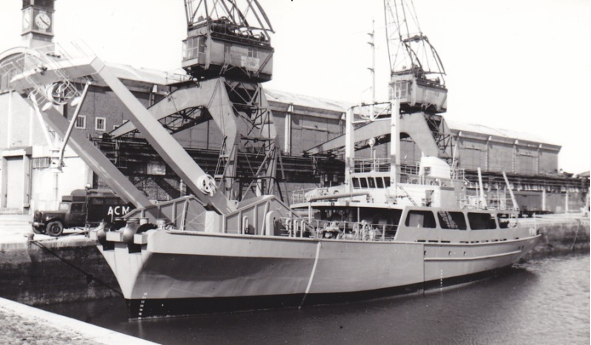 Photos postenavalemilitaire.com
Photos postenavalemilitaire.com
LST 523
98-meter US Navy Landing Ship Tank, built in Indiana, USA, and commissioned in 1944. This type of barge, or landing craft, was used to transport troops, vehicles, materials and heavy equipment and land them on the beaches. On June 19, 1944, while carrying at least 210 men including medics, Sherman tanks, jeeps and ammunition, she was caught in bad weather. As she maneuvered, waiting for a lull in the weather, she hit a German mine, causing part of its cargo, including 15 tons of dynamite, to explode. Attempts by the US Navy to salvage the war material in late June 1944 were unsuccessful, and “as a result, almost all the artillery remains in the wreck“, according to the LST 523 presentation sheet published by DRASSM with the support of the Normandy region. However, this fact sheet gives the exact coordinates of the wreck and indicates in a box entitled “I’m a responsible diver” that you should report the presence of dangerous explosive devices to CROSS (regional monitoring and rescue centre) Jobourg!
Anonymous LCT or TLC
US Navy Landing Craft Tank (or Tank Landing Craft). This type of light barge could carry up to 5 tanks. This sunken TLC is the subject of a decree issued by the Maritime Prefect for the Channel and North Sea on October 23, 2018, prohibiting the navigation, parking and anchoring of ships, craft and boats, as well as fishing and scuba diving in the vicinity of the wreck, given the discovery of historical explosive devices constituting a danger to the safety of people and property “as long as they are present and the Channel Mine Clearance Divers’ Group has not completely neutralized them“.
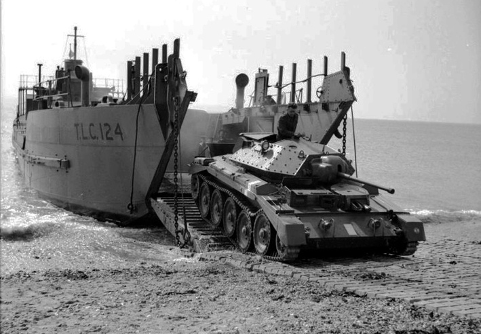 Example of TLC © Imperial War Museums
Example of TLC © Imperial War Museums
William M. Marcy
According to the James Martin Center for Nonproliferation Studies (Middlebury Institute of International Studies), this liberty ship was scuttled near this position on August 7, 1944 with a cargo suspected to be chemical weapons. According to other sources, she was hit by a U-boat torpedo off Juno Beach, but was towed away and, after many twists and turns, scuttled in the North Sea in 1945 or 1948 with a cargo of obsolete munitions.
HMS Lawford (ex USS Lawford)
This Escort destroyer was also built in Boston for the US Navy, at 88.24 m long, she was launched in 1943 and transferred to the Royal Navy to become a frigate. An embarked command post for Operation Overlord, she was the target of the German air counter-offensives. She was hit by Junkers 88 fire and sank at dawn on June 8, 1944. 37 men perished. On October 25, 2016, the Maritime Prefect for the Channel and North Sea issued an initial order prohibiting the navigation, parking and anchoring of ships, craft and boats, as well as fishing and scuba diving in the vicinity of the Lawford due to the presence of ammunitions. The Mine Clearance Divers’ Group estimates that 83 mortars and 50 boxes of ammunition are in the holds. Initial ammunition removal and disposal operations are reported to have been carried out. The Mine Clearance Divers’ Group intervention reports are not made public.
On December 14, 2021, considering that “historical explosive devices remain inside the wreck and cannot be neutralized“, the Maritime Prefect issued a new prefectoral decree. Its scope is much narrower than the first, and only scuba diving is prohibited inside the wreck. However, this does not prevent the DRASSM and the Normandy region from sending the amateur diver into a battlefield, providing a detailed sheet with GPS coordinates of the wreck, and indicating in a box entitled “I’m a responsible diver” that the presence of dangerous explosive devices should be reported to CROSS Jobourg. All over the world, these famous scuba diving hotspots are part of the tourist attraction, with no regard for public safety. These wrecks are vulnerable to looting and ammunition misappropriation.
HMS Magic
British minesweeper, 67.45 m long, originally built for the US Navy in Savannah, Georgia (USA), launched in 1943. She sank on July 6, 1944, hit by a German “Neger” human torpedo, also known as a mounted torpedo (see below, off Ouistreham, Wednesday November 20 and Thursday November 21, 2019). 26 men perish. The Cato, which came to rescue the survivors, was also sunk. A mine-clearing operation at the end of 2019 resulted in the extraction, removal and disposal of 28 artillery shells released by the Magic. How many remain?
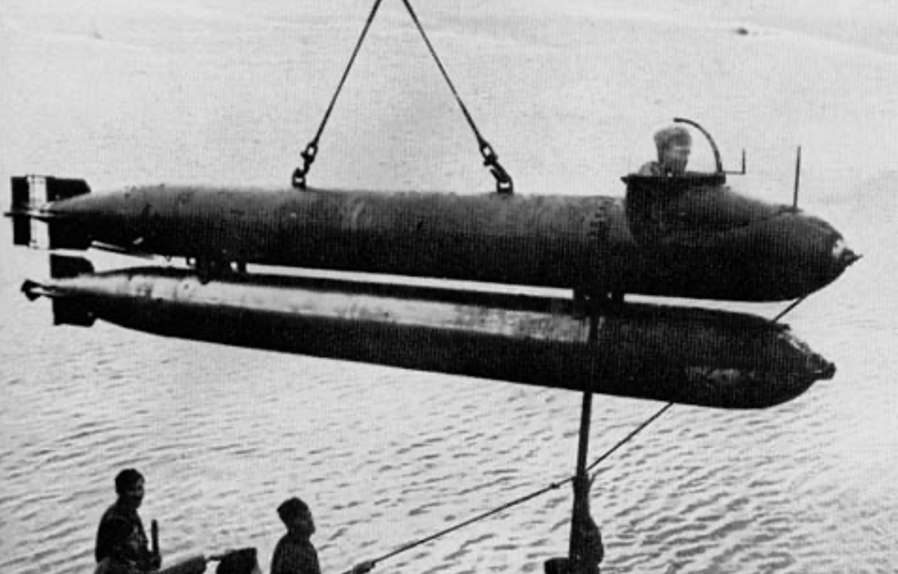
Anonymous
All we know about this wreck is that since July 5, 1996, she has been covered by a decree issued by the Maritime Prefect for the English Channel and North Sea prohibiting scuba diving, dredging, trawling and anchoring in the vicinity, given that “a wreck from the Second World War, located off Ouistreham, still contains buried ammunitions”.
Niobé
A 79.3m long French ore carrier built in 1920 in Blyth, England, and operated by Société Navale Caennaise, the Niobé was requisitioned in May 1940 to transport foodstuffs and munitions. On June 10, 1940, the Niobé was in Le Havre. The Germans were approaching, and the Niobé took on hundreds of civilians fleeing the enemy, without having been able to unload her cargo of some 800 tonnes of ammunition beforehand, for lack of available dockers and suitable equipment. She left the port on the morning of the 11th, overloaded with civilians. She was quickly attacked by German aircraft and hit by 3 bombs. According to Grieme’s (Group for Research and Identification of Wrecks in the Eastern Channel) report no. 171 dated June 17, 1962 from the Cherbourg maritime police, the sinking caused between 800 and 1,200 deaths. 11 survivors were recovered by the Cotentin. Before she was identified, the Niobé was known as the “ammunition wreck”, a nickname for which she is not the only one.
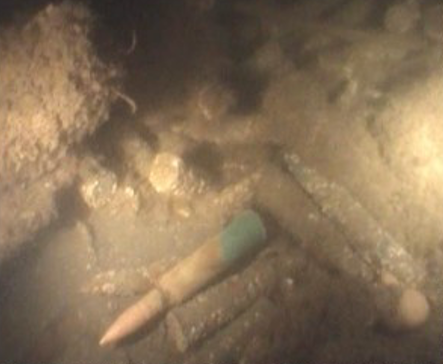 The wreck of the Niobé. © Grieme
The wreck of the Niobé. © Grieme
Anonymous Landing Craft Flak (LCF)
This English “Flak” barge was sunk on August 26, 1944 off Fécamp, which was liberated on September 2. LCFs were armed with two 40 mm Bofors guns and two 20 mm Hispano guns, or two double Lewis machine guns. They could carry guns and land them on beaches. They were manned by 5 men and measured between 18 and 27 meters in length.
Granville
French coaster, 51.9 m long, built in Beverley, England, and launched in 1929, was operated by Société Havraise de Transport et de Transit Le Havre and requisitioned by the French Navy in 1939 to become an auxiliary cruiser. On June 13, 1940, she was hit by coastal artillery as it approached the German-held port of Saint-Valéry-en-Caux. Mines carried on deck exploded. The ship sank, taking 23 crew members to the bottom of the sea. 22 survivors were rescued by fishermen from the trawler Anne-Marie and landed at Cherbourg. Identification of the wreck remains uncertain, but it is certain to contain ammunition boxes.
18 BK barges
18 American BK (Barge Knockdown) barges were scuttled during or at the end of the Second World War, around 30 km off the coast northeast of Fécamp and 8 km from the current site of the offshore wind turbine factory. According to the Préfecture Maritime, they were carrying 100 and 150 LBS (100 and 150 lb, or 45 and 68 kg) American aviation bombs. According to the historical pyrotechnical study of the Fécamp wind farm project carried out in 2011 by Geomines, 2,000 250 kg bombs are believed to be in the wreckage. The barges were surveyed in 2009 by a mine hunter, and the maritime prefect’s order of June 19, 2009 prohibits anchoring, trawling, dredging and scuba diving within a 4 nautical mile (approx. 14 km2) zone around the wrecks. Pyrotechnic clean-up operations are regularly carried out, both voluntarily and involuntarily. In 1999, the explosion of an underwater mine in the same area triggered a strong seismic tremor measuring 4.4 on the Richter scale. The Préfecture Maritime de Cherbourg then suggested that other munitions in the vicinity of the destroyed mine had exploded as a result of a ripple effect.
In June 2021, a new mission by the Vulcain’s clearance divers in the area led to the detonation of 24 bombs (cf. off Fécamp, Saturday June 26 – Monday June 28, 2021).
Yatagan
The 56.66 m long French destroyer built at Nantes and launched in 1900 called the Yatagan, was involved in a shipping accident. The English steamer Teviot carries horses for British troops on the front line of the First World War. She was bound for Dieppe. She collided with the Yatagan on the night of December 2 to 3, 1916. Despite the fog, almost the entire crew of 70 was recovered. The wreck was located after a Dieppe fishing boat hooked its trawl net in 1999. The surrounding area is littered with shells.
Cérons
A 65.84 m long French cargo ship built at Le Trait in the Seine Inférieure and launched in 1923, was requisitioned in 1939 and became an auxiliary patrol boat after a few modifications such as cannons and machine guns and a coat of gray paint. On June 12, 1940, on her way to help evacuate French and British troops from the German-occupied town of Saint-Valéry-en-Caux, she approached the beach to launch a series of canoes. However, she got too far out and started sinking; therefore 300 men were evacuated to another ship. La Cérons continued to defend herself, but was an easy target for German artillery stationed at the top of the cliffs. A shell finally detonated the depth charges on board. The Cérons was shredded. On May 3, 1994, the Préfet Maritime de la Manche et de la Mer du Nord issued a decree banning scuba diving, considering that “the wreck of the Cérons, sunk in June 1940 off Veules-les-Roses, still contains explosives”.
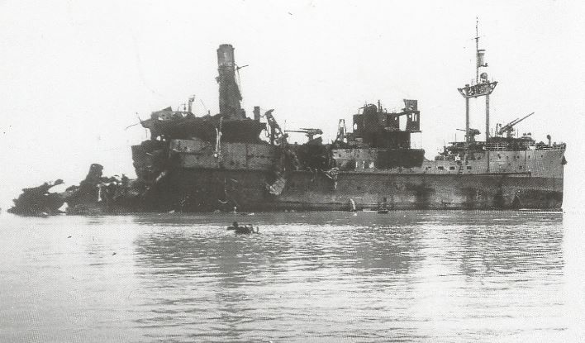 The Cérons after the explosion
The Cérons after the explosion
Anonymous barge
“Considering the presence of historical explosive devices around and in the wreck of a transport barge located off Dieppe at position 49°55.9 N – 001°01.8 E (WGS 84 degrees, minutes, decimals); considering that these devices require neutralization” a temporary ban on scuba diving, navigation, fishing, dredging, trawling within a 50 m radius has been created by order of the maritime prefect since July 18, 2014.
UJ 1404, ex-UJ 128, ex-Franken
This ex-fishing boat was launched on November 6, 1936. With a length of 54.1m, she was built by the Norderwerft Köser & Mayer yard in Hamburg. Her home port was Cuxhaven. Under the name of UJ 128, in 1940 she achieved the feat of towing a British submarine damaged in the Kattegat Strait to the port of Frederikshavn. Renamed UJ 1404, she was tasked with escorting German supply convoys and guarding submarine bases, along with 6 ex-whale catchers that had swapped harpoons for guns. She is based in Lorient. Dubbed a submarine hunter, the UJ 1404 is more a submarine harasser than a hunter. Half spy, half troublemaker, she lays depth charges on the supposed trajectories of British submarines. She was sunk on August 19, 1942 during Operation Jubilee. Her presence in this theater of war is unexplained. 26 shells and 3 anti-submarine grenades extracted from her cargo were fired on March 8 and 9, 2022. It is a question as to how many are left?
Gauss (Sperrbrecher 178)
German cargo ship, 70.9 m long, built in Kiel, Germany, launched in 1925, requisitioned by the Kriegsmarine in 1942, became the Sperrbrecher 178, a deminer equipped with a large copper coil which, thanks to her magnetic field, detonated magnetic bottom mines in advance (before the ship’s passage) and an acoustic anti-mine noisemaker. The convoy to which she belonged, leaving Boulogne-sur-Mer and heading for Royan to protect U-boats, was attacked by the British fleet on December 12, 1942. She sank with 99 dead, only 3 sailors surviving.
Despite salvage operations by scrap dealers, collectors and, hopefully, deminers, the ammunition hold still contains crates of shells and loose shells. The wreck is very popular with French and English divers.
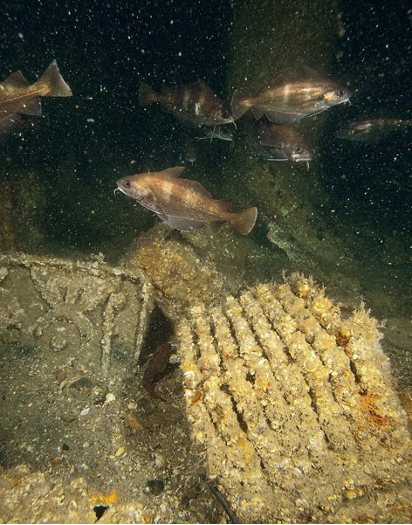 Gauss anti-aircraft ammunition © Divernet
Gauss anti-aircraft ammunition © Divernet
HEALTH AND ENVIRONMENTAL RISKS
The immediate effects of the detonation of shells, bombs, mines and other ammunitions voluntarily destroyed at sea by the Cherbourg GPD (Mine Clearance Divers’ Group) under the responsibility of the Maritime Prefect for the Channel and North Sea:
Blasting creates underwater craters, suspends a turbid mixture of sediment and blast residue, and disperses metallic macro-waste. Bomb holes in the seabed devastate biodiversity. Fixed benthic organisms and crustaceans are sacrificed. Explosive masses deliberately detonated are military-industrial waste products that are carcinogenic, mutagenic, toxic to reproduction, and endocrine-disrupting.
The OSPAR Convention on the Protection of the North-East Atlantic, to which Robin des Bois is an observer, reports in its position paper on sunken ammunitions (see p. 22) that porpoises have been killed within a 4 km radius of blasted bombs, and suffered permanent hearing damage within a 30 km radius. In Scotland, the report published by the Department of the Environment in 2015 states that the destruction of 3 bombs caused the stranding and death of 19 pilot whales in 2011.
In France, the September 2010 standing instruction on “Safety of underwater blasting worksites” stipulates that “specific measures must be sought to reduce the impact of an explosion on the environment, particularly on flora and fauna“. In particular, it recommends that ammunitions be detonated far from fish-filled waters and migratory species passage zones, and that all sectors affected by biodiversity preservation measures (Natura 2000 at sea, natural marine parks) be avoided.
The joint document from the French Ministry of Defense and the French Marine Protected Areas Agency, published in January, 2014 (only in French) mentions the physical pressures that the blast’s shockwaves put on “any marine animal”. They can go so far as to cause immediate or delayed mortality or altered behavior. To reduce mortality and damage to the seabed, the French Navy in some cases uses “under-barrel” blasting: the bombs, shells or mines to be destroyed are attached to a float on the surface, and the explosion takes place in the water column. To reduce the mortality of fish and marine mammals, the GPD can also carry out gradual acoustic scaring, which is supposed to scare them away. It’s not certain that this method will be effective for marine wildlife, which is already subject to a superimposition of anthropogenic noises and echoes. Between frightening and disorienting, the faux pas is quickly crossed.
In some cases, where the ammunition is too dangerous to be transported, deminers use the cliffs as protective screens, absorbing some of the energy, metal splinters and flames. These traumas micro-crack the cliffs, encouraging rockslides and rockfalls.
When close to deep waters, the maritime prefect may choose to replace the blasting with “oceanization”, i.e. dumping.
Long-term effects of the disintegration of abandoned munitions and wrecks of ships carrying munitions cargoes:
The degradation of explosive materials is the main source of pollution from conventional warheads, and the slow disintegration of metal shells, which lose 1mm of thickness every year due to corrosion.
In its first inventory published on November 1, 2003 (only in French), Robin des Bois noted that the explosive materials in conventional munitions degrade into DNOC (DiNitroOrthoCresol), a toxic herbicide known since 1930 and banned in Europe since 2000.
On November 11, 2003, Robin des Bois published its press release “No Armistice for War Remnants”.
In its 2nd inventory published on June 1, 2004 (only in French), Robin des Bois persists: “Swastikased, bombed, armored, concreted, heavily occupied, in the process of being liberated and rebombed, Normandy, 60 years after the landing of Allied forces and the withdrawal of German forces, retains in dunes, mudflats, cliffs and caves, soils and undergrounds, abandoned UXOs threatening public safety and polluting the environment.” “At sea or on land, dumps of conventional remnants of war are sources of pollution.”
In its 6th inventory published on August 31, 2012, Robin des Bois states that degraded and rusted munitions contain explosives or explosive residues such as trinitrotoluene (TNT), dinitronaphthalene and trinitrophenol or picric acid, and that they release toxic, ecotoxic, herbicidal, insecticidal and biocidal substances into the environment.
In its 7th inventory published on June 2, 2014, Robin des Bois reiterates that the main explosives in conventional ammunitions used during the First and Second World Wars by-produce persistent, soluble and undesirable toxic substances in Water Intended for Human Consumption (EDCH) during their deflagration or degradation. The NGO points out that levels of perchlorate have been detected in the north and east of France in drinking water and, as a precautionary measure, prefectures recommend that pregnant and breast-feeding women should not drink tap water, and that parents should not prepare baby bottles with tap water for babies under 6 months. These recommendations are still in effect.
In 2016, Robin des Bois devoted the first 3 chapters of the Atlas de la France toxique published by Arthaud to war waste, underwater munitions dumps and wrecks containing munitions. These 3 chapters include the polluted Place à gaz site 15 km from Verdun, the tragedy on the island of Groix in September 2014 that left 1 dead and 9 injured, perchlorates in tap water in northern and eastern France, and an inventory of underwater munitions dumps on the Atlantic coast and in the Mediterranean (map visible below).
In March 2023, the Anses (French Agency for Food, Environmental and Occupational Health and Safety) exploratory campaign confirmed the emergence of toxic residues of military explosives in water intended for human consumption (EDCH) in the north-east of France, which was devastated by the First World War. In connection with ammonium perchlorates, the most quantified molecules are Dinitrotoluenes 2,4 and 2,6 classified as CMR (Carcinogenic, Mutagenic, Reprotoxic) and possibly carcinogenic TNT metabolites. The Anses has also detected traces of RDX in some EDCH samples. RDX is stable in the environment and a possible carcinogen. Its primary target in living organisms is the nervous system. It is absorbed by plants grown in contaminated soil.
These successive pieces of information are consolidated by Vert de rage (Green with rage) in its gripping documentary “Ammunition, the toxic legacy”, broadcast Monday May 27 on France 5.
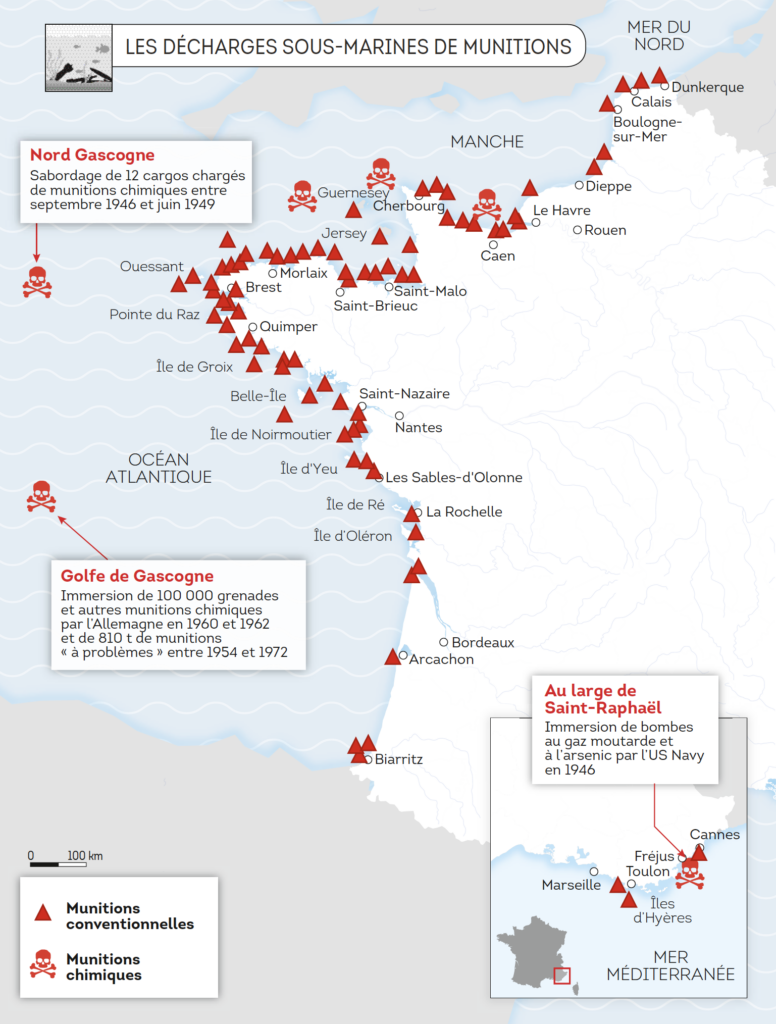 Underwater munitions dumps
Underwater munitions dumps
© Atlas de la France Toxique, Robin des Bois, éditions Arthaud, 2016
Translation of the map
North Gascony
Scuttling of 12 cargo ships loaded with chemical munitions between September 1946 and June 1949
Bay of Biscay
Dumping of 100,000 grenades and other chemical munitions by Germany in 1960 and 1962 and 810 tonnes of “problem” munitions between 1954 and 1972
Off the coast of Saint-Raphaël
Immersion of mustard gas bombs by the US Navy in 1946
CLASSIFIED POLLUTION
Articles L.124-1 to L.124-8 of the French Environmental Code guarantee citizens’ right of access to environmental information. Documents the consultation or communication of which would infringe national defense secrets are excluded from this right to information. The French government is abusing this exceptional regime to apply it to underwater and land-based dumps of historic conventional or chemical munitions and their trail of pollutants. The inventory of sites and the studies carried out by the French government on the contamination of water, sediments, fauna and flora by the degradation products of historic munitions are classified as defense secrets, in the same way as nuclear warheads. The general public is officially informed of the risks in the event of a health crisis, such as the contamination of groundwater by perchlorates from First World War ammunitions in the Hauts-de-France and Grand Est regions.
The story of a great cover-up
In 1999, the draft law in the search for, neutralization, removal and destruction of explosives, ammunitions, war materials and devices, signed by 59 deputies and registered with the presidency of the National Assembly on April 28, 1999, was ambitious, well-intentioned and, in a way, revolutionary. This is undoubtedly why it did not make it through the legislative process. It got bogged down in a preliminary committee. It rightly encompassed the remnants of the wars of 1870, 14-18 and 39-45. It was intended to establish a genuine public health policy by drawing up a national inventory of the most endangered communes and implementing a systematic national policy of defusing, removal and destruction. In addition, it advocated a sort of merger between the deminers of the Sécurité Civile (Civil Security) under the authority of the Ministry of the Interior and the mine clearance divers under the authority of the Ministry of Defence. Article 5 stipulated that in municipalities known to have been the target or site of munitions, any authorisation for work requiring excavation of the ground and undertaken by a private or public person would be subject to prior search for abandoned engines of war likely to be buried in the land concerned. Articles 1 to 4 provided for a circular to be sent to all mayors in France to identify priority municipalities, neighbourhoods and sectors by 31 December 2005 at the latest. Five years to arrive at credible and reliable results thanks to the archives of the allied and German forces, the communes and local historians seemed perfectly reasonable.
In 2003, the OSPAR Convention for the Protection of the North-East Atlantic, of which France is a member, established a framework for reporting “encounters” with submerged conventional or chemical ammunitions. Even today, it is thanks to this international commitment by France that the Ministry of Ecology obtains some information from the Ministry of the Armed Forces on wartime waste found at sea and on the foreshore. Otherwise, the Ministry of Ecology is mainly consulted when it comes to contributing financially, via Ademe (Agency for the Environment and Energy Management), to the clean-up of land sites contaminated by ammunition dumping grounds.
In 2008, law no. 2008-696 of July 15, 2008 on archives stipulates that ” public archives may not be consulted if their disclosure is likely to result in the dissemination of information enabling the design, manufacture use or location of nuclear weapons, chemical weapons or any other weapons with direct or indirect destructive effects of a similar level.” Prior to this reform, information relating to State security and defense was was incommunicable for 60 years. Robin des Bois alerted members of parliament of this threat to the safety and security of future generations future generations, to the regulatory corpus on polluted sites and to the the Convention on the Prohibition of the Development, Production Convention on the Prohibition of the Development, Production, Stockpiling and Use of Chemical Weapons and on their Destruction. See May 13, 2008, “Lettre ouverte sur un secret” (only in French).
In 2009, a breach in this law of silence seems to be opening up in the maritime sector. During the “Grenelle of the Sea”, Robin des Bois’ proposal to consolidate inventories of underwater chemical munitions dumps, to assess their dangerousness and to establish priorities for carrying out analyses on sedentary fauna and flora and sediments was accepted by Jean-Louis Borloo, Minister of State, Minister of Ecology, Energy, Sustainable Development and the Sea, and all stakeholders. It was included in commitment 94.d of the “Grenelle of the Sea” law (see the Blue Book of the Grenelle of the Sea) and then buried.
In 2021, the European Commission awarded ICF a contract to carry out a survey of “unexploded underwater ordnance” in all EU maritime countries. One of the aims of this study is to map existing unexploded ordnance, both conventional and chemical. For France, the map published in this report is that of the Atlas de la France Toxique.
In May 2023, Mr. Hervé Berville (Secretary of State for the Sea and Biodiversity) and the General Secretariat for the Sea attended a meeting of the National Council for the Sea and Coastal Areas (CNML). Robin des Bois proposed the inclusion in the National Strategy for the Sea and Coastline of an action aimed at “taking action against underwater dumping of ammunitions and shipwrecks containing hazardous materials“. This proposal was unanimously accepted. This was without counting on the delayed maneuvers of the General Secretariat for the Sea under the authority of the Prime Minister and is responsible for coordinating government action at sea, particularly that of the maritime prefects. The General Secretariat for the Sea intervened after the meeting to strike out this commitment on the grounds that “the SNML is not the appropriate framework for military matters”. Questioned by the newspaper Le Parisien on August 27, 2023, the SG mer indicated that “studies and map updates are being undertaken by the ministries concerned. This interministerial follow-up is part of a long-term approach, and the information resulting from these studies is not intended to be made public“. Robin des Bois has been aware for several years that the CEDRE (Centre of Documentation, Research and Experimentation on Accidental Water Pollution), commissioned by the authorities, has identified around ten dangerous wrecks on the French coast. IFREMER (French Research Institute for Exploitation of the Sea) has also been commissioned to work on the corrosion of old engines of war. This information is classified as a defense secret.
In 2024, on April 12, Robin des Bois wrote to the Prime Minister, the Secretary General for Defense and National Security and the Secretary of State for the Sea and Biodiversity, asking once again for an inventory of known sites where chemical and conventional ammunitions have been dumped in bulk or in wrecks, and for reports, scientific studies or analyses of environmental contamination. Unsurprisingly, this letter has so far gone unanswered.
The post-war decision to dispose of all unused or expired ammunitions at sea or in lakes was based on the need to free the land of this burden, and on the belief at the time that ammunition would be definitively isolated and neutralized by a water barrier. Today, this option is proving disastrous for the environment and for economic and tourist activities. 106 years after the First World War and 80 years after the Second World War, France is still stubbornly holding to an indefensible position. It is not in line with history and international cooperation efforts to find common solutions for inventorying sites, communicating with civil society, and finding solutions to reduce the health and environmental effects of the inevitable degradation of these ammunitions. Ammunition does not age well, and neither does defense secrecy.
WHAT TO DO AND NOT TO DO
 They’re still killing!
They’re still killing!
Report engines of war to the relevant authorities (Town halls, Gendarmerie, National Forests Office)
Metz mine clearance centre
In all its inventories of abandoned ordnance, Robin des Bois insists on the need and obligation to pursue a proactive policy of physical risk prevention, particularly aimed at children and teenagers in schools. Unfortunately, despite some sporadic and ephemeral advances, this pedagogy has not been adopted as a priority by the Ministry of Education or by war-torn communities. In November 2004, in Grande-Synthe (Nord), a child was killed playing with a 37 mm mortar shell he had found in a hunting hut (See the press release “Les guerres n’ont pas de fin”, November 9, 2004 – only in French). 20 years later, on Sunday April 7, 2024, in Avenay (Calvados), 3 teenagers ages 13 and 14 were injured, one of them seriously, while handling an anti-tank rifle grenade recovered from the banks of the Guigne river, with which they wanted to improvise an Olympic flame. Avenay and the neighboring community of Esquay-Notre-Dame were the scene of clashes between Anglo-Canadian forces seeking to bypass the city of Caen and the Germans of the 9th SS-Panzer-Division. In some cases, the regional press can encourage recklessness. In an article dedicated to the 80th commemoration of the D-Day landings, cordite wicks still found on beaches today are considered an ideal means of lighting barbecues in summer and fireplaces in winter.
War remnants are sought after by collectors, dealers, tinkerers, second-hand dealers and magnet prospectors in cliffs, wrecks, hedgerows and lake and river beds. Since our first inventory in 2003, aberrant behavior has been observed, such as the deliberate dumping of ammunition in waste collection centers, town halls, police and gendarmerie stations. In today’s 9th inventory, the trend continues with an upward curve and a big peak in spring and summer, when tourists strolling along beaches, rocks and cliffs are astonished to discover rusty ammunition and sometimes without taking basic precautions, which they regard as antiques and curiosities. In November 2022, on the beach at Saint-Côme-de-Fresné, a walker picked up and put in his pocket a “pretty pink-red pebble” which a few minutes later was emitting fumaroles. He received second-degree burns from “a stone” of phosphorus that had escaped from a shell (see Saint-Côme-de-Fresné (14). Tuesday, November 1, 2022).
In an attempt to remedy the traffic and lack of awareness of the dangers among some members of the public, prefectures in Normandy have been making communication efforts for some years now:
The Departmental Document on Major Risks (DDRM) for Calvados includes the risk of war engines, accompanied by historical documents, photographs, descriptions of the sanitary and atmospheric effects, and essential postures and reflexes in the event of discovery. “Agricultural work or tilling, soil erosion phenomena or the drying up of rivers uncover old munitions.”
The Eure DDRM cites the risk of “residual weapons of war”, illustrates the point with several photos and stresses that “most accidents occur during digging, pipe laying, construction of foundations or structures, clearing brush or forestry work, during the cleaning of water bodies or rivers, drilling, geophysical and geotechnical studies, archaeological excavations, quarrying“. The Eure prefecture also stresses the dangers and illegality of magnet fishing “even when motivated by a desire to clean up watercourses on a voluntary basis“.
The Manche DDRM has not been updated since 2014. It cites the risk of war machines. “They are all the more dangerous because they are old, weathered and therefore unstable.” “Millions of tons of shells and bombs have fallen on the department and dozens of towns have been almost entirely razed to the ground.” If explosive devices are discovered, the risk can be “explosion due to mishandling, shock or contact with heat, poisoning by inhalation, ingestion or contact, dispersion in the air of particular charges contained in the military munitions (smoke, phosphorus, etc. …).” Nearly 33 tons of explosive devices were “collected” in the department between 2006 and 2012. The prefecture also publishes instructions on its website entitled “You have discovered an explosive device / 2 procedures“ (urgent and normal).
The Orne DDRM was updated in 2023. It includes the risk of war engines between the risk of air pollution and the risk of epizootics. “During the Second World War, Normandy was bombed as early as 1942.” “Experts agree that it will take seven centuries to completely clean up the department.” A photo of a shell discovered in Occagnes in 2022 serves as an illustration. This operation does not appear to have been reported in the press. The Préfecture de l’Orne also publishes instructions on its website entitled “Déminage: que faire en cas de découverte d’un engin explosif?” (“Mine clearance: what should you do if you find an explosive device?”). Among the basic recommendations is to “keep communication about the discovery to a minimum, so as not to attract curious onlookers”.
The Seine-Maritime DDRM is the only one in Normandy to omit the risk of war remnants. However, the prefecture publishes on its website the “Mines, bombs, grenades: cautionary advice“.
At municipal level, the Municipal Information Document on Major Risks (DICRIM) is mandatory for all municipalities exposed to at least one major natural or technological hazard. For those that aren’t, we’d like you to raise your hand and let Robin des Bois know about it, so that we can promote them, at the risk of overpopulation in the medium term. The mission of the DICRIM is to inform permanent and temporary residents of the prevention, protection and safeguard measures put in place with regard to the risk(s) to which the community is exposed. The DICRIMs are the local versions of the Dossiers Départementaux sur les Risques Majeurs (DDRM). For example, in this inventory, the DICRIMs for Sainte-Mère-Eglise, Cherbourg and Avranches in the Manche Department, Ouistreham, Colombelles, Falaise and Caen in the Calvados Department, Rouen, Le Tréport and Dieppe in the Seine-Maritime Department, and Evreux in the Eure Department, all of which are regular subscribers to Robin des Bois inventories, make no mention of the risk of ordnance. On the other hand, Colleville-Montgomery, Courseulles-sur-Mer, Trouville-sur-Mer, Villers-Bocage in Calvados and Le Havre in Seine-Maritime do mention it.
Discovery of a war device at sea
The prefectural order issued by the Maritime Prefect for the Channel and North Sea on February 23, 2007 regulates the disposal of suspicious devices found at sea, and sets out the zones for temporary disposal and neutralization of such devices in the vicinity of the main ports on the Channel and North Sea coast.
Suspect devices are all objects found at sea, submerged or floating, likely to contain dangerous explosive materials, in particular those with the characteristics or appearance of war material (bombs, shells, mines, torpedoes) (article 1). Any ship’s captain or skipper who discovers a suspicious device must report it immediately by VHF 16 to the nearest operational surveillance and rescue center (CROSS), semaphore or harbor master’s office, indicating in particular the nature and description of the war device and the coordinates of its position, the depth of immersion and any impossibility for the crew to throw the device back into the sea (article 2). The coordinates of the 18 temporary dumping zones from Granville to Dunkirk are given (article 3).
Article 4 sets out the procedure to be followed in the event of discovery:
– make every effort to reach one of the temporary storage areas as a matter of priority, and deposit the suspect gear there;
– when the operation to release the gear requires handling deemed dangerous, to reach the nearest temporary storage area and anchor the vessel there until the arrival of a response team;
– if the nearest temporary storage area cannot be reached without risk to the crew or navigation, release the engine of war away from navigation channels and, if possible, in water depths greater than fifteen meters, accurately recording the coordinates of the dumping site;
– if the engine of war has been returned to the water outside a temporary storage area, in water depths of less than fifteen meters, mark the anchorage point and accurately record the coordinates of the immersion site.
Article 5 recalls a number of precautions to be taken “to avoid aggravating the danger”, such as not entering a port with the device on board, keeping away from other vessels and the shoreline, and moving all personnel away from the device.
This last recommendation is unrealistic on a small-scale fishing boat measuring a maximum of twenty meters in length, with the gangway in the middle. Faced with these complications, these sometimes inapplicable instructions, and considering the loss of fishing time, some skippers prefer to put the gear back in the sea, sight unseen. Article 6 of the decree calls for prosecution and penalties (specifically 6 months’ imprisonment and a €3,750 fine, as well as a 2nd class fine of up to €35), while article 7 offers incentivization: a discovery bonus.
Every day in the Bay of Seine, fishermen bring up rusty ammunition that have dispersed their toxic pollution into the environment. In the absence of realistic procedures, they dump them at sea.
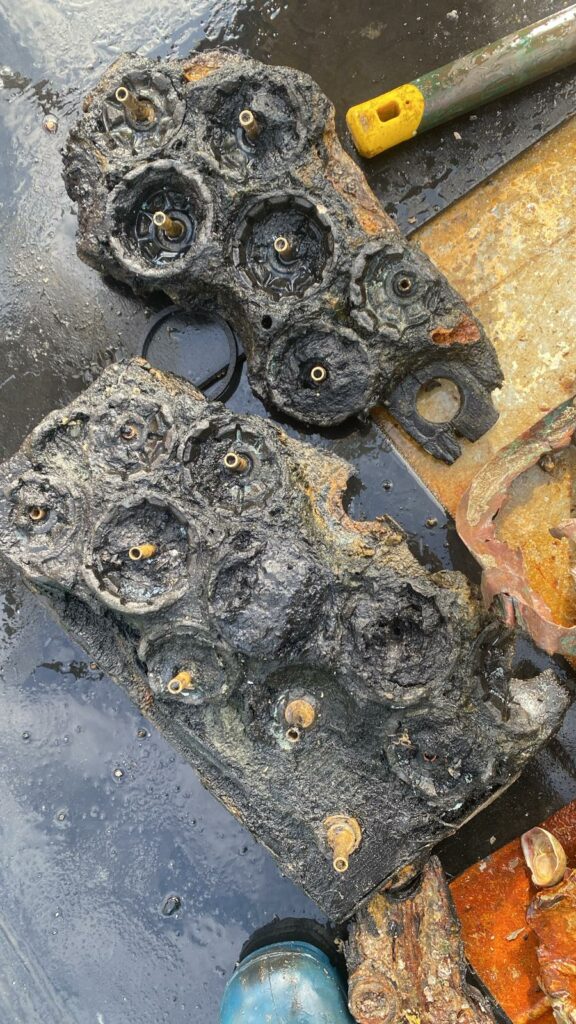 Box of grenades © Robin des Bois
Box of grenades © Robin des Bois
INVENTORY OF THE DISCOVERIES AND DESTRUCTIONS OF
WAR REMAINS FROM JANUARY 1, 2019 TO DECEMBER 31, 2023
IN NORMANDY
1/ ON THE FORESHORE AND OFFSHORE
From 2019 onwards, a cloud of shells falls on the Veulettes-sur-Mer coastline, suddenly transformed into Aveuglettes-sur-Mer due to the mystery surrounding this surge. Several factors may be behind it: the crumbling cliffs and falling ammunition held by German positions along the Atlantic Wall, the scouring and reworking of the seabed for the Etretat-Fécamp offshore wind farm, the stigma of Operation Cycle when 2 British destroyers attempting to exfiltrate French and British soldiers besieged in Veulettes were attacked on June 10 or 11, 1940 by 9 Luftwaffe Stukas. It may also have been a wreck suddenly gutted and releasing its ammunition during a storm near Veulettes, which has since become Veulettes-sur-Mer.
– Thursday, April 18, 2019.
A mortar shell (30 cm long) on the beach. Beaconing while waiting for the GPD (Mine Clearance Divers’ Group) Manche-Mer du Nord based in Cherbourg.
– Friday, July 3 and Saturday July 4, 2020.
Discovery of a 25 cm shell at the foot of the cliff. The gendarmerie is alerted. The following day, 3 other shells are found by the gendarmes and private individuals 300 meters from the beach, in the cliff area.
– Tuesday 14, Wednesday 15 and Thursday 16 July, 2020.
A foreign tourist (English or Dutch, according to sources) discovers 3 shells at the foot of the cliffs in an area off-limits to visitors, brings one 32 cm back to his room in Hautot-l’Auvray (17 km) and informs the gendarmerie. In circumstances that are not explained, this shell has joined the 2 others at the foot of the cliffs.
The next day, the same tourist returned to the beach and found 12 more shells. They have all been blasted on Thursday 16th.
– Monday, August 24, 2020.
A Belgian tourist discovers a dozen shells in an area normally off-limits to the public. The shells were marked out pending the arrival of the bomb disposal squad.
– Friday August 28, 2020.
Discovery of 8 new shells by a “walker”. According to the town hall, “every time, it’s just after a period of high tide. We’re used to it in our region, but it’s true that this time, it’s a lot.” They have been marked out pending the arrival of the bomb squad.
– Thursday, February 4, 2021.
14 shells spotted at the foot of the cliffs by a discoverer of fossils and other geological and pyrotechnical curiosities. The Fécamp Gendarmerie commander counted 11, including 8 measuring 20 cm long and 7 cm in diameter, and 3 measuring 5 cm long and 2 cm in diameter. Hypotheses abound as to whether the shells landed at the foot of the Veulettes-sur-Mer cliffs, arrived by sea after recent storms or unknown events, or fell from the top of the cliffs after mudslides and landslides, but none of them is clear-cut.
– Thursday, February 18, 2021.
16 75 mm shells, 2 40 mm shells and a 270 mm shell (TNT equivalent of 54.4 kg) are fired on the beaches.
– Sunday, June 6, 2021.
During the 77th commemoration of D-Day in Normandy, a shell (10 cm long, 4 cm in diameter) is found on the beach at around 5:10pm. The temperature is 16°C. The beach is crowded. The beach is not evacuated.
– Thursday, June 10, 2021.
School transport suspended, home care postponed, nursery assistance unavailable. All access and exit roads closed. Curfew in Veulettes-sur-Mer (population 280, 10 more in summer holidays). At sea, a Gendarmerie Maritime patrol boat acts as a watchdog. The SNSM (French National Marine Rescue Company) is also mobilized. Three shells, including 2 French ones, 80 cm long, 274 mm in diameter, 152 kg (80 kg of cumulative explosives) will be destroyed on the beach at low tide. The compulsory and imperative sheltering applies to hard buildings. One of the 274 mm shells is near the hamlet of Yaume. The other shell of the same type is near the casino. The command post is in Paluel at Clos des Fées, a residential and cultural park 1,500 meters as the crow flies from the beach at Veulettes-sur-Mer and one kilometer from Paluel’s 4 nuclear reactors. At 7.40 am, the first blast on the beach sent pebbles and shards of rock flying into the air, creating a crater. The 2nd blast followed at 8.41am. The lieutenant in charge of Mine Clearance Divers’ Group operations explained that the ammunition was too dangerous to transport and that there was no other solution than to fire it on the foreshore. The emergency was lifted at around 9:30 am. There was a lot of fog at daybreak. It lifted quickly, allowing operations to proceed within the best timing. Weather conditions are crucial in this type of exercise. That’s why, to be on the safe side, the window for sheltering the population and cordoning off Veulettes-sur-Mer ran from 6:30 am to 1:30 pm.With regard to the proliferation of shells at the foot of the Veulettes-sur-Mer cliffs and on the beach, the naval officer coordinating EOD (Explosive Ordnance Disposal) noted that the 2 large shells that had just been destroyed dated from 1940, were made in France, and recalled that the Germans had sometimes recovered them for use in coastal defense and as part of the Atlantic Wall. “They were hung at the top of cliffs, ready to be dropped vertically on the enemy”.
– Tuesday, July 20, 2021.
A grenade-type explosive was discovered on the beach in a non-swimming area. The community’s technical services seized the rusty device and claimed to have secured it in a sand-filled bin, in flagrant contradiction with the doctrine which reserves such handling for the GPD or the bomb squad of the Caen interdepartmental center. This transgression enabled the mayor of Veulettes-sur-Mer to refrain from issuing a by-law banning people from using the beach while awaiting the intervention of the bomb squad.
– Tuesday, January 11, 2022.
While “walking” between the casino and the very spot where a cliff face collapsed on the night of January 6-7, someone spotted 4 shells of different sizes and alerted the gendarmerie.
– Tuesday, January 25, 2022.
A Veulettes resident defuses a shell (10 cm long, 5 cm in diameter) while gardening. The Saint-Valery-en-Caux gendarmerie brigade marks out the shell until it can be removed by the de-miners.
– Wednesday, February 2, 2022.
A crate with a shell and a rocket near the casino, on the beach, at 8 o’clock in the morning. The gendarmes mark out the area. The bomb squad is informed.
– Thursday, February 24, 2022.
Municipal employees discover 4 explosive devices, including 2 shells, on the beach opposite the casino following storms Eunice on February 18 and Franklin on the night of February 20-21. The perimeter has been secured pending the arrival of the deminers.
– Wednesday, March 16, 2022.
Discovery of a shell at the old boat ramp near the casino.
– Tuesday, August 2, 2022.
Discovery of a 35 cm-long, 10 cm-diameter shell at the foot of the cliff, 150 m from the casino.
– Wednesday, May 24, 2023.
Magnitude 2.8 earthquake identified by the national seismic monitoring network (RéNaSS) as a “military explosion” off Veulettes-sur-Mer. The Préfecture Maritime has not released any information on the nature of the munition fired.
MANCHE DEPARTMENT
2019
– Pirou (50). Wednesday, July 24, 2019.
A shell on the top of the Armanville beach is spotted in the morning at sea level by a passer-by who alerts Madam Mayor, who alerts the technical services and the deminers. They turned up at 3.30pm, and extended the security perimeter with the help of the gendarmerie. The shell was destroyed on site under a bed of sand.
– Réville (50). Thursday, August 15, 2019.
Holidaymakers discover a shell nest on Dranguet beach. A 150-meter security perimeter is set up by the gendarmerie. Mine clearance divers are expected to arrive in the evening and will decide whether to take charge of them or fire them on the spot.
2020
– Off Saint-Vaast-la-Hougue (50). Sunday January 19 and Tuesday January 21, 2020.
The Stenaca II is fishing 6 nautical miles (11 km) east of Saint-Vaast when it picks up a German BM 1000 mine (871 kg TNT equivalent). The CROSS is alerted, and the Caiman helicopter is deployed, with 3 members of the GPD directly hoisted aboard. The weather was poor and the bomb was released. An urgent notice to mariners is issued. The bomb is blasted two days later.
– Off Cherbourg (50). Wednesday January 22 and Thursday January 23, 2020.
Detection in 25 m of water 2 nautical miles (3.7 km) from the entrance to the Cherbourg passes of 2 British Mark IX mines (600 kg of TNT equivalent) and blasting by CMT (tripartite class mine-hunter) Céphée clearance divers.
– Réville (50). Thursday May 14 and Friday May 15, 2020.
On the beach, destruction of 3 60 mm mortars, 5 40 mm shells and 2 4.7 cm shells containing a total of 2.7 kg TNT equivalent by clearance divers from Cherbourg.
– Off Cap Lévi (50). Thursday June 4 – Sunday June 7, 2020.
Thursday June 4, discovery by the Andromeda in 44 m of water of a LMB 1 nautical mile (1.850 km) off Cap Lévi. It was fired upon on June 7.
– Cherbourg harbor (50). Wednesday, July 1 – Thursday, July 30, 2020.
An inspection of the Fort de l’Est in Cherbourg harbor, owned by the French Ministry of the Armed Forces, led to the discovery of 5 100 mm shells, one of which was stuck in a concrete block. These were destroyed a month later. The captive shell was blown up on site, the other 4 at sea. On July 27, the Préfet Maritime de la Manche et de la Mer du Nord issued an order “temporarily prohibiting the navigation, parking and anchoring of vessels, devices and boats, as well as fishing, swimming, scuba diving and all nautical activities in the vicinity of the Fort de l’Est in the Grande Rade de Cherbourg during operations to neutralize and destroy explosive devices”. The perimeter prohibited from 11 a.m. to 2 p.m. extended to a 600 m radius around the fort (see the order).
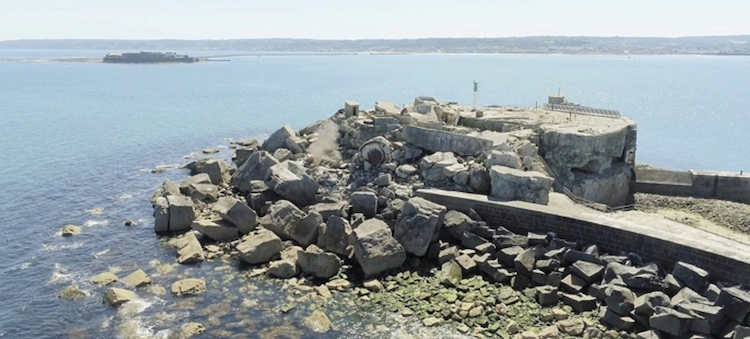 © Préfecture maritime de la Manche et de la mer du Nord
© Préfecture maritime de la Manche et de la mer du Nord
– Siouville (50). Thursday, August 6, 2020.
Summer visitors discover ammunition on Siouville beach at around 4pm, near a collapsed blockhouse. The clearance divers quickly intervene. After moving 30 beach-goers, they fired the 81 mm shell on the spot.
– Off Cherbourg (50). Wednesday August 12, 2020 – Sunday August 16, 2020.
Discovery by the CMT Sagittaire of a German TMC bottom mine (1250 kg TNT equivalent) and blasting about 8 nautical miles (15 km) north of Cherbourg 4 days later.
– Off Cherbourg (50). Tuesday, August 18, 2020.
Detection and blasting of 2 English Mark mines (600 kg TNT equivalent).
– Biville-sur-Mer (50). Friday August 28, 2020.
Discovery of a shell in the dunes near the wreckage of a tank at Le Camp des soldats (soldier camp/base).
 Church of Biville-sur-Mer. Philippe Corvé www.normandie44lamemoire.com.
Church of Biville-sur-Mer. Philippe Corvé www.normandie44lamemoire.com.
– Mont-Saint-Michel (50). Saturday, August 29, 2020.
Location of a shell (approx. 20 cm long) rolled by the tide at the foot of a granite spur offering a panoramic view of the Bay of Mont-Saint-Michel. Deminers expected.
2021
– Urville-Nacqueville (50). Monday, January 11, 2021.
Destruction by French Navy clearance divers of a defensive grenade containing 100 grams of TNT equivalent.
– Saint-Vaast-la-Hougue (50). Sunday, February 14, 2021.
“We’re still surprised to find ammunition and explosives 80 years later.” The 2 17-year-old shore fishing women can’t believe they’ve stumbled across a shell, even though they live in Saint-Vaast-la-Hougue and last year found 2 machine-gun bullets among the periwinkle rocks. A photo was sent to Marjorie’s father, who confirmed without appeal that the war relic was dangerous. Shore fishing can hold some nasty surprises.
– Héauville (50). Saturday March 27 and Thursday April 1, 2021.
A shell found on the beach was blown up at low tide by the French Navy’s deminers, after the foreshore had been made safe before the blasting. “We often find explosive devices on our beaches. Each time, we call in the bomb squad to neutralize them” says the mayor.
– Siouville-Hague (50). End of March, 2021.
Discovery of a shell on the beach halfway between the Flamanville nuclear reactors and the atomic plant on the La Hague peninsula. The shell, visible at low tide and submerged at high tide, was marked out pending imminent intervention by the GPD.
– Blainville-sur-Mer (50). Monday, May 10 and Monday, May 17, 2021.
– On Monday, May 10, a presumed World War II bomb was spotted by a hiker on the beach at the foot of the dune near Le Grand Hébert restaurant and campsite. It had rolled ashore, pushed by the storm.
– On Monday May 17, the Caen bomb disposal unit was on site in the safety zone set up by the gendarmerie. According to the deputy mayor, the bomb turned out to be an old pig mould “in the shape of a radish” that had once held a buoy marking a shoal of scallops.
– Mont-Saint-Michel (50). Friday, May 14, 2021.
Discovery of a shell inside the Fanils during roof and facing renovation work. According to the mayor of Mont-Saint-Michel (30 inhabitants and 3 million visitors a year), the deminers won’t arrive until next week.
– Pirou (50). Tuesday, June 8, 2021.
At the bottom of the dunes, within a safety perimeter, the GPD is busy deactivating a 75 mm shell containing 0.7 kg of explosives found in the ponds and pebbles.
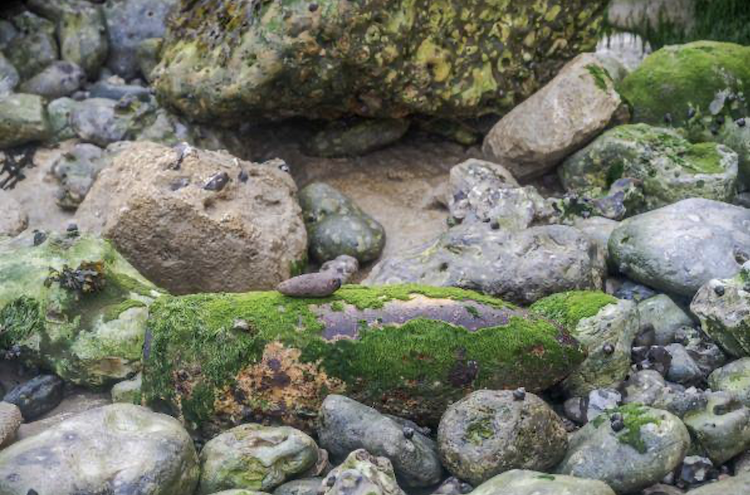 © Préfecture maritime de la Manche et de la mer du Nord
© Préfecture maritime de la Manche et de la mer du Nord
– Nez de Jobourg (50). Wednesday August 11 and Friday August 27, 2021
Discovery of a 155 mm shell on the 11th, and shelling by the GPD on the 27th at the same time as a 75 mm shell spotted nearby.
– Réville (50). Friday, August 27, 2021.
The beach at Dranguet smokes, wisps of light flash across the sea. Réville used to be a center for collecting and clearing ammunitions collected after the war in the bunkers and in the bocage. Since then, the seabed in front of Réville and neighboring coastal villages has been spewing out phosphorus shells and residues, which ignite on contact with the air, releasing toxic, incapacitating fumes. A cohort of phosphorus shells landed on the beach at the end of August, and it has been closed to the public ever since. By the end of September, the situation had come to a standstill. “We’re waiting for the de-miners to propose a removal date,” says the mayor, vaguely fatalistic. At the end of August, he was still hopeful that the deminers would pass by soon.
– Ravenoville (50). Thursday, September 16, 2021.
“Road mission” for the Mine Clearance Divers’ Group: countermeasuring an 80 mm mortar projectile, 900 grams of explosive.
– Off Querqueville (50). Thursday, November 18, 2021.
What was that explosion heard near Cherbourg? La Presse de la Manche asks and finds the answer. The seismographs were in an uproar when Mine Clearance Divers from the CMT Croix du Sud detonated an English Mark V mine containing 300 kg of TNT equivalent.
2022
– Off the coast of Cherbourg (50). Thursday May 5 and Friday May 6, Monday May 9, 2022.
Detection by the CMT L‘Aigle and blasting of an English mine (600 kg TNT equivalent) and a German bomb (130 kg TNT equivalent). The English mine was too close to the port and town to be destroyed in proximity. It was therefore moved some 2 km out to sea by means of an inflated “cow”, a kind of parachute lift. Ouest-France reassures us: “The device exploded in a dedicated area, with no risk to fauna, frightened off, and flora or civilians, bathers or yachtsmen.” Frightened or shredded?
– Off the Chausey Islands (50). Tuesday, May 24, 2022.
Reeled in by a fisherman, the shell was returned to the water and its location transmitted to the authorities. It was destroyed by clearance divers.
– Donville-les-Bains (50). Tuesday, May 24, 2022.
A 30-meter-high spray of sand erupted from the foreshore when the bomb disposal team, using 500 grams of plastic, detonated the 2 shells discovered at the foot of the Lude cliff and in the riprap of the swimming pool at the beginning of May, with a loud bang, far from hikers, windsurfers and kite flyers. To reduce the risk to public safety, the 2 shells were transported away from residential areas between the Ermitage and Bréville-sur-Mer beaches. Operations at the Bréville airfield were briefly suspended.
– Réville (50). Monday, August 1, 2022.
The presumed shell discovered by 2 friends walking on the Loge beach was photographed by them. They sent the photo to the mayor, who informed the gendarmes. Pending the arrival of the clearance divers, the suspected pyrotechnic waste has been placed under the surveillance of local residents.
– Granville (50). Early September, 2022.
In a beach bin, amid oyster shells, mussel shells and banana peels, lies the ogive of a shell (5 cm in diameter) picked up and thrown into the garbage by a shore fisherman, dog walker or other beach user. The bomb squad was alerted.
– Donville-les-Bains (50). Wednesday 21st and Monday 26th September, 2022.
– Another 75 mm shell at the foot of the Pointe du Lude. It was rescued from oblivion by a shell hunter and metal detection expert.
– The shell was fired at low tide by the Cherbourg-based Manche clearance divers.
2023
– Bay of Seine (76-14-50). Monday 9 – Friday 13 October, 2023.
Annual NATO operation HOD (Historical Ordnance Disposal) led by the Standing Nato Mine Countermeasures Group 1 (SNMCMG 1). This year, 7 ships were involved: ORP Czernicki (Poland, in command), BNS Crocus (Belgium), HMCS Summerside and Shawinigan (Canada), HNLMS Vlaardingen and Zierikzee (Netherlands) and CMT Aigle (France). Approximately 65km2 were inspected with the help of Polish and Dutch ROVs and 2 German LMB mines were blasted (1300 kg TNT equivalent).
– Port-Bail-sur-Mer (50). Thursday April 6 and Tuesday April 18, 2023.
After the storm, members of the Port-Bail-sur-Mer 1944 association explored the foreshore and rocky outcrops and discovered a large beached bomb which, after expert examination, was identified as an AN-M64. In very good condition, with no animal or plant colonization, as if its hull had a repellent effect, it was first stripped of its firing systems on April 6 by the GPD, then destroyed on the 18th “after 2 unsuccessful attempts“, according to La Manche Libre. Around twenty residents of the la Valette street were evacuated and access roads closed.
– Le Rozel (50). Saturday 15th and Monday 17th April, 2023.
– Children discovered a bomb of American origin at the foot of a cliff on Le Rozel beach, near the Flamanville nuclear power plant. It was first marked out by the gendarmerie. A security perimeter was set up.
– The Manche GPD responded mid-afternoon on Monday April 17. “Every year, between 500 and 600 ammunitions are destroyed on the Channel coast, between Dunkirk and Mont-Saint-Michel.”
– Off Cherbourg (50). Mid-May, 2023.
A munition of an unspecified nature, with a TNT equivalent of 1122 kg, is detected and exploded by clearance divers from the CMT Croix du Sud. It was probably a German TMC type mine.
– Réville (50). Wednesday, May 24, 2023.
Flammeroles were emerging from the riprap protecting the coastline, the rising tide extinguished them, the falling tide rekindled them. On contact with the air, the phosphorus from the shells reappeared. A free spectacle that the people of Révillais are wary of, but which can lure Parisians and other tourists. At 8 p.m., access to Dranguet beach was blocked and the GPD de la Manche, based in Cherbourg, intervened to neutralize and remove the phosphorus shell(s). Local residents were evacuated and were able to return to their homes by midnight.
– Chausey Archipelago (50). Thursday, August 24, 2023.
A 12.7-calibre machine-gun ammunition found by a private individual is placed in a safe place by the de-miners. On the night of March 8-9, 1945, the Chausey lighthouse and its outbuildings were attacked by the German Navy and partially destroyed by shells and machine-gun fire.
CALVADOS DEPARTMENT
2019
– Off Ouistreham (14). Thursday, April 18, 2019.
All hell breaks loose on board the Tangaroa. A German bomb weighing almost a ton is hoisted onto the deck of the fishing boat. It’s probably an SC or PC series bomb loaded with at least 530 kg of explosive mass. The Centre Régional Opérationnel de Surveillance et de Sauvetage (CROSS) de Jobourg was alerted. Five mine-clearing divers were airlifted from Cherbourg by the Caïman and winched aboard the SNSM Ouistreham Sainte Anne des Flots all-weather boat. The bomb disposal team took possession of the Tangaroa and the fishermen were evacuated by the Sainte Anne des Flots. Initially, the bomb was returned to the water and located for further counter-mining. The Préfecture Maritime de la Manche et de la Mer du Nord reminds us of the right reflexes and the wrong one: “Releasing a historic device into the water without consulting the maritime authorities represents a significant risk, not only for the fishing boat crew, but also for the sailors who may in turn trawl this same device.”
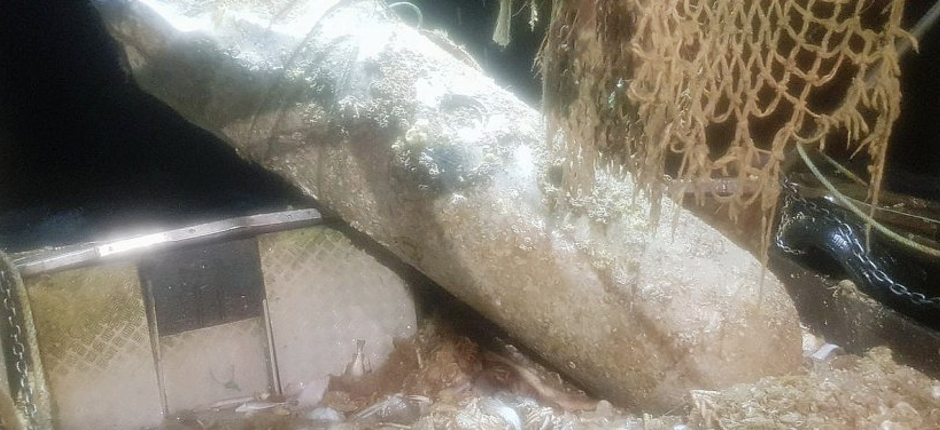 © Préfecture maritime de la Manche et de la mer du Nord
© Préfecture maritime de la Manche et de la mer du Nord
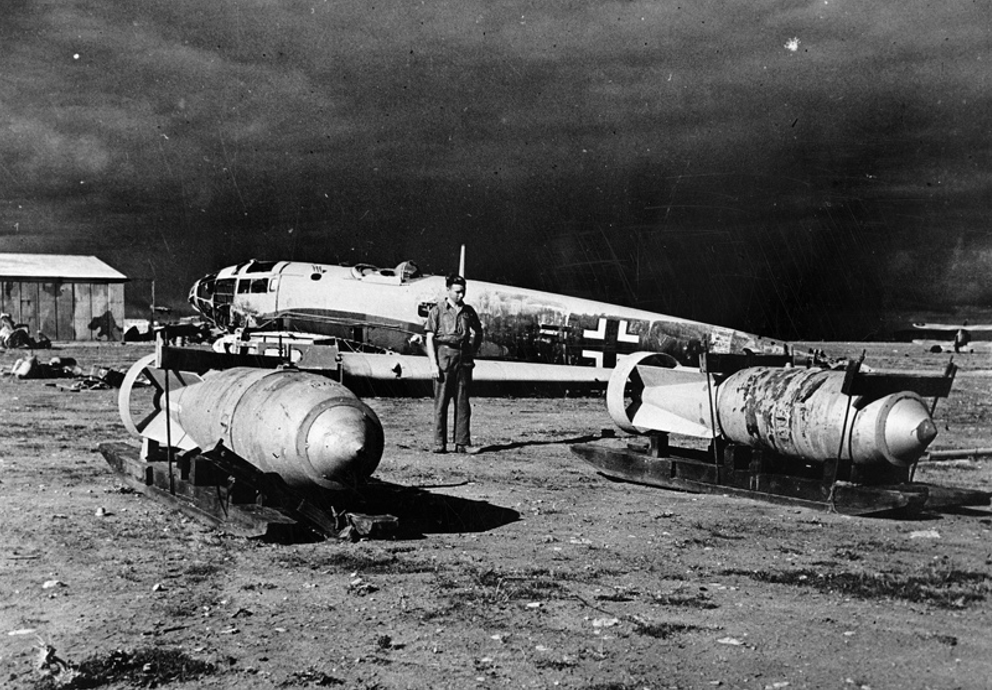 Two SC 1000 bombs in front of a bomber, 1943
Two SC 1000 bombs in front of a bomber, 1943
– Bernières-sur-Mer (14). Friday April 19 and Sunday April 21, 2019.
High tides with coefficients in excess of 100 are often an opportunity for anglers and other beach users to spot species other than crustaceans, in this case 4 shells and a case of ammunition which are being taken care of by the Cherbourg GPD.
– Saint-Laurent-sur-Mer (14). Tuesday, June 18, 2019.
A child from Mantes-la-Jolie near Paris on a school trip picks up a pretty, slightly red stone under the small waves at 2:20 pm, and immediately afterwards the stone is completely red. It burst into flames and smoked. It was a fragment of a phosphorus shell which the child hastily disposed of and which exploded. “Evacuated by the fire department to Bayeux hospital, the little victim of the 1944 D-Day landings on Omaha Beach is said to have suffered only superficial burns to one hand and her thighs.”
– Off Courseulles-sur-Mer (14). July 15- 25, 2019.
During the week of July 15, a trawler brings up old ammunition and immediately returns it to the water, notifying the authorities of the location of the re-immersion less than 2 miles from the coast (3.7 km). On Thursday July 25, the GPD explodes the German torpedo head (300 kg of TNT equivalent).
– Blonville-sur-Mer (14). Thursday, August 29, 2019.
Lifeguards spot a Rommel asparagus on the beach. Bomb disposal services intervene. The asparagus was not armed. Rommel asparagus are concrete blocks that are often booby-trapped. Responsible for defending the Atlantic Wall, Field Marshal Rommel placed obstacles on beaches and backwaters designed to prevent landings, destroy equipment and “annihilate the troops” of the Allies. These included concrete defense blocks that could contain mines. These exploded on contact with tanks, barges and ships. The concrete envelope around the mine could also be booby-trapped by large-calibre shells or other munitions.
– Off Ouistreham (14). Wednesday 20- Thursday 21 November, 2019.
Intervention by Vulcain clearance divers on the wreck of HMS Magic, extraction, removal and blasting of 28 artillery shells (34 kg TNT equivalent). Cf. 34 underwater military wrecks or wastelands.
2020
– Tracy-sur-Mer (14). Friday, January 24, 2020.
Neutralization of a shell on the beach (600 g TNT equivalent) by the GPD de la Manche.
– Off Courseulles-sur-Mer (14). Tuesday April 28 and Sunday May 3, 2020.
Under-mining, i.e. explosion, i.e. blasting, of a German bottom mine (830 kg TNT equivalent) detected on April 28 at a depth of 34 m 8.5 nautical miles (16 km) from Courseulles-sur-Mer by the CMT Cassiopée.
– Colleville-Montgomery (14). Sunday, May 17, 2020.
A damaged shell on the beach at Colleville-Montgomery is reported to the gendarmerie and the prefecture. On analysis, “the object would not present any immediate danger.” It was quickly covered by the rising tide. Clearance divers are expected on site on Tuesday for a thorough examination and, if necessary, to carry out a blasting.
– Ver-sur-Mer (14). Tuesday August 11 and Friday August 14, 2020.
Access to Gold Beach had been prohibited by municipal by-law since Tuesday. A rescue swimmer had spotted a grenade on the foreshore. The Cherbourg clearance divers intervened on Friday. The blue-flagged device contained 50 grams of explosive. It was buried under a pile of sand before being detonated by remote control. The bomb squad, the mayor and his deputy in charge of beach safety then returned to the first-aid post at the top of the beach. “There is always a risk of splinters being projected after the blast,” says Lieutenant Geoffroy, masked as he must be to avoid infectious projections of the Covid-19 virus.
2021
– Ver-sur-Mer (14). Saturday, January 2, 2021.
At 7am during low tide, so-called “walkers”, in fact fishermen on foot raiding the foreshore, discovered a shell.
The Ver-sur-Mer British Memorial was inaugurated on June 6, 2021, with the foundation stone laid on June 6, 2019. Its mission is to honor those from 30 countries who lost their lives under British command during the Normandy campaign. The memorial will welcome King Charles on June 6, 2024, for the ceremony commemorating the 80th anniversary of D-Day.
– Colleville-sur-Mer (14). Saturday, January 2, 2021.
At 7 a.m. during low tide, another group of so-called “walkers” – in fact, fishermen on foot raiding the foreshore – discover a shell.
– Graye-sur-Mer (14). Friday, February 19, 2021.
On the beach, the Mine Clearance Divers’ Group destroys a 40 mm shell containing 178 grams of explosive, enough to cut oneself into pieces. A security perimeter is set up. Graye-sur-Mer is adjacent to Courseulles.
In 2020, 489 devices were destroyed on the foreshore and at sea (33,947 kg TNT equivalent).
– Colleville-Montgomery (14). Wednesday, March 24, 2021.
A shell on the beach. Reported by a user. The clearance divers will intervene “shortly.”
– Grandcamp-Maisy (14). Sunday, April 25, 2021.
A beach surveyor reported 3 shells between Grandcamp-Maisy and Pointe du Hoc. Demining services will intervene “in the coming days“.
– Arromanches-les-Bains (14). Tuesday May 11, 2021.
A phosphorus munition resurfaces on the landmark beach of the Allied landings. The municipal police and gendarmes set up an emergency security perimeter. The device was destroyed on site by experts in the late afternoon.
– Off the coast of Ouistreham (14). Saturday May 29 and Sunday May 30, 2021.
The trawler Sachal’eo had hauled up a mine. Released 8 nautical miles (14.8 km) north of Ouistreham, its relocation led to the discovery of 2 additional mines. The German LMA and LMB bottom mines were detonated on Saturday (1250 kg TNT equivalent) and the German BM1000 on Sunday (900 kg TNT equivalent).
– Ver-sur-Mer (14). Saturday, June 19, 2021.
Oyster farmers on a mission to collect waste from their own and other sources along the coastline spot 3 shells stuck in the rocks. The gendarmerie is alerted. They decided not to mark the shells and not to evacuate the beach, which was crowded with tourists and locals (partly cloudy sunshine, 21°C at 1 p.m.) to “avoid attracting public attention to the area”.
– Ver-sur-Mer (14). Thursday, July 22, 2021.
A shell on the beach. It was apparently rolled by the ebb tide and deposited in the high water mark. The intervention of the clearance divers is scheduled for the following day.
– Colleville-sur-Mer (14). Thursday, August 12, 2021.
Three shells on the beach. Colonized by shells and rusting, they are melting into the pebbles.
– Luc-sur-Mer (14). Friday, September 10, 2021.
Between 7:30 and 9:30 a.m., the clearance divers destroyed 2 shells found on the beach a few days earlier. To prepare the site and bury the shells under m3 of sand, they were assisted by staff and construction vehicles provided by the town’s technical services (population 3,300).
– Grandcamp-Maisy (14). Wednesday, September 15, 2021.
“Road mission” for the Mine Clearance Divers’ Group: 3 75 mm shells counter-mined in a tire, total explosive load: 3 kg.
– Bernières-sur-Mer (14). Friday 15th and Tuesday 19th October, 2021.
Voluntary destruction of 2 shells on the path of the electrical connection for the Calvados offshore wind farm. Two 90 mm shells, 2 kg of explosives.
– Bernières-sur-Mer (14). Thursday, November 4, 2021.
Wednesday, November 3rd. Notice of voluntary destruction of several shells on Bernières beach bordering Courseulles beach on Thursday November 4 from 3 to 7 pm. “A 500-meter zone will be inaccessible to the public.” “The noise of the blasts could be heard in the surrounding area.” RTE (Transmission System Operator) is cleaning up. Cables between the wind turbines’ offshore substation and the onshore power station are to be laid on neutral ground. The shells are to be grouped together, buried in the sand at low tide and blasted.
– Langrune-sur-Mer (14). December, 2021.
After the high tides at the end of the year, the stirring of the waves and the flow of sand, remnants of war land on the beaches and are sometimes picked up by the curious or by collectors like a certain Franck who has appropriated an English S-10 Avon gas mask and cordite fuses or plates. “When we were kids, we used to find a lot of them. We’d install them in tin cans or aspirin tubes. We’d set them on fire, and they’d make one hell of a rocket!”
The Navy lieutenant second in command of the clearance divers is much less enthusiastic: “These propellant strips were used as combustion to make the shells go off faster. People have been seriously burned using them.”On April 30, 2024, as part of the documentary articles on the 80 years of Liberté 1944-2024, an article in the regional press confirms that cordite fuses are still recoverable on the D-Day beaches, and in particular at Langrune. While stressing that they are not to be placed in every hand, the article doesn’t pull any punches. Defying all recommendations and common sense, it gives advice on how to reactivate them. “When you find them, all you have to do is dry them, light them, and it burns making a big flame.” “For the well-informed adult, wicks or plates can now be used to light barbecues in summer and fireplaces in winter.”
2022
– Longues-sur-Mer (14). Monday January 17 and Monday March 21, 2022.
On Monday January 17, the 27 cm long, 150 kg shell was spotted and reported by “walkers” at the foot of the cliffs, nestling in the pebbles. It was submerged at high tide. The rescue team is due to intervene on Monday, March 21st. 405 residents of Longues-sur-Mer (population 600) will have to leave their homes by 8 a.m. at the latest. “The Commes village hall will be open to evacuated residents who have no other accommodation. Residents, shopkeepers and professionals affected by the evacuation will receive information from the communes of Longues-sur-Mer and Commes explaining the practical details of the operation“, explains the prefecture. Commes’ (450 inhabitants) is next door. The security perimeter will be lifted by 2:30pm at the latest. According to the Calvados prefecture, “the ammunition will be moved and then destroyed at sea off the commune of Longues-sur-Mer.” The captain of the Bayeux gendarmerie explained the day before the operation that “it [the shell] is larger than those usually found“. “The measures taken to ensure the safety of the inhabitants are very substantial, which is not an ordinary situation.” At 7:32pm on Sunday evening, the mayor of Longues-sur-Mer, who had been on pins and needles for several days to organize the exodus of a large number of his constituents and the closure of the school and canteen, was informed by the Courseulles gendarmerie that the operation had been cancelled, without any further details. In the evening, he learned that the shell had “disappeared“. Washed away by the weekend’s high tide, covered by pebbles or even stolen, rumors were rife about the fate of the shell in Longues-sur-Mer and beyond. The prefecture has tried to quell the controversy by assuring us that the shell was buried by a rockslide from the cliff.
– Englesqueville-la-Percée (14). Thursday, February 3 and Tuesday, February 15, 2022.
78 years after the D-Day landings, the Mine Clearance Divers’ Group went foot fishing. They were not looking for vines, they were looking for shells and other war remnants. A total of 246 ammunitions were collected. They contained a total of 105 kg of TNT and destroyed them on the coastline.
Englesqueville-la-Percée is a regular subscriber to Robin des Bois inventories. Cf. the inventory of war remains in Normandy from May 2001 to May 2004 (only in French), the inventory of war remains in Normandy from January 2004 to December 2007 (only in French) and the inventory of war remains in the Atlantic and Channel regions, January 1, 2008-December 31, 2013.
– Off the coast of Ouistreham (14). Thursday, March 24, 2022.
Video on the Calvados Prefect’s Twitter account announcing the destruction of World War II munitions, without specifying their category, collection location or quantity.
– Manvieux (14). Monday April 18 and Tuesday June 14, 2022.
– Spotting a shell on a pebble beach at the foot of the cliffs, Monday April 18.
– Destruction is scheduled between 1 p.m. and 8 p.m. at the latest on June 14th. 113 residents of Manvieux and 87 of Tracy-sur-Mer will be evacuated and, if necessary, accommodated in the Longues-sur-Mer village hall, where pastries and drinks will be served. “Owners of animals on plots of land within the safety perimeter are advised to move them out of the area,” says the prefecture. It is rare for government services to take agricultural livestock into consideration in similar circumstances. The operation was not postponed. The shell was not transported. The first counter-mining operation fractured the shell in 2, destroying part of the explosive. A second was carried out to destroy the entire shell. This 2-stage blasting was intended to limit vibrations, cracking and cliff rockslides. 35 gendarmes, including maritime gendarmes, were on hand to secure the forbidden perimeter.
– Englesqueville-la-Percée (14), Thursday May 12, 2022 and Saint-Pierre-du-Mont (14), Monday June 27, 2022.
– According to initial observations, a one-meter-long shell has been spotted at the foot of the cliffs near Pointe du Hoc. The Cherbourg clearance divers are expected to intervene soon …
– Destruction by counter-mining of a shell loaded with 42 kg of explosives at the foot of the cliffs 3 km east of Pointe du Hoc. After evacuating farms and hamlets on the plateau in the morning (49 inhabitants in Saint-Pierre-du-Mont and 14 in Englesqueville-la-Percée), the gendarmes controlled the area to be avoided. Operational command was based at Englesqueville-la-Percée town hall. It included the Préfecture Maritime, the Gendarmerie Nationale, the SDIS du Calvados, the mayors of the 2 communes and the Mine Clearance Divers’ Group liaison officers. At sea, the area was overflown by a drone. The device was lifted at 2.10pm. The cliffs vibrated.
Already in September 2011, 500 shells had been discovered at the foot of the cliff (see ”Inventaire des déchets de guerre Régions Atlantique-Manche, 1er janvier 2008-31 décembre 2013“).
– Cricqueville-en-Bessin (14). Saturday, September 17, 2022.
The 3 shells, 40 cm long and 6 cm in diameter, were lying on the beach at the foot of Pointe du Hoc. The clearance divers are alerted.
– Saint-Côme-de-Fresné (14). Tuesday, November 1, 2022.
Strolling with his 2 children and wife on a D-Day beach, Benoît Mabire picked up a “pretty pink-red pebble” in the small waves of the foreshore and slipped it into the inside pocket of his jacket. A few 100 meters later, the pebble “as big as a clementine” heated up, giving off fumaroles. Benoît Mabire tries to remove it, burns his hands and throws away his jacket. Further second-degree burns appear on the left leg, from the upper thigh to the knee. Mrs Mabire called the gendarmerie, who in turn called the prefecture, who advised the victim to go to the Falaises hospital as a matter of urgency. His medical file was sent to the Percy military hospital. The phosphorus ammunition rusted as it drifted at sea. As the hull disintegrates, the solid, insoluble phosphorus escapes and is carried by the wind and waves to the beach. The first rule is to stay 100 meters away from these suspicious landings, and report them to the police or gendarmerie.
Translation :
Phosphorus rock: caution, danger!
White phosphorus, insoluble in water, can be amber, red or yellow in colour.
Phosphorus ignites spontaneously on contact with air and can cause severe necrotising burns and serious poisoning.
These burns must be treated in hospital.
2023
– Courseulles-sur-Mer (14). Monday, April 24, 2023.
A shell about 40 cm long was spotted at around 7:20 pm on the beach at low tide near a campsite. The gendarmes went to the site, but the shell quickly disappeared. The sea was rising. The deminers will neutralize the device when it is accessible.
SEINE-MARITIME DEPARTMENT
2019
– Baie de Seine (76, 14). May 1 – 16, 2019.
Cassiopée CMT mission report:
– Wednesday May 1, a German BM 1000 mine (871 kg TNT equivalent) was discovered and blasted off Antifer.
– Thursday, May 2, a German LMB mine (900 kg TNT equivalent) discovered on April 3 by CMT Céphée was blasted off Port-en-Bessin.
– Wednesday May 15, blasting of 3 American 500 lb aviation bombs discovered on May 10, 11 and 15 off Saint-Valery-en-Caux (600 kg TNT equivalent).
– On Thursday May 16, a German BM 1000 mine discovered the same day off Ver-sur-Mer (871 kg of TNT equivalent) was blown up.
The CMT Cassiopée is one of 10 CMTs currently in service. CMT stands for Chasseur de Mines Tripartite. These ships were built in cooperation with Belgium and the Netherlands. They are characterized by their magnetic discretion and their equipment dedicated to locating mines as “PAP” submersibles (Self-propelled fish). They are also equipped with 2 machine guns. With a length of 51.5 m, they are manned by a crew of 45 sailors, including 6 clearance divers. (Source: French Navy).
– Off the coast of Le Havre (76). Thursday, January 10, 2019.
The Petit Bambino fishes for a shell 5 nautical miles (9 km) off Le Havre. A few hours later, the GPD neutralizes the ammunition containing an explosive charge of 43 kg of TNT equivalent while the coastal boat for sea surveillance of the Le Havre maritime police Le Pavois surveys the area.
– Off Le Tréport (76). February 18 – March 7, 2019.
12 warheads spotted off Dieppe and Le Tréport (76) and off Courseulles-sur-Mer (14) as part of NATO’s Historical Ordnance Disposal (HOD) operation since 1996 were destroyed off Le Tréport. This year, the operation was commanded by the Danish Navy.
– Wednesday February 20, a Luftminen type B mine (LMB – 697 kg TNT equivalent) was blasted by the BNS Bellis (Belgium).
– Thursday February 21, a LMB (700 kg TNT equivalent) is blasted by FGS Homburg (Germany).
– Friday February 22, firing of an LMB (845 kg TNT equivalent) by CMT Andromède (France) and of an American 1000 lb bomb (250 kg TNT equivalent) by FGS Dillingen (Germany).
– Sunday, February 24, a Luftminen type A (LMA – 330 TNT equivalent) is blasted by FGS Dillingen.
– Monday February 25, firing of 6 American 1000 lb bombs (1274 kg TNT equivalent) by BNS Bellis.
– Thursday February 28, a LMA (430 TNT equivalent) was detonated by FGS Dillingen.
Olivier Becquet, manager of the Coopérative des Artisans Pêcheurs Associés (CAPA) in Le Tréport, warns: “Blasting mines is not good for the environment. We don’t know what the munitions contain. But what we do know is that after every campaign of this type, there is a loss of fish resources”. “We’re in the middle of the sole season, when they start to reproduce.”
According to Claire Traverse, deputy spokeswoman for the Channel and North Sea maritime prefect, there are still 635,000 to 700,000 ammunitions underwater.
– Le Havre (76). Saturday, April 27 and Sunday, May 5, 2019.
On Sunday May 5, the GPD will be searching for a shell discovered on Saturday April 27 at the bottom of the cliffs north of Le Havre. The shell was located after a long walk from the place known as “Bout du monde” (End of the world) in the pebbles and waste of the Dollemard landfill. “It’s a 173 mm shell with 12 kg of explosive inside. We moved it to the foot of the cliff, which could act as a protective screen. We tamped it down with earth to limit the projection of shrapnel when it exploded”, says the lieutenant in charge of the operation. The cliff vibrated. “Interventions in this area are fairly common mainly around high tides and vacation periods. Tourists raise the alarm and locals are less reactive. They’ve been seeing the old ammunition for years and have finally got used to it.”
– Pourville-sur-Mer (Hautot-sur-Mer) (76). Friday, August 30, 2019.
A hand grenade on the beach in the late afternoon. It’s crowded and the weekend is approaching. It’s 19°C, the sun is shining, sometimes hidden by a few clouds. The police alert the COM (Centre of Marine Operations) who consults the Mine Clearance Divers’ Group who recommends a rapid intervention. The clearance divers were picked up by the Caiman Marine helicopter based at Maupertus, Cherbourg airport, and dropped off on Pourville beach at 8 p.m. (180 km as the crow flies). By 8.30pm, the grenade with its 60 grams of explosive had been destroyed, and the clearance divers were back at the naval base by 9pm.
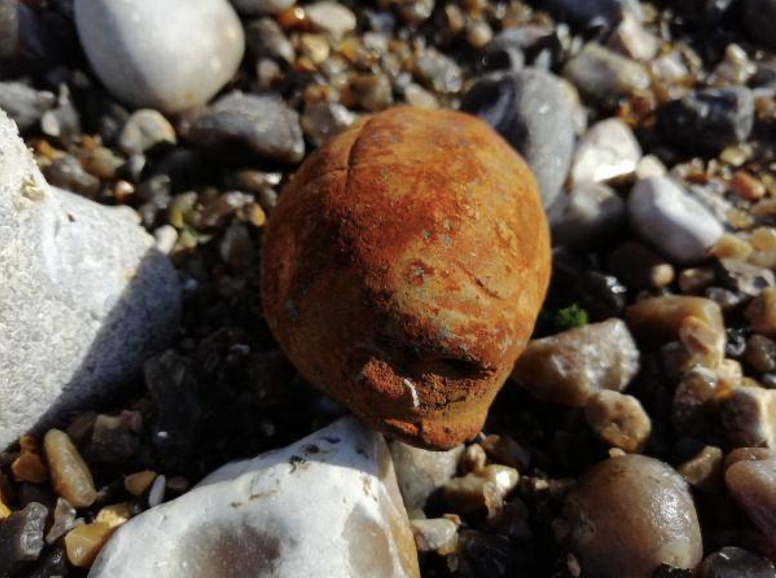 © Préfecture maritime de la Manche et de la mer du Nord
© Préfecture maritime de la Manche et de la mer du Nord
– Off Dieppe (76). Tuesday, November 19, 2019.
29 American bombs from the Second World War (1.3 tons of TNT equivalent) are collected and exploded by clearance divers from Cherbourg aboard the Vulcain. An earthquake of magnitude 3.4 is recorded off Fécamp and Dieppe by the national seismic monitoring network (RéNaSS). It makes the cliffs shake. The Préfecture Maritime reports that 922 pieces of ordnance found on the foreshore or at sea between the Belgian border and Mont Saint-Michel were destroyed in 2018 (27 tons of TNT equivalent).
2020
– Dieppe (76). Tuesday February 11 and Wednesday February 12, 2020.
Discovery of a shell after storm Ciara on the pebble beach by a garbage collector below the seafront promenade. In a few hours, the shell will be submerged by the high tide and battered by the waves. There’s a good chance it’ll be gone before a Mine Clearance Divers’ Group team arrives. The good news is that it was still in the same place the next day when the deminers arrived.
Dieppe is a regular subscriber to Robin des Bois inventories (See the inventory of war remains in Normandy from January 2004 to December 2007, only in French and the inventory of war remains in the Atlantic and Channel regions, January 1, 2008-December 31, 2013).
– Dieppe (76). Friday, February 14, 2020.
Discovery of a shell on the narrow Puys beach. Sandwiched between chalk cliffs, it was the landing site for the tragic Operation Jubilee on August 19, 1942. On February 19, the GPD had planned to pick it up, but it had disappeared, washed away by the tide, covered by pebbles, moved or stolen by beach cleaners.
– Dieppe (76). Monday, February 17, and Wednesday, February 19, 2020.
The Mine Clearance Divers’ Group counter-mined at sea the shell found on Monday 17th near the restaurant Le Bas Fort Blanc, and the volunteer waste pickers who were cleaning the pebble beach after the Ciara storm were surprised by the 2 deflagrations, the first corresponding to the explosive charge aimed at opening the shell’s carapace, the 2nd to the explosion of the kilos of explosive it had in its belly.
– Off Sainte-Adresse (76). Monday 23rd March, 2020.
Firing of a 175 mm artillery shell (5 kg TNT equivalent) by French Navy clearance divers.
– Off the coast of Octeville-sur-Mer (76). Tuesday, March 24, 2020.
Blasting of a 270 mm artillery shell (49.5 kg TNT equivalent).
– Off the coast of Fécamp (76). Wednesday March 25, 2020.
Blasting of a German LMA mine at 1 nautical mile (1.8 km). TNT equivalent: 370 kg. Earthquake measuring 3.2 on the Richter scale.
– Off the coast of Dieppe (76). Thursday March 26, 2020.
New NATO operation Historical Ordnance Disposal (HOD). Official communication was taken by surprise. The magnitude 2.9 earthquake caused by the explosion of a German LMB mine (930 kg TNT equivalent) did not go unnoticed, and the officer on duty was forced to communicate in real time.
– Off Le Tréport (76). Monday March 23 – Sunday April 5, 2020.
Results of operation HOD 2020: 7 German LMB mines and 1 depth charge (6800 kg of TNT equivalent) were blown up. 70 km2 were surveyed by CMT Andromède (France), HNoMS Otra (Norway), HNLMS Willemstad (Netherlands), BNS Bellis (Belgium), HMS Grimsby (Great Britain) and FGS Donau (Germany). Germany was in command. The clearance divers were assisted by underwater remote-controlled robots. The Préfecture Maritime states: “In the Channel and North Sea in 2019, the joint action of the Channel mine-clearing diver group and the mine hunters of the French Navy enabled the destruction of 1,786 historical devices (at sea and on the foreshore), representing 19 tons (19,100 kg) of TNT equivalent.”
– Off the coast of Le Havre (76). Monday 20, Tuesday 21 and Wednesday April 22, 2020.
Blasting of an American 500-pound bomb (126 kg TNT equivalent) and a German BM1000 mine (837 kg TNT equivalent) detected the day before and two days before using a wire-guided Self-Propelled Fish (SPF) from the CMT Cassiopée.
– Le Havre (76). Friday April 24 and Wednesday April 29, 2020.
On April 24, a naturalist discovered a 270 mm shell on Dollemard beach. On Wednesday April 29th, 2020, a team of clearance divers went to the site on foot. Motorized traffic on this stretch of coastline, full of garbage, scrap metal and even tombstones, is impossible. They relocated the ammunition and moved it to the disposal point. The shell contained 20 kg of TNT equivalent. The cliffs shook.
– Off the coast of Fécamp (76). Sunday May 31 – Sunday June 7, 2020.
Discovery by CMT Pégase of 3 German LMB mines and an American bomb in 23 m of water 2 nautical miles (3.7 km) off Fécamp and chalk cliffs. Two of the mines were detonated on Thursday June 4 (1680 kg TNT equivalent), the third and the American bomb on June 7th (1125 kg TNT equivalent).
– Off Veules-les-Roses (76). Thursday June 11, 2020.
Detonation of a German bottom mine 3.5 km off the coast by Andromède clearance divers. The beach and Les Galets restaurant were evacuated for an hour. “It was brief but quite stressful. The village literally shook,” says the mayor, the cliffs too.
– Saint-Jouin-Bruneval (76). Thursday, June 11, 2020.
The Mine Clearance Divers’ Group tows out to sea a 200 kg, 27 cm long shell containing over 50 kg of explosive. It was buried between sand and rocks on the beach. The blast was heard several kilometers away. Once again, the cliffs vibrated. Myriads of shrimp were displaced by the underwater shockwave and killed, but no inventory of underwater fauna mortality was carried out. They are part of the fatal and delayed collateral damage of war.
Saint-Jouin-Bruneval is a regular subscriber to Robin des Bois inventories (See the inventory of war remains in Normandy from January 2004 to December 2007, only in French, and the inventory of war remains in the Atlantic and Channel regions, January 1, 2008-December 31, 2013).
– Sassetot-le-Mauconduit (76). Monday, July 13, 2020.
Discovery of a shell at the foot of the cliffs on Petites-Dalles beach.
– Dieppe (76). Friday, July 17, 2020.
A man returns from an exploration of the cliffs with a piece of ammunition and passes it on to rescuers at Station 2, next to the minigolf course. On examining the photo, the Mine Clearance Divers’ Group makes no decision. It asks to see and will come to do so in the future, which is not specified or even estimated. In the meantime, the Mine Clearance Divers’ Group recommends that the waste be kept out of sight and out of the way. It was placed under pebbles at high tide, between 4 barriers marked “Police nationale – zone interdite” (“National police – forbidden area”).
– Etretat (76). Tuesday, August 11, 2020.
At midday on this Tuesday, hundreds of people were hopping on the beach under the greedy eye of the seagulls, and it was then that a child found a German artillery Flack 88 shell between the pebbles. Half the beach was calmly evacuated under the dejected eye of the seagulls. Not seeing the genuine deminers coming, the elected representatives improvised themselves as deminers and transported the shell in a bucket of sand, defying all the recommendations they would normally make themselves from time to time. This transgression was allegedly made for humanitarian reasons, nothing to do with the over-tourism business. “We couldn’t leave the beach closed any longer, as we’re still in the middle of a heatwave. Swimming is a way of staying hydrated.”
– Criquebeuf-en-Caux (76). Wednesday, August 12, 2020.
Discovery of a shell (60 cm long, 20 to 30 cm in diameter) at the foot of the cliff. It is covered with shells. “It’s not possible to detonate it on the spot because it’s too dangerous.” “There’s a significant risk of pebbles being thrown and the cliff falling due to the blast. The shell will therefore be transported offshore to be detonated.”
– Fécamp (76). Friday, October 2, 2020.
A shell measuring 40 cm long and 10 cm in diameter was dropped by an anonymous hand on the Joseph Duhamel quay next to a fishing boat. It has been placed in a confidential location awaiting removal by the deminers, who are due to intervene around Wednesday 7th.
– Saint-Jouin-Bruneval (76). Monday 19th and Thursday 22nd October, 2020.
Several weeks ago, a shell was located on the pebble beach. It was transported offshore at around 3 p.m. and detonated a few yards from the shore by clearance divers, opposite the Antifer oil port and the chalk cliffs. Fishing, water sports and swimming were prohibited along the entire coastline of the commune from 12pm to 6pm.
– Veules-les-Roses (76). Saturday, November 14, 2020.
Discovery of a shell 500 meters from the first-aid post.
– Saint-Jouin-Bruneval (76). Wednesday, December 2, 2020.
The operation was carried out discreetly, apart from the noise and vibrations of the destruction. No official security perimeter. A team of 5 clearance divers, accompanied by a medic, strapped on the 27 cm shell containing 35 kg of explosive found on the beach at the end of November, towed it one kilometer offshore and proceeded to destroy it. At the moment of detonation, a spray burst from the sea and the cliffs shook.
2021
– Octeville-sur-Mer (76). Monday, February 1, 2021.
Sea disposal of a 274 mm shell with an explosive charge of 34.8 kg TNT equivalent.
– Saint-Pierre-en-Port, Sassetot-le-Mauconduit and Saint-Martin-aux-Buneaux (76). Monday February 8 and Friday May 28, 2021.
The shell trapped in a pond at low tide had been there, lurking in the seaweed, for decades on the foreshore of the Grandes-Dalles beach. He was unmasked by a shore fisherman, and perhaps even heckled a little. The mayor has issued a bylaw banning access to the area, a sort of legal umbrella that hardly anyone reads, but which can be deployed if the event goes wrong. The Mine Clearance Divers’ Group has been alerted and is expected in the next few days. Except that in March, April and May, the shell had still not been uprooted, just as the peak visitor season was getting underway. The big day of the pond’s liberation was initially set for Wednesday May 26, but for “technical reasons” it was postponed to Friday May 28. Early in the morning, it was curfew time for 200 residents of the Grandes-Dalles and Petites-Dalles beaches, who had been informed by mail and other means for several days that they had to leave the area or stay at home, shutters closed to prevent the penetration of shrapnel and windows open to prevent the effects of the blast from breaking windows in the unlikely – but still possible – event that the operations to lift the shell, tow and firecrackers did not go according to plan. Have the caravans, trailers and chalets of the Huttopia campsite, with their plunging views over the cliffs and the sea, been included in the safety perimeter? Are all these precarious habitats considered to be safe, hard shelters? The shell, weighing 150 kg, 27 cm long and containing 15 kg of explosive, was fitted at low tide by a pair of deminers with a balloon to ensure its buoyancy, and at high tide it was towed to within a kilometer of the coast, then deposited at a depth of 10 metres by clearance divers, belly-ended by an explosive counter-mining charge that was detonated once the whole team was a respectable distance away on the zodiac. When the time came, a large spray of explosive residue was released, covering the seabed in a halo. From a safety point of view, the matter was closed, but from an environmental point of view, it was just beginning. At 10 a.m., the security apparatus, which had been on a war footing since 5:30 a.m. was lifted.
– Belleville-sur-Mer (76). Thursday, February 18, 2021.
Shell counter-mining on the beach.
– Saint-Jouin-Bruneval (76). Sunday, May 9 and Thursday, June 24, 2021.
A shell was found on the pebble beach. In Saint-Jouin (population 1,800), until then, such events went without any fuss. The mayor’s office, for whom the beach is a tourist resource and attraction contributing to the town’s reputation and economy, simply encouraged onlookers to be cautious, after planting 4 wrapped stakes around the piece of war waste. On Thursday June 24, the day of the demining operation, what followed was more ceremonial, with the prefecture taking the reins, banning all traffic in the town and instituting at 7:30 a.m. a sheltering regime for civil society within a 1,500-meter radius of the shell. The mayor, upset to see the start of a fruitful tourist season penalized in this way, was more inclined to talk of abuse, and the population itself was a little taken aback by the racket. Sheltering must be done in permanent buildings, tents and other makeshift shelters are forbidden. Never before in the memory of Saint-Jouinais have we had to endure such an uproar during ammunition evacuations. Access to the town was blocked from 7:30am. The Proxi mini-market manager, Joëlle who runs the hairdressing salon and Albert the butcher don’t look too bad, but La Frite d’Or (The Golden fry), which has a front-row seat with its bay windows overlooking the pebbles and shells, is at its most nervous. “Let’s hope that it’s not postponed until Friday, I’ve already got 140 reservations.” The 274 mm long, 150 kg shell and an unexpected 81 mm mortar were destroyed off Saint-Jouin-Bruneval and the oil port of Antifer.
– Saint-Jouin-Bruneval (76). Thursday, May 20, 2021.
Discovery of a 270 mm shell on the beach.
– Saint-Jouin-Bruneval (76). Sunday, May 30, 2021.
A person walking along the beach reports a 25 cm long shell visible only at low tide. It has been geolocated, and provided it stays put, it should be taken care of by a GPD team. Two options are open: detonation in the rocks or detonation at sea.
– Off the coast of Fécamp (76). Saturday June 26 – Monday June 28, 2021.
18 American BK (Barge Knockdown) barges were scuttled during or at the end of the Second World War, around 30 km off the coast northeast of Fécamp and 8 km from the current site of the offshore wind turbine plant. According to the Préfecture Maritime, they were carrying 100 and 150 LBS (100 and 150 lb, or 45 and 68 kg) US aviation bombs. According to the historical pyrotechnical study of the Fécamp wind farm project carried out in 2011 by Geomines, 2,000 250 kg bombs are believed to be in the wreckage. They were identified in 2009 by a mine hunter, and the maritime prefect’s order of June 19, 2009 prohibits anchoring, trawling, dredging and scuba diving within a 4 nautical mile (approx. 14 km2) zone around these wrecks (link to the order). Pyrotechnic “clean-up” operations are regularly carried out, both voluntarily and involuntarily. In 1999, the explosion of an underwater mine in the same area triggered a strong seismic tremor measuring 4.4 degrees on the Richter scale and undoubtedly making the cliffs shake. The Maritime Prefecture of Cherbourg then suggested that other ammunitions in the vicinity of the destroyed mine had exploded through a contagion effect.
This new mission by the Vulcain’s clearance divers led to the detonation of 24 bombs (891 kg of TNT equivalent).
– Off the coast of Fécamp (76). Tuesday, July 13, 2021.
Blasting of a 105 mm shell (2.4 kg TNT equivalent).
– Off the coast of Fécamp (76) and Ault (80) and in front of Cherbourg (50). Tuesday August 10 to Tuesday August 17, 2021.
NATO’s annual HOD operation. This year, one American, one Latvian, two German and one French ship, the CMT Croix du Sud, took part in the operation. Two German mines were detonated off Cherbourg, and one by the USNS Carson City off Ault/Fécamp. The latter had been hauled up by the Ma.jo.li. “It happened on a trip to fish for cuttlefish and red mullet. We fished the mine out of the trawl. We saw it as we were hauling it in, then it went through the net because it was too heavy. So we alerted the authorities. Le Courrier Picard reports that the Préfecture Maritime “did not answer our questions about the risks posed by the mine and the consequences of its explosion on the seabed.” Olivier Becquet, manager of the cooperative of artisanal fishermen (CAPA) in Le Tréport, reiterates his criticisms. “With the waves sent into the seabed, the fish go away for a while. As for the bombs that are exploded, I wonder about their chemical composition. Fishermen sometimes bring up rotten seaweed. We’ve asked for chemical analysis of the water, but there’s never been any.”
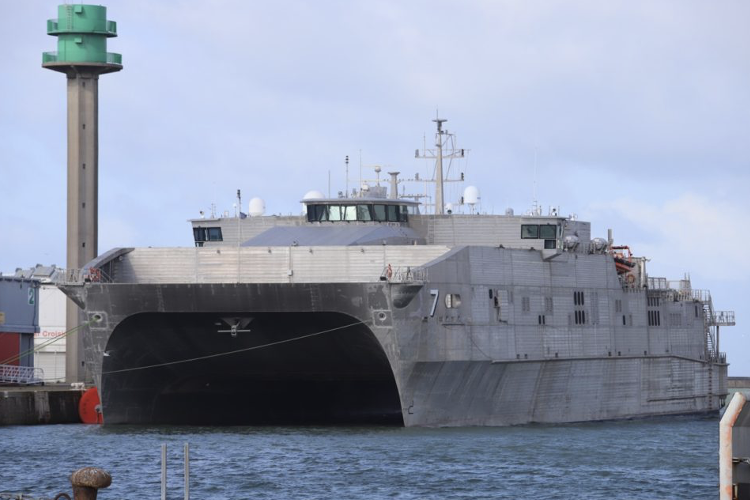 The USNS Carson City © Préfecture de Seine-Maritime
The USNS Carson City © Préfecture de Seine-Maritime
– Etretat (76). Sunday, August 22, 2021.
100 meters from the Amont cliff, 2 tourists scraping vines discovered a 20 cm long shell at low tide on the Chaudron beach at around 7pm. The mayor issued a municipal decree closing the beach “pending the intervention of a bomb disposal unit or the departure of the shell with the tide”.
– Fécamp (76). Saturday, November 13, 2021.
A resident of Fécamp was out walking with his dog and 2 friends on the pebbles when he noticed a grenade with squares. The gendarmerie is alerted. The trio and their dog wait on site for the gendarmes to arrive. “We warned the bomb squad, but they didn’t have time to come,” says the captain. And the grenade left with the high tide.
– Off Le Tréport (76) and Cayeux-sur-Mer (80). Wednesday, November 24, 2021.
The CMT Pégase detects the German LMB mine, released after poor fishing, and explodes it. 844 kg of TNT equivalent.
2022
– Off the coast of Dieppe (76). Tuesday 8th to Wednesday 23rd March, 2022.
Another ammunition-filled wreck. This time it’s the ex-chaltier Franken, converted by the Germans into the UJ 1404, a submarine hunter sunk on August 19, 1942 during Operation Jubilee, taking her cargo of war materiel with her to the bottom (see 34 underwater military wrecks). 26 shells and 3 anti-submarine grenades were fired on March 8 and 9 (238.6 kg of TNT equivalent) and 9 grenades on March 23 (650 kg of TNT equivalent). This operation is an opportunity for the Préfecture Maritime to announce the results of last year’s mine clearance operation: “In the Channel and North Sea in 2021, the joint action of the French Navy’s group of mine clearance divers and tripartite mine hunters resulted in the destruction of 420 historical devices (at sea and on the foreshore), representing 11,468kg of TNT equivalent.”
– Off Saint-Valery-en Caux (76). Wednesday May 11 and Thursday May 12, 2022.
Detection by the CMT L’Aigle, displacement and blasting of a German LMB mine (840 kg TNT equivalent).
– Le Tréport (76). Monday, May 16, 2022.
On Monday May 16, the round anti-tank mine in the middle of the countless pebbles was spotted by a fisherman on foot taking advantage of the high tidal coefficients. In the late afternoon, the GPD from Cherbourg detonated it. The beach was completely cordoned off.
Le Tréport is a regular subscriber to Robin des Bois inventories (See the inventory of war remains in Normandy from May 2001 to May 2004, only in French, the inventory of war remains in Normandy from January 2004 to December 2007, only in French, and the inventory of war remains in the Atlantic and Channel regions, January 1, 2008-December 31, 2013).
– Veules-les-Roses (76). Wednesday, May 18, 2022.
5pm. On the beach. Discovery of a shell 40 cm long and 10 cm in diameter.
– Octeville-sur-Mer (76). Thursday June 16 and Friday June 17, 2022.
– Blasting of a 270 mm long shell, 47 kg TNT equivalent, on the beach. A 1500-meter stretch of coastline is off-limits. The zone is “clear” at sea. The shell was detonated at around 8am. The operation involved sheltering 700/800 people. Residents were not evacuated. People were advised to stay at home, close their shutters and open their windows.
– On the beach at the foot of the chalk cliffs, 2 x 270 mm shells with a cumulative charge of 94 kg of explosive were counter-mined by the GPD after it had been assured that the 1500-meter-long linear zone at sea was “clear”. This time, 300 people were confined to their homes. Le Havre-Octeville airport was closed, as was access to the Youri-Gagarine stadium. The 2 shells were almost in contact. They were located 1.5 km from the shell treated the previous day. Destruction took place at around 9 a.m.
The cliffs vibrated. Houses shook. For both operations, the 6 de-miners came and went on foot.
– Saint-Valery-en-Caux (76). Tuesday, August 2, 2022.
A summer visitor reports the presence of a 20 cm long shell next to the beach first-aid post.
– Octeville-sur-Mer and Saint-Laurent-de-Brèvedent (76). Saturday, September 17 and Monday, September 19, 2022.
On the beach on Saturday, the man dug up the shell with its head sticking out, took it home and informed the gendarmerie. On Monday, the deminers intervened.
– Off the coast of Saint-Valéry-en-Caux (76). Tuesday, October 4, 2022.
The German LMB mine (825 kg TNT equivalent) was moved before being detonated further offshore. Fishing, swimming and walking on the beach were prohibited during the operation.
2023
– Saint-Jouin-Bruneval (76). Tuesday April 11 and Wednesday April 12, 2023.
A 30 cm long shell was discovered on Tuesday at the end of the beach parking lot. According to the mayor, the backfill in the parking lot came from the excavation of the Antifer oil port. The oil port was inaugurated in 1976. The de-miners removed the shell on Wednesday. “What was at stake in this intervention was also the opening of our beach season, which we hope will start this weekend.” The mayor is reassured that the beach will open on the weekend of April 15-16th.
– Baie de Seine (76). Mid-May, 2023.
CMT Croix du Sud clearance divers fire ammunition discovered by a fisherman.
The Maritime Prefecture reports on the year 2022: “In the Channel and North Sea in 2022, the joint action of the French Navy’s mine-clearing divers and tripartite mine hunters resulted in the destruction of 1,007 historical devices (at sea and on the foreshore), representing 15,675 TNT equivalent.”
– Off Saint-Valery-en-Caux (76). Mid-May, 2023.
Detection by the CMT Croix du Sud of 4 LMB mines close to the coast. “Each ammunition had to be slung and then lifted before being towed offshore to destroy them in drums, a measure designed to preserve the seabed as much as possible.”
The drums act as floats and the ammunition is between two waters, which to some extent reduces environmental damage, at least for benthic organisms and bottom-dwelling fish.
– Off the coast of Dieppe (76). End of May, 2023.
The Vulcain “carried out a new mine-clearing operation on a well-known and frequently checked historical site where various barges loaded with munitions sank during the Second World War.” 83 munitions, including several bombs, were blown up (3.6 tons of TNT equivalent). The Préfecture Maritime does not specify whether this is the same barge graveyard as the one opposite Fécamp (see Large de Fécamp – Saturday June 26-Monday June 28, 2021 above). This pyrotechnic dump is actually located offshore between Dieppe and Fécamp.
– Off Dieppe (76). June-September, 2023.
Excerpts from the Robin des Bois press release dated August 11th, 2023 “Les soulèvements de la mer” (The upheavals of the sea, only in French):
“This summer, the Geo Ocean III, a red ship flying the flag of Luxembourg, and the Venus II, a black watchdog flying the flag of Panama, are criss-crossing the English Channel off Dieppe/Le Tréport to sniff out war waste and ward off professional fishermen. The aim of this late-night, opportunistic and necessarily botched detection campaign is to secure the foundations of 62 industrial wind turbines and the route of underwater power cables. It is governed by a decree issued by the Maritime Prefect for the Channel and North Sea on June 23, 2023 following a request dated June 16, 2023 from the company EMDT (Eoliennes en Mer Dieppe Le Tréport), which is backed by a consortium of Portuguese, Japanese and French interests.
The detection campaign will be followed by a destruction campaign by the Groupement des plongeurs-démineurs de Cherbourg. These destruction bursts release blast effects and acoustic and vibratory energies that mutilate fish, porpoises and other marine mammals.”
Read in full.
According to the information made public, only 4 ammunition were discovered by the armada and counter-mined by the French Navy, the least effective and most costly mine clearance operation carried out in the Channel and North Sea since the end of the Second World War.
At the meeting of the Conseil Maritime de la Façade Manche Est – Mer du Nord (CMF MEMN) on September 20, 2023, Robin des Bois requested a report on the results of these mine clearance operations at the bottom of the offshore plant. The Maritime Prefect replied by giving an overall assessment of demining operations in 2022, and at our insistence indicated that he would look into the possibility of obtaining data specific to this site. No reply has yet been received.
– Sainte-Adresse (76). Saturday, September 2, 2023.
Mael, 14 years old, crabbed along the shore and triumphantly returned to his mother with a trophy, the danger of which he clearly didn’t appreciate. “My blood ran cold when I saw what he was bringing back.” It was an artillery shell.
Results of operations by the Groupe de Plongeurs Démineurs de la Manche and the French Navy’s minehunters between the Belgian border and Mont-Saint-Michel
| Year | Number of historical devices found on shore or at sea and destroyed | TNT equivalence in Kg |
| 2019 | 1,786 | 19,100 |
| 2020 | 489 | 33,947 |
| 2021 | 420 | 11,468 |
| 2022 | 1,007 | 15,675 |
| 2023 | 252 | 11,727 |
| Total | 3,954 | 91,917 |
Source: Maritime Prefecture for the Channel and North Sea
2/ ON LAND
2019
– Le Mesnil-au-Val (50). Thursday, June 6 and Tuesday, July 23, 2019.
– June 6, 2019 marked the 75th commemoration of the Allied landings. In addition to attendees Emmanuel Macron, Donald Trump and British Prime Minister Theresa May, an unexpected American veteran appeared: a bomb weighing 230 kg and measuring 35 cm in diameter. It was buried 40 cm deep. A landscaper digging a trench in a private garden hit it with a mechanical shovel. Le Mesnil-au-Val is 4 km from the beaches and 8 km from Cherbourg harbor.
– The bomb was to be defused on July 23. 400 inhabitants were evacuated, and village access was prohibited. 15 gendarmes patrolled the area to prevent looting. The skies were cordoned off too, with overhead flights forbidden. Five stubborn households refused to leave their homes. A pair of deminers carried out the delicate and perilous operation of dismantling the ignition systems and unscrewing the detonators. If the bomb exploded, it would kill all life within a 50-meter radius, and the missile effects can be fatal or mutilating up to 800 meters away. The bomb was taken away without a police escort, rather bound inside a van, unable to go off. Deminers must still be sure to avoid any collisions or swerves. The bomb can no longer spontaneously explode, but it still contains 110 kg of explosives inside.
– Equeurdreville-Hainneville (50). Wednesday, September 25, 2019.
As an outside company conducted topographical surveys of the labyrinthine underground military site of Brécourt, they discovered 7 Panzergranate rifle grenades, each containing 140 grams of TNT equivalent, in a gallery – 75 years after the German troops’ debacle. Four deminers from the French Navy detonated them inside a bunker.
– Saint-Amand-Villages (50). Thursday, September 26, 2019.
An excavation using a mini-excavator in Les Hayes, located in the former village of Placy-Montaigu (population 236), revealed a 3.5 kg shell dating back to WWI. While not confirmed, a surviving soldier may have brought it back as a souvenir. The shell is now in the possession of deminers.
– Ravenoville (50). Thursday, October 3, 2019.
While renovating the lighting system, Sarlec workers hit a shell 80 cm deep behind the statue of Black Madonna, protector of sailors. This landed in the vicinity of support point WN 103, short for Wiederstandnest, which translates into “nest of resistance”. The Caen interdepartmental mine-clearing service defused and removed an additional 72 shells. The 22nd Infantry Regiment attacked WN 103 on June 7, 1944.
– Lessay (50). Friday, November 8, 2019.
A classic! A shell warhead was discovered inside an incoming shipment of potatoes from Hauts-de-France in the sorting room. 38 employees at Créaline, the instant mashed potato company, were evacuated immediately. After 2 hours of exchanging photos and documentation, experts lifted the alert. The shell, no longer active, was later handed over to the mine clearance services. Batches of potatoes and beets from the Hauts-de-France region are regularly polluted by ammunition and scrap metal residues that lie in the soil from WWI artillery.
2020
– Granville (50). Lundi 20 et mardi 21 juillet 2020.
A thermal weeder caused a fire at a private home, which spread into the garden. It destroyed a veranda and a shed, where firefighters found the carcass of a shell while clearing away debris. A safety perimeter was set up, and the bomb disposal squad was called in the next morning to remove the smoke shell carcass.
– Coutances (50). Thursday, October 1, 2020.
Late in the day, an anti-tank mine and a shell were removed from under a bridge on the bank of the Soulles, a tributary of the Sienne. The 2 munitions were reported to the Coutances police station between 4 and 5 pm. “There was no imminent danger, but we couldn’t leave them on the public highway“, commanding officer and acting police chief Marie-Laure Mercier told Ouest-France. The war devices no longer had an operational detonator, but any secondary explosive charges could trigger a fatal accident. “Collectors of military artefacts could have got hold of them.”
2021
– Coutances (50). Wednesday, January 27, 2021.
A 51-year-old man is being prosecuted for possession of ammunition. He is a militaria collector. He has already been implicated in a theft and concealment of military items. As part of this case, a search was carried out at his deceased parents’ home in Tourville-sur-Seine and a large stock of Second World War ammunition – grenades, shells and rockets of German and American origin – was discovered, seized and secured. Through his lawyer, the defendant denied any responsibility for the stockpile and put the blame solely on his father. He pointed out that he did not have the key to his parents’ home and that the estate had not been settled. He was acquitted.
– Coutances (50). Wednesday, January 27 and Thursday, January 28, 2021.
While digging for a building site in the La Belle Hôtesse locality, workers unearthed a shell and a nest of machine-gun cartridges without disturbing them. The Coutances police station was informed that afternoon. The bomb disposal squad was on the spot on the following day.
– Coutances (50). Saturday, March 20, 2021.
When arriving at work Saturday morning, the store manager of Action discount store discovered a crate in the parking lot containing 3 x 37 mm shells. The Armurerie Coutançaise took charge of the parcel before passing it along to a bomb disposal unit.
– Amigny (50). Friday, April 16 and Friday, April 30, 2021.
– On Friday, April 16, a farmer unearthed a corroded object with all the features of a bomb while ploughing once again a field. The town hall is located 50 meters from the discovery. The Préfecture de la Manche mobilized the deminers from the Interdepartmental Centre in Caen.
– On Friday, April 30, they intervened. In the meantime, the WWII device was covered with soil and discreetly marked out by bomb disposal services. “We didn’t want to publicize the information to avoid attracting curious onlookers and frightening the population“. At 8:30 a.m. on D-Day, 14 households were evacuated within a 540-meter perimeter around the 45 kg American bomb containing 24 kg of explosives. After 2 hours, the detonator was unscrewed and residents of Amigny and neighboring Pont-Hébert were able to return home. The bomb was transported by road to a transit center before being deliberately blasted.
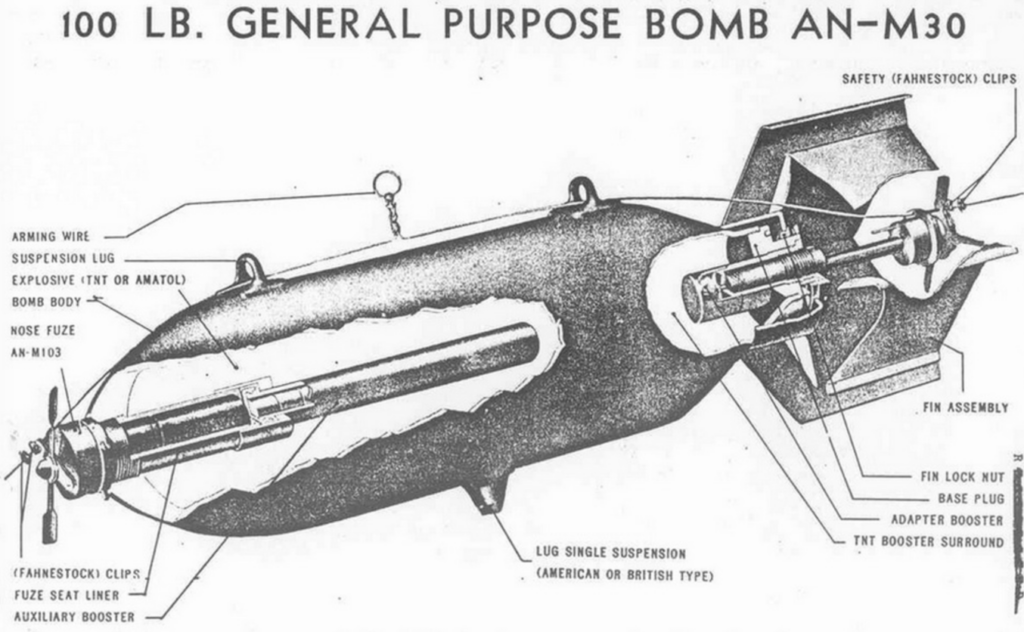 AN-M30
AN-M30
Source : United States Bombs and Fuzes Pyrotechnics
– Cherbourg-en-Cotentin (50). Saturday, April 17, 2021.
A shell lay in the bed of the Divette among stones underneath a bridge in the middle of town, Avenue de Paris.
– Sourdeval (50). Monday, June 14 and Monday, July 26, 2021.
An American bomb with 250 kg of explosives was discovered near an old station during a “greenway” construction. The demining operation took place a month and a half later.
The bomb had been stored in a pit and surrounded by a double row of straw bales. The initial plan called for an 800-meter radius, which would have put the town of Sourdeval (population 3,000) in a “clear zone”, i.e. devoid of any human activity or presence. The security perimeter was later reduced to 400 meters. Only 280-300 Sourdeval residents and the 25 residents of Saint Joseph retirement home were confined to the Rex auditorium, while bomb disposal experts from Caen removed the detonator and neutralized the bomb. They explained, “It’s a medium-sized bomb, a common model, which we’re used to encountering here in Normandy“. “If it had exploded during the earthworks, it would certainly have done a lot of damage. This bomb is very dangerous, because inside it’s as good as new. If it had exploded, it would have dug a crater 5 to 7 meters deep, and shrapnel would have been projected over a radius of 800 meters.” The detonator was destroyed on the spot at 11:51 am. “It is itself dangerous, capable of tearing off a hand,” a deminer explained to a correspondent of La Manche Libre, Saint-Lô’s weekly newspaper. The area was closed to flights flying over, though a Civil Security drone from Nogent-le-Rotrou monitored the operation.
– Cherbourg (50). Monday, July 26, 2021.
Roule mountain, which overlooks Cherbourg and the harbor, has encountered ephemeral incursions since the Covid-19 quarantine. People trampling and clearing the area expose shells. Ammunition theft is suspected. Officials are considering installing at least one video surveillance camera. The Roule mountain has served as a defensive, strategic, and offensive aerie since the 17th century. “He who holds the Roule holds Cherbourg.” The German-held Roule Battery’s size was reduced on June 25, 1944 by the 79th American Infantry Division. The citadel and its underground galleries are no longer used for military purposes. It is managed by the EXSPEN (EXplorations SPorts ENvironnements) association).
Cherbourg, see the inventory of war remains in Normandy from May 2001 to May 2004 (only in French) and the inventory of war remains in Normandy from January 2004 to December 2007 (only in French).
– Saint-Amand-Villages (50). Wednesday, December 22, 2021.
A path widening construction project uncovered a 50 cm-long shell, 12 cm in diameter, but the diggers did not notice or report it. Instead, hikers made the discovery. Bomb disposal services are expected to arrive.
2022
– Avranches (50). Tuesday, February 15, 2022.
A backhoe loader came across a 125 kg bomb, originally from America, on the Notre-Dame-de-la-Providence school site. The Avranches Gendarmerie Company arrived on scene, followed by the Caen Bomb Squad. The unexploded bomb had digged into the soft earth. It was removed on site and will be deliberately detonated one day “at sea“. In the meantime, it took to the road in an unescorted van.
Avranches, see the inventory of war remains in Normandy from May 2001 to May 2004 (only in French) and the inventory of war remains in the Atlantic and Channel regions, 1 January 2008-31 December 2013.
– Lessay (50). Thursday, February 24, 2022.
90-year-old R.C. witnessed at the age of 11 a German soldier being buried in a bomb pit, which was later used as a garbage can for dead cows. After keeping this shocking memory to himself for 79 years, he went to the gendarmerie to relay the facts. A search was executed at the very spot that had been engraved in his memory. A pair of leather shoes, textile fragments, metal buttons and the skull, ribs, and lower jaw of the “hedge war” victim were found. The soldier’s regimental number is missing, and his relics will remain orphaned forever. There are plans to transfer them to the German cemetery at La Cambe in the Calvados department.
– Saint-Germain-d’Elle (50). Saturday, June 4, 2022.
Rains and storms have ravaged fields and liquefied embankments. The munitions are coming out of their lairs exactly 78 years after the Allied landings. The deminers are expected to intervene “in the next few days“.
– Saint-Quentin-sur-le-Homme and Terre-et-Marais (50). Wednesday, November 2, 2022.
It’s ploughing season and time to harvest shells.
A farmer dug up 2 shell warheads in a field and drove them to the gendarmerie in Ducey, a 4 km journey that violates all basic safety procedures.
Another farmer dug up 3 shells in the new commune of Terre-et-Marais, a merger between Saint-Georges-de-Bohon and Sainteny. He followed all procedures and called the Carentan gendarmerie.
2023
– Digosville and Tamerville (50). Late December 2022, early January and Tuesday, January 24, 2023.
In late December and early January, a metal detection expert discovered 2 shells – one German, one American. Demining services, the gendarmerie and the prefecture were informed. The shells will soon be removed and destroyed. Digosville and Tamerville are 15 km apart.
– La Bazoge (50). Friday, March 24, 2023.
An unexploded bomb of American origin was revealed while clearing out a quarry of Pigeon, one of the gravel and concrete kings in Brittany and Normandy. The bomb, discovered 79 years later, measures 119 cm long, 36 cm in diameter, weighs 225 kg, and has 110 kg of explosive. The clearing took place after 10 residents were evacuated. The crisis center was in the town hall and the 2 deminers, alone, faced with risk, succeeded in securing and evacuating the bomb and its explosives. “We’re not afraid, but anything can happen.” The bomb was driven away in a bomb disposal van of the Caen Interdepartmental Centre. Collision prohibited.
– Glatigny (50). Thursday, May 11, 2023.
A grenade resurfaces in a ploughed field. After being alerted, the Coutances gendarmerie secured the site until deminers from the Caen interdepartmental center could intervene.
– Saint-Barthélemy (50). Beginning of July 2023.
A field concealed 2 perchloroethane smoke shells, American in origin. They were fired on August 6, 1944, during a frontal assault between American and German troops.
– Fervaches (50). Wednesday, July 19, 2023, and Tuesday, February 20, 2024.
– 2 walkers spotted a 1.3-meter-long American bomb on the towpath in July 2023 along the Vire riverbed, which flows into the Channel at Isigny-sur-Mer. The bomb was 60 cm in diameter and made in 1944. The water level was low in the Vire. The bomb was discreetly and delicately transferred to a field using a local company’s lifting equipment.
– The bomb was deactivated in February 2024, the operation requiring an 800-meter safety radius. Roughly fifty residents of Fervaches, Domjean and Troisgots were evacuated and accommodated in a village hall. The ignition systems, too rusty to be dismantled, underwent hydro-abrasive cutting, a high-pressure mixture of sand and water never used before in the Manche department. The 2 detonators were then deliberately destroyed under the orders of 5 deminers. The 2 explosions were heard in the Troisgots village hall, where the refugees were offered a meal.
– La Meauffe (50). Saturday, September 30, 2023.
The “Grandpa Boom” struck 11 months after his death. René Leconte had celebrated his 100th birthday in late August 2022, surrounded by his sons and 2 daughters at his home in La Meauffe. He was even honored by the town hall. In his youth, he spent a year in Germany near Koblenz in the occupation army. Upon returning from military service, he worked successively in construction, at the Claudel dairy and road haulage. He retired in 1981 and afterwards devoted himself to raising cows and serving his neighborhood. “Pas bi tché” (not much) he used to say in patois. He passed away on November 16, 2022. In late September 2023, three men were clearing his house, filled with garbage and trinkets, until they lit a fire in the garden, causing a huge explosion. They were trying to remove a tree stump using ammunition residue, a common post-war era practice. It was heard for miles, and the tiles moved as far as Pont-Hébert. Philippe Visage, 63, died instantly; Jean-Jacques Coligny was seriously injured, Franck Horel was the least injured but deafened, and 2 others were unhurt but stunned. Inside the blown-up house, the deminers who arrived on scene midday found 5 kg of munition from the last war, according to the prefecture. Another authorized source estimated the figure at 19 kg.
CALVADOS DEPARTMENT
2019
– Ouistreham (14) – Tuesday, October 16, 2018. Caen (14) – Tuesday, January 15, 2019.
On October 16, 2018, 2 English dealers in second-hand goods went shopping in the Orne and Calvados departments and arrived at the Ouistreham-Portsmouth car ferry to return home. Just before boarding, security guards panicked upon discovering a saber, 12 shell casings and warheads, and aluminum milk cans mistaken for gas cylinders inside their vehicle’s trunk. Panic ensued at the maritime terminal, which was quickly evacuated and closed off by customs and police officers. A maritime patrol barred all means of access to the marina. On January 15, 2019, they were each charged with unauthorized possession of category A war material and fined 2,000 €, of which 1,700 € was suspended. “We didn’t know it was prohibited.” The seller guaranteed that the equipment was harmless.
– Moult-Chicheboville (14). Wednesday, January 16; Monday January 21, and Sunday March 3, 2019.
As a Leclerc supermarket store underwent expansion, 3 bombs were discovered underground on January 16 and 21. They were removed on March 3. The soil evacuation was not subjected to a preventive diagnosis or early clearance. For 44 and 39 days, the 3 war machines, still ready to wage war after 75 years of dormancy, were set aside in an unmarked hole on the building site.
On Sunday, March 3, the Moult and Argences communes were in a state of upheaval. 360 people had to evacuate their homes by 8 a.m., including the residents of “Papy loft”, a home for the elderly. Residents who took refuge in village halls received visits from the prefecture’s leaders and the head of the SIPDC (Interministerial Civil Defence and Protection Service).
The triplet of bombs, each 118 kg, 83 cm-long, 23 cm in diameter, and each containing 25 kg of explosives, were deactivated. Once the firing systems, detonators and priming fuses were removed, they became passive, only liable to set off in the event of a fire or severe damage. The bombs were secured in vans with slightly reinforced sides to protect against any collisions or side impacts. They will be placed at a military site. Traffic was restored at around 1pm as soon as the bombs left Moult-Chicheboville and Argences. The detour for vehicles coming from Caen or Paris, set in place by the Departmental Road Agency, was gradually lifted.
– Villers-Bocage (14). Tuesday, February 5 and Sunday, March 17, 2019.
A 230 kg, British aviation bomb was discovered on Tuesday, February 5 in an industrial zone aptly named Les Terres Noires. It was defused on Sunday, March 17. The A84 autoroute was closed between interchanges 43 and 44. Three commercial flights from the Carpiquet airport near Caen suffered from delayed departures. The exclusion zone (400 meters around the bomb) had to be “clear” from 8 a.m. onwards. Six different checkpoints prohibited access to the zone. “We are knocking on people’s doors, making sure they have evacuated.” 15 pavilions have been marked as empty. Only 4 people took refuge in the Richard Lenoir community hall, including a couple that had already experienced a mine clearance “here, 2 years ago, and another time in Orne“. People tend to place blind faith in those tasked with demining. The operational command post was set up in the town hall, and all the emotion was palpable. By 10:40 am, the tension in Villers-Bocage subsided. The operation was over, and the aerial bomb was on its way out, carrying 125 kg of explosives. It will be destroyed later.
– Damblainville and Versainville (14). March 2019.
The Mesnil-Soleil hillside nature reserve is a battlefield. It covers 25 hectares. It was established in 1981. It is managed by the Calvados département and the Normandy Natural Space Conservatory. It was in 2018, during the felling of 300 trees over more than 2 hectares, that the first unexploded ordnance buried at a depth of 30 cm was unearthed. This exceptional clearing was authorised to ensure the smooth operation of a Météo France radar system on the outskirts of the reserve. This is how nature reserves get nibbled away. Rather than relocate the Météo France equipment, it was decided to cut down part of the Mesnil-Soleil hillside’s plant heritage. In a second phase, additional clearing was carried out to facilitate the movement of leisure aircraft to the Falaise aerodrome, and new munitions were reported. At the end of the last war, the German-held airfield was heavily bombed by Allied aircraft. There are a lot of bomb holes around Falaise and also memory lapses. A pyrotechnical survey was carried out in 2019 and more than 3,000 metal targets were detected in the soil and subsoil, at least 400 of which correspond to the profiles of war devices. The reserve was closed to the public from March 2019 to July 1, 2021. Some munitions have been removed from time to time, according to the reserve’s managers, but most remain in place, as much for reasons of biodiversity protection as for financial reasons. The reserve was fully open to the public before 2018. Today, only a signposted path is permitted. It is 3.8 km long and allows visitors to cross the reserve safely, provided they do not leave it.
– Bellengreville (14). Monday, March 11 and Sunday, April 14, 2019.
An American bomb (460 kg, 48 cm in diameter, 135 cm long) was discovered on March 11 and defused 3 days later. Neutralization takes place on Sundays when there is the least human activity. Between 9:30 a.m. and 2 p.m., departmental road 41 was closed, the safeguard perimeter completely uninhabited. It is unknown whether the cows nearby were confined to the barn, though the herd was not the priority. This marks the 3rd discovery on the “Tourbe” electrical substation site, which will supply England with 400,000 volts of direct current via an undersea spur. The first 2 bombs were discovered here in June and July 2018, both of which were categorized as heavyweight bombs. The latter was manufactured in July 1944. By 1:30pm, the detonators had been unscrewed and the bomb considered “inert.” Authorities transported it away carrying 240 kg of explosives and later blasted it on a military site polluted through being used as a wartime garbage dump.
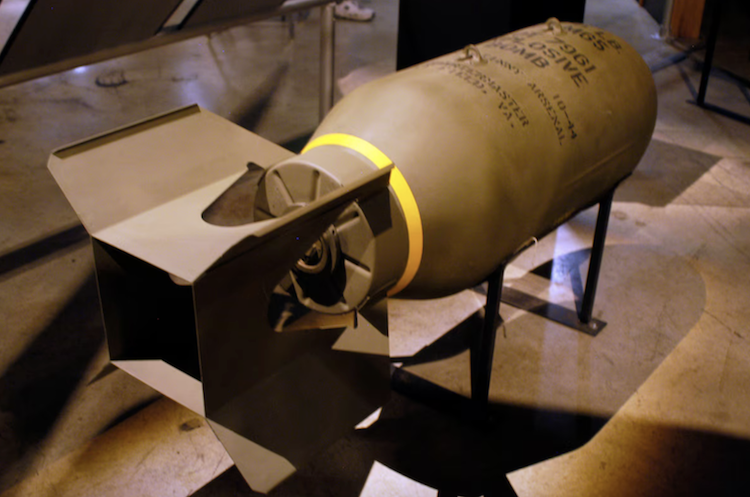 The AN-M65, an American bomb weighing around 460 kg
The AN-M65, an American bomb weighing around 460 kg
© National Museum of the U.S. Air Force
– Saline (14). Monday, March 25 and Tuesday, May 7, 2019.
On March 25, an excavator discovered a building site with an American-made bomb (118 kg, 83 cm long, 20 cm in diameter). It will undergo a defusal attempt on Tuesday, May 7. By 8 a.m., 300 residents had been evacuated, with the village hall willing to accommodate those with extenuating circumstances. While the gendarmes guarded the deserted neighborhood to prevent theft and trespassing, one of the refugees reflected: “I’m not surprised! When I had my house built in 1970, we found a German’s belongings: a shaving brush and a razor, as well as some shrapnel.”
– Colombelles (14). Friday, April 26, and Sunday, June 30, 2019.
Colombelles, deserted town centre within a 400 metre radius of the bomb. 1,800 people evacuated. The unexploded US Air Force bomb (222 kg, 119 cm long, 36 cm in diameter, 119 kg of explosives) was discovered on 26 April in the Avenue de la Liberté opposite the “Aux Délices de Colombelles” bakery during roadworks. Pending the intervention of the bomb disposal experts, the bomb, which was in good condition, was placed in a pit a few metres away from the Colombelles Mairie bus stop. On Sunday 30 June, no pedestrians or vehicles are allowed to enter the evacuated areas from 7am. The police are cordoning off the area and ensuring that it is completely evacuated. The pit has been surrounded by a double wall of high-density straw bales to cushion the effects of the blast and reduce the dispersion of shrapnel in the event that the operation goes badly. Thanks to the composure, expertise and feedback of the demining team, the bomb was successfully deactivated and the security measures were lifted in the afternoon.
– Colomby-Anguerny (14). Friday, May 24, 2019.
A landscaper working in a church parking lot stumbles across a still-active anti-tank mine. “With the 75th anniversary just a few days away, the relics of June 6th and the Battle of Normandy are still very much in the news.”
– Trouville-sur-Mer (14). Sunday, June 9, 2019.
“It’s around 6pm on Sunday, June 9, 2019. Diane, 10, and Clarisse, 7, are playing in the garden of their family home in Trouville-sur-Mer (Calvados). The two sisters invited over one of their friends, Olivia, 10. The three girls decided to play archeologist’s apprentice by digging up where a hedge had just been ripped out. The game turns from fantasy to reality when their garden spades unearth a rather unusual object. Diane and Clarisse, who think they’ve found a chicken leg, take their treasure to their mom. She immediately identifies the object and realizes to her horror that it’s a shell.” (Ouest-France, June 10, 2019)
– Formigny-La-Bataille (14). Sunday, July 7, 2019.
A deminer from Caen Interdepartmental Center, off duty and out with his family at a garage sale, couldn’t believe his eyes. Before him, two Herco-Tube and Atlas detonators are for sale, sitting under the blazing sun. Sensitive to heat and friction, they contain 1-2 grams of explosive, enough “to lose 3 fingers and an eye“. He immediately summoned the gendarmerie and his colleagues on call, who altogether seized and secured the detonators. Another 4 detonators and a shell were seized at the war relic salvager-seller’s home. The informal junk dealer gradually built up his stock by combing the D-Day theater with his metal detector. He knows that garage sales and fairs attract militaria collectors, but so do deminers. Formigny-La-Bataille is 6 km from Colleville-sur-Mer, where 9,387 American soldiers are buried.
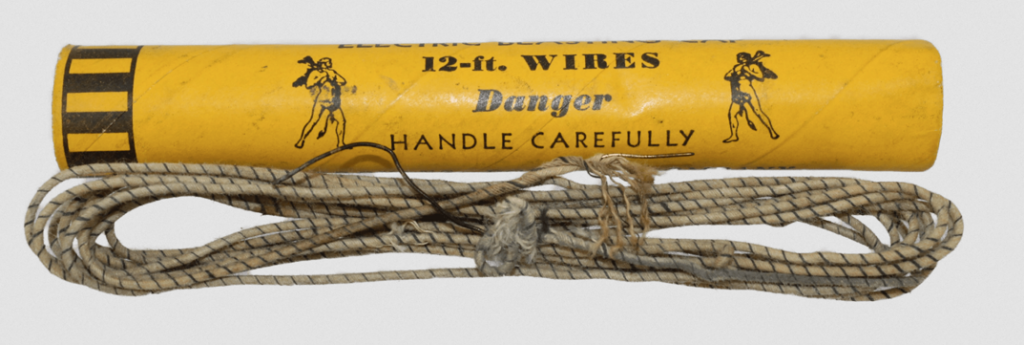 Détonateur Herco-Tube © Military Classic Memorabilia
Détonateur Herco-Tube © Military Classic Memorabilia
 Storage box for Atlas detonators © Militaria du Bocage
Storage box for Atlas detonators © Militaria du Bocage
– Colombelles (14). Monday, September 9 and Monday 23, 2019 and Sunday, Janaury 19, 2020.
Unearthed on 9 and 23 September during earthworks on 63 houses in the new Libéra neighbourhood, the American 1,000-pound bomb (453.5 kg, 230 kg of explosives) and the British 250-pound bomb (113 kg, 25 kg of explosives) were due to be deactivated on 24 November, but for “technical reasons” the operation was postponed indefinitely. The date of Sunday 19 January morning was subsequently announced. 1,020 residents must be exfiltrated by 8am at the latest. Most of them have already left to stay with relatives or friends, or have taken the opportunity to organise an excursion. 120 police and CRS officers are preventing any incursion into the area, which is at physical risk. The Calvados prefecture, elected representatives and government departments – in short, the entire command post – are based in Colombelles town hall, which this time is not included in the security perimeter. 20 minutes to deactivate the American bomb. At 11.56am the British bomb was in turn deactivated. The security perimeter was lifted at 1.10pm after the ammunition had been loaded into the bomb disposal van and the detonators destroyed.
– Fontaine-le-Pin (14). Monday, September 9 and Friday, October 25, 2019.
A 213 kg bomb with 65 kg of explosives was unearthed 15 cm below ground during ploughing on September 9. 23 inhabitants were evacuated. The barren 540-meter radius around the bomb will be defused on Friday, October 25. Dylan and his grandmother were the only ones who took refuge in the multi-purpose hall. It’s not very warm. Dylan plays with a game console while Jacqueline, who has lived in Fontaine-le-Pin for most of her life, thinks back on her past. “You know, I don’t mind! I lived through the war, so I saw quite a few bombs fall from the sky. At the time, we had to be evacuated. We spent a year in Charente-Maritime.”
– Vire (14). Monday, November 18 and Monday, December 9, 2019.
A presumed English bomb was discovered on Monday, November 18 on site of a cold storage warehouse expansion. It was marked and covered with a thick layer of soil. Negotiations between the town hall, mine clearance services and sub-prefecture (whose sub-prefect was on holiday, delaying progress) dragged on until they finally set a date: Monday, December 9. Approximately 300 people had to leave the site by 8 a.m. latest. Many left for work early, while others took the day off. Retirees played belote in a reception room while 2 deminers struggled to remove the detonators. The operation was completed by midday. All that remains is to transport the bomb, which can no longer explode spontaneously, by road to “a secret location” where it will eventually be detonated voluntarily.
2020
– Colomby-sur-Thaon (14). Saturday, April 25, 2020.
A father was out on a stroll with his 2 children when he came across a piece of ammunition at the edge of a field and took it home. It turned out to be an anti-tank mine, roughly twenty centimeters in diameter. His family forced him to call in the gendarmerie, who reprimanded the collector. Deminers came from Caen to recover the mine.
– Colleville-Montgomery (14). Sunday, May 17, 2020.
A damaged shell on the beach in Colleville-Montgomery was reported to the gendarmerie and prefecture. An analysis revealed, “the object does not present any immediate danger.” It was quickly covered by the rising tide. Clearance divers are expected to conduct a thorough site examination on Tuesday and, if necessary, carry out a bombardment.
– Eterville (14). Monday, June 22, 2020.
At 10 o’clock, construction on the pedestrian walkway gets off to a bad start. All work is suspended following the exhumation of a rocket.
– Fontenay-le-Marmion (14). Thursday, July 2, and Friday, July 3, 2020.
Work on the cycle path between Fontenay-le-Marmion and May-sur-Orne is off to a bad start. At a depth of 40 cm, the workmen came across a nest of German rockets. They were secured and taken away by the mine clearance services. Work has been suspended pending a pyrotechnical survey of the immediate continuation of the path.
– Louvagny (14). Monday, July 27, 2020.
Someone found 6 “sticky bombs” in a field and took them home before calling the gendarmerie.
Sticky bombs, or N°74 ST grenades (Sticky Type), are British anti-tank grenades that were used during the Second World War, particularly in Normandy. They were coated with a sticky resin-based substance to adhere to the tank armor on which they were thrown. They are made of glass yet have a plastic handle and contain 570 grams of liquid explosive (nitroglycerine).
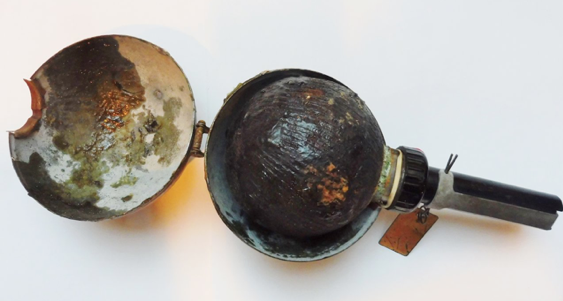 Sticky bomb © British Resistance Archive
Sticky bomb © British Resistance Archive
– Cahagnes (14). Thursday, August 13, 2020.
“A private individual reported the presence of a shell-like object on his property in the commune of Cahagnes, between Caen and Vire, at around 12 noon on Thursday. Several days ago, he discovered the object, about 25 cm long and 8 cm in diameter, and became concerned.”
On the Caen prefecture website, the demining service reminds residents that, in the event of discovering an explosive device, “do not handle it“. “For a munition, cover it with earth or sand (to protect it and hide it from view). Mark it out (to prevent any action on the device). And quickly alert the gendarmerie or police.”
– Amfreville (14). Sunday, August 16, 2020.
An anti-tank mine found at Pont Vert. A magnet fisher apparently removed it from the marsh and then abandoned it.
– Blainville-sur-Orne (14). Saturday, December 26, 2020.
On the edge of the Royal Norfolk roundabout, a Saturday do-it-yourselfer – and on Boxing Day, too – stumbled across crates full of small shells in his garden, a forgotten stockpile from a battalion on the move or in a rout. The gendarmerie hurried to “clear the mines”. They declared that there was no risk of explosion because there was no ignition device. From 3.30pm, the deminers arrived from Caen in a hurry to collect the shells, which were no longer explosive strictly speaking, but which could still be explosive in certain circumstances. Caught off guard on Boxing Day, the town authorities and the prefecture did not ban traffic from the roundabout named Royal Norfolk in tribute to the British liberators of the town in June 1944.
2021
– Roullours (14). Friday, January 8, and Saturday 16, 2021.
At first glance, passers-by thought it was a fire extinguisher. On the contrary, it was an igniter, a 25-pound (11.3 kg) shell fired by a Sherman tank and unexploded in August 1944. 77 years later, it was in plain view at the side of the departmental road 175, below a ploughed field with no hedges. The gendarmerie and the city employees had marked out the threat. The shell was a dud of the war and also a dud of the post-war. Information on its position was lost between the gendarmerie and the deminers, and the shell was still there on Friday 15th, within easy reach of tractors and buses. “We weren’t warned” says a deminer from the Caen interdepartmental centre. “It was when I was looking around on Twitter that I learned that there was a munition in the Vire sector.” The two-person team on duty rushed to the scene on Saturday 16 to take charge of the runaway shell, which had been slipping through the net for 77 years.
– Castillon (14). Sunday, April 11 and Monday, April 12, 2021.
Someone out on a Sunday walk discovered a German smoke shell in the Vallun valley and alerted the Trévières gendarmerie, who requested a bomb disposal squad intervene. The mayor hid the shell under leaves and branches until the bomb squad arrived at the scene on Monday. They took the munition to Colombelles to temporarily store some of the collected pyrotechnic waste. Since 2021, the 5-hectare Vallun wetland is the subject of a renaturation project, supervised by CATER (Technical coordination unit for water and rivers), the sub-prefect of Bayeux, and the municipal council of Castillon. The discovery of this munition, which appears to be a first in the area, dampens the mayor’s enthusiasm for the project: “When a shell of this type is found, experience tells us that there must be others. We’ll have to think again before undertaking any work“.
– Bellengreville (14). Monday, May 10, 2021.
An anti-personnel mine is unearthed in the marshes. Deminers took care of it.
– Aunay-sur-Odon (14). Wednesday, June 6, 2021.
Perez SAS was stripping the natural turf of the former USAO (Aunay-sur-Odon Sports Union) soccer field to enlarge it and turn it into a multi-sports synthetic pitch when one of its workers spotted a long, round object in the mouth of his construction machine, looking like a bomb or shell. The site manager suspended all noise, vibration, and activity. Deminers arrived the next day to process the munition. It was an English staking bomb manufactured in May 1942, containing around 100 incendiary fuses. The bomber leading the squadron dropped it to illuminate the target, “which,” agreed one of the deminers dispatched in the emergency, “didn’t prevent mistakes“.
– Villers-Bocage (14). Tuesday, July 13 and Sunday, September 19, 2021.
– An unexploded World War II bomb, dormant for 77 years, was discovered on July 13 while demolishing an old cattle market in favor of a new residential building. The English bomb weighs 213 kg and has at least 100 kg of explosives. In June 1944, the town of Bocage was 90% destroyed by the war.
– On Sunday, September 19, deminers attempted to defuse the bomb. “Sometimes we get surprises when we unscrew the ignition system, the bomb can be susceptible.” As a precautionary measure and in compliance with pyrotechnic standards, some 20 residents were evacuated. They were notified by letters and could stay in a nearby elementary school cafeteria from 7:30 a.m. onwards, in compliance with Covid-19 precautions and social distancing guidelines. All went well, and the safety perimeter was lifted in the early afternoon.
Villers-Bocage, see the inventory of war waste in Normandy from January 2004 to December 2007 (only in French).
– Louvigny (14). Wednesday, July 21, 2021.
A man magnet fishing in the Orne lands a one kilo shell. The fisherman faces a category 5 fine of 1,500 €. “Even after all these years, these explosives can still be active. It doesn’t matter how small they are, they are still capable of killing or maiming.” The Calvados prefecture also highlights that magnet fishing is banned in the area. “It is forbidden in streams, rivers, lakes, rivers, canals, without authorization from the State, owner of the underwater property.” “On private land, authorization from the owner is required. If the reason for fishing is to find an object of historical, artistic or archaeological significance, the Prefecture’s agreement is required.” “In Calvados, many munitions from the Second World War can still be found. Even if they are 76 years old or unexploded, these war munitions present a real danger.”
– Dialan-sur-Chaîne (14). Thursday, October 28, 2021.
Deminers recovered a shell discovered earlier that day on a building site in close proximity to Souleuvre-en-Bocage.
– Le Hom (14). Saturday, November 13, 2021.
Gardening in Calvados is sometimes synonymous with demining. A man and woman cleared a 40 cm-long shell. The gendarmes took photos of the discovery, which will be taken over by deminers within the following week.
2022
– Terres-de-Druance (14). Wednesday, January 19, 2022.
Workers of GRTgaz, a subsidiary of Engie, noticed two shells blocking a gas pipeline on the edge of a field.
– Tessel (14). Saturday, June 11, 2022.
A weekend gardener unearthed a phosphorous grenade. After a few minutes, smoke began to billow from the grenade. The fire department was called to the rescue, smothering the munition in the ground and alerting the bomb disposal squad to ensure the final safety of the gardener, his family and the village (population 250).
– Potigny (14). Monday, July 18, 2022.
A shell is found lying in a field. Bomb disposal services intervene.
– Damblainville (14). Friday, July 22, 2022.
A group of “youngsters“, as the local press wrote, rummaging through war relics in the late afternoon thought they unearthed a helmet. But as they dug deeper into the object, they realized they had unearthed the metal shell of a 250kg American aerial bomb.
– Thury-Harcourt-le-Hom (14). Tuesday, August 16, 2022.
An English phosphorus grenade (model no. 77, containing 224 grams of white phosphorus) was neutralized and buried on the banks of the Orne. It was emitting orange fumaroles, half in the water, half in the stones. Alerted by 2 fishermen around midday, members of the interdepartmental demining center arrived on scene at around 3pm. The rescue operation lasted over an hour, while the gendarmerie closed off the area to walkers, kayakers and canoeists.
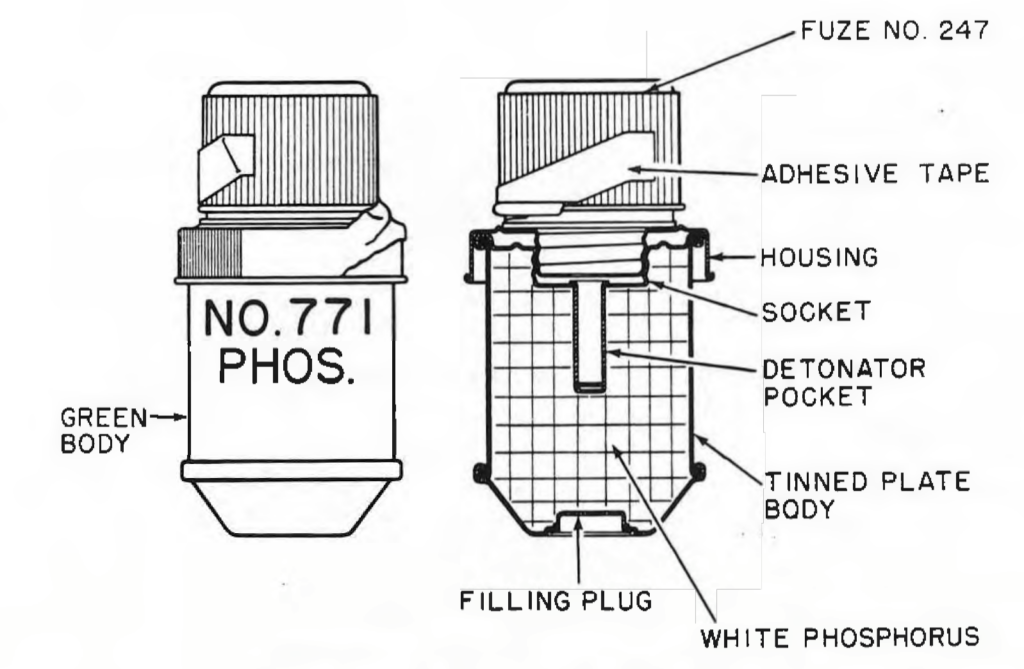 Source : British Explosive Ordnance, Direction of Commander,
Source : British Explosive Ordnance, Direction of Commander,
Naval Ordnance Systems Command
– Colombelles (14). Tuesday, September 20, 2022, and Sunday, January 15, 2023.
– A bomb discovered on September 20, 2022, during roadwork remained impressively inconspicuous for 3 months. It was only protected by 4 concrete blocks and traffic barriers which blocked half the street and diverted vehicles onto the opposite sidewalk. There were no signs of danger, and it’s not clear whether a warning light illuminated the barricade at night. Residents of Jean Moulin Street can now sleep peacefully after Christmas festivities. For Colombelles, it’s business as usual, this representing the area’s 5th bomb since 2014.
– The bomb clearance took place on Sunday, January 15, 2023. A total of 1,083 residents were asked to vacate the premises by 8 a.m., closing their shutters and opening their windows. Many chose to stay home and signed a liability waiver for public authorities. The Belle Colombe retirement home was in the risk zone, however. Their bedridden and severely disabled residents were transferred to another facility. The Michel Hidalgo multi-sports hall serves as a refuge for those with no alternative accommodations. Three ladies between the ages of 63 and 73 bundled up on the playing fields, the bleachers empty. “We’re happy to be here, we’re well taken care of with coffee and cakes. And it allows us to get out of the house and not be alone.” This is their 2nd evacuation, and they view it as a pleasant outing. A bus picked them up at 8:50 am, and by 2:45 pm, they had taken the bus back home. The 80 police officers who prohibited access to high-risk streets and patrolled the area to prevent looting left.
The straw bales that enclosed the deminers working on the 78-year-old forgotten bomb were sent back to the farm. The bomb, with its 70 kg of explosives, was secured in a van, wedged in place, and traveled by road to an unknown destination (“We have agreements with military sites in the east and south of France“) where it will be deliberately blasted, releasing gaseous, metallic and biocidal pollutants into the soil and air.
At the start of the war, the Normandy Metallurgical Company (SMN) in Colombelles employed 4,000 emigrant workers housed in workers’ housing estates. During the war, the SMN housed 3 German army command posts. Despite the coal shortage, the occupying forces managed to maintain shell production. The SMN offered a panoramic, strategic view over the city and the Caen plain. After D-Day, the Royal Air Force bombed the SMN. After the ruin, SMN resumed its activity in 1950 with one, 2, 3 blast furnaces. Faced with foreign production, particularly from China, SMN closed in 1993. The plant was dismantled pipe by pipe, piece by piece, by Chinese workers and transported by cargo ship from the port of Caen to China, where it was reassembled in Handan, Hebei province. 1994 marks a key date in industrial relocation. Today, the Normandy Memory project is seeking to establish itself on the former SMN site. Described by its opponents as the “Disneyland of World War Two”, the project has inspired controversy and, if it goes ahead, will have to be preceded by a pyrotechnical diagnosis to avoid unexpected construction interruptions.
Colombelles is a regular subscriber to Robin des Bois inventories (See the inventory of war remains in Normandy from May 2001 to May 2004, only in French, the inventory of war remains in Normandy from January 2004 to December 2007, only in French and the inventory of war remains in the Atlantic and Channel regions, 1 January 2008-31 December 2013).
 Bombardment of the Normandy Metallurgical Company (SMN)
Bombardment of the Normandy Metallurgical Company (SMN)
© Archives du Calvados – 57J/2923/14
– Cagny (14). Wednesday, September 21 and Sunday, November 20, 2022.
– The bomb was 460 kg, 135 cm-long, 48 cm in diameter, with 240 kg of explosive. It was found one meter deep by Toffolutti, public works, while servicing a housing development project on Aubépines road. It was found on September 21.
– Bomb deactivation took place on Sunday, November 20. To reduce the blast and missile effects if something were to go wrong, a merlon (embankment) was installed around the bomb. “It’s a question of removing the firing system installed on the base and then unscrewing the detonator at its end,” the deminers summarized. From 8 a.m. onwards, 15 gendarmes knocked on the doors of 536 homes, most of them pavilions, to execute an evacuation order. People place high confidence in the deminers’ competence, but those who refuse to leave must sign a discharge “in case there’s a problem.” Of the 1,500 residents within the safety perimeter, many left the day before or very early in the morning, and only around twenty were accommodated in the gymnasium in Frénouville, the neighboring commune, including Karima and her 3 children and Christel, who was studying. Meanwhile, 35 gendarmes blocked access and walked around the neighborhoods to prevent looting and risk-taking by those refusing to evacuate. The firing system was extracted at 10:35 am, and the detonator detonated voluntarily at 11:15 am. The device was lifted at noon; the bomb was no longer a bomb. However, transporting it by road to a confidential location is not without risk, particularly in the event of collision or fire. Bomb deactivations take place on Sundays whenever possible, when trucks, especially those carrying flammable materials, are banned from the roads, except by special dispensation.
– Ouistreham (14). Tuesday, September 27 and Monday, November 7, 2022.
Workers burying a power line uncovered a 2,000 lb (907 kg), 1.8 m-long, 57 cm-diameter American aviation bomb with 488 kg of explosives. The “monster” is set to be defused on Monday, November 7. Some fifteen public roads and part of the ferry terminal will be cordoned off, devoid of any human activity within a 400-meter radius of the bomb. The statutory 800-meter radius was halved thanks to a wall of high-density straw bales designed to cushion the effects of a potential blast. Two deminers were put in charge of dismantling the warhead’s 2 firing systems at the front of the bomb and the base at the rear. The straw wall reduced the number of evacuees from 2,400 to 600 and reduced the no-go zone on the shore. Forced evacuations began at 7 a.m., and those who had no alternative but to be accommodated at the indoor tennis courts or the Pavillon had to leave their animals at home. By 1 p.m., the operation was over. The bomb was secured, strapped down and wedged on a pallet in the back of a van, which was then driven to a military site where it would be destroyed in a sand-covered pit.
Ouistreham, see the inventory of war waste in Normandy from May 2001 to May 2004 (only in French).
AN-M66
Source : U.S. Explosive Ordnance
– Caen (14). Wednesday, October 5, 2022 and Sunday, January 22, 2023.
On Wednesday, October 5, a 500-lb (227 kg) bomb was discovered on a building site at the corner of Bayeux road and Detolle boulevard, 800 m from a prison housing 350 inmates. The pyrotechnic safety code stipulates that, for a given explosive charge (110 kg), an 800-meter safety distance must be maintained around the munition. It may reduce to 400 meters if protective measures can be put in place around or above the bomb. In line with these procedures, thousands of residents should have been evacuated, human activities frozen, neighborhoods emptied of their residents and workers, and watched over by police to prevent trespassing and looting.
It would have been even more difficult for State agencies and law enforcement bodies to transfer the prisoners to other, already overcrowded, remote prisons as a preventative measure. After the Calvados Prefect, Western Defense and Security Zone Prefect and emissaries from the Ministry of Justice and Caen Town Hall thoroughly examined the situation, they decided to depart from normal practice and regulations. The bomb will be transported on a secure route with its fuses and detonators inside the Parc des Expositions, which means 2 km and 10 minutes of fear for 2 deminers in an unarmored van, for the police escort and the SDIS (Departmental Fire and Emergency Service) fire department vehicle. Defusing went smoothly, surrounded by a double belt of XXL straw bales, giving the Parc des Expositions an apparent agricultural show. It was only necessary that the deminers periodically suspend their surgical and watchmaking manipulations to avoid vibrations from the Paris-Cherbourg line trains and others. “Now, it’s nothing more than a big mass of explosives without a detonator or a firing system.” The large mass will set off unescorted again for an unknown destination.
Caen is a regular subscriber to Robin des Bois inventories (See the inventory of war remains in Normandy from May 2001 to May 2004, only in French, the inventory of war remains in Normandy from January 2004 to December 2007, only in French and the inventory of war remains in the Atlantic and Channel regions, 1 January 2008-31 December 2013)
2023
– Campandré-Valcongrain (14). Tuesday, January 10, 2023.
A grenade was spotted in the Valcongrain national forest, which spans 375 hectares. Deminers are expected. The area saw intense fighting on Aunay-sur-Odon-Thury-Harcourt Road. Since 2019, Calvados firefighters have intensified their vigilance of forest fires. They hold good knowledge of the Valcongrain forest’s topography. On June 30, 2023, a fire was reported at the top of the forest but was brought under control in 10 minutes. There likely are no other munitions among the oaks, beeches and pines, which are likely to explode under the flames, heat and ashes. The forest contains numerous hiking trails. It would be prudent to reinforce the ban on smoking, barbecues, and quads and other all-terrain vehicles with heat or electric motors.
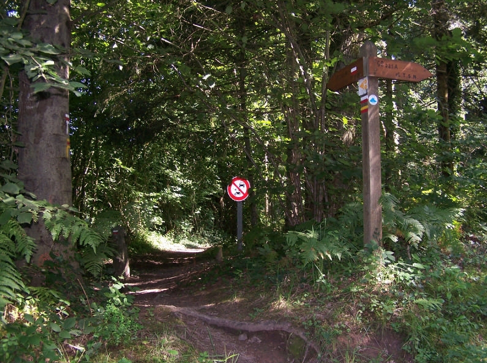 Hiking trail in the Valcongrain forest
Hiking trail in the Valcongrain forest
© OTPV (Offices de Tourisme du Pays de Vire)
– Avenay and Esquay-Notre-Dame (14). Monday, January 16, 2023, and Sunday, April 7, 2024.
During a soil leveling operation, a 40 cm-long shell appeared. “The demining services have been notified with the view to intervene in the near future.” “According to Liberté Caen, this was a typical discovery in an area hit by bombardments during the Second World War.”
15 months later, 3 13-14-year-old teenagers from Avenay went on a Sunday adventure near a ruined mill. They handled an old piece of ammunition removed from the Guigne and threw a burning piece of paper over it. The explosion was heard in Avenay and Esquay-Notre-Dame. “On Sunday April 7, 2024, at around 5pm, the 3 teenagers went to the ruins of the old mill with the explosive device. They had the idea of setting fire to it to turn it into an Olympic flame. To do this, they used a lighter and a page from a book they had borrowed from their village book box in Avenay. This is how the explosion occurred. Only the Gendarmerie’s investigation will determine the exact circumstances,” Ouest-France reported on April 8. Two of the young men were discharged from the hospital the next day, while the 3rd, wounded in his hand, arm and chest, remains in intensive care at Caen University Hospital. According to deminers, the ammunition was an American anti-tank rifle grenade. “One of our priorities now is to find out exactly where the grenade was found. Once this is known, deminers will go to the site to check that no other ammunition is there“, the gendarmerie explains. Esquay-Notre-Dame was the scene of clashes between Anglo-Canadian forces seeking to bypass the town of Caen and the 9th SS Panzer Division. The village was liberated in early August 1944.
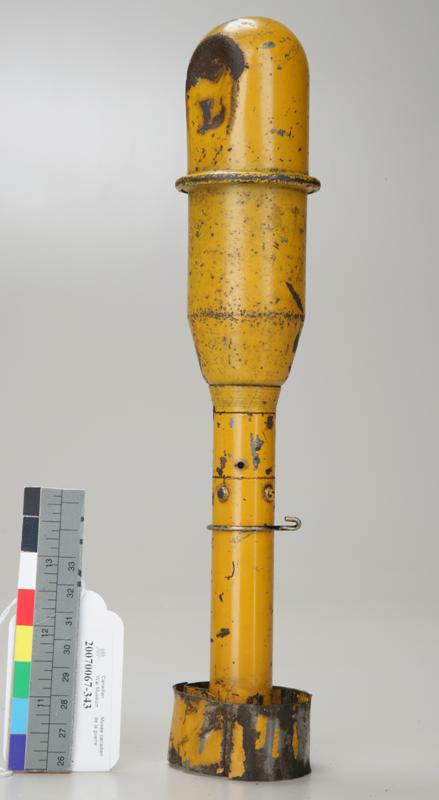 American anti-tank rifle grenade
American anti-tank rifle grenade
MCG 20070067-343
Musée canadien de la guerre
– Hermanville-sur-Mer (14). Tuesday, January 17, 2023.
Workers reported a grenade in a telecom site. The gendarmerie and bomb squad were notified.
– Fontaine-Etoupefour (14). Tuesday, February 14, 2023.
At Chemin-Haussé, located on the ancient Roman road linking Chartres and Bayeux, digging workmen came across a dozen shells at 10:00 in the morning. The mine-clearance services intervened in the early afternoon. Fontaine-Etoupefour, situated 5 km from Esquay-Notre-Dame, was liberated on July 9, 1944.
– Cabourg (14). Thursday, March 9, 2023.
The Castel Fleuri hotel extension project on Piat avenue was disrupted by an 11.4 cm-long British-made shell. An excavator sounded the alarm at 11am. The site was immediately suspended and evacuated. A photo was sent to the prefecture’s inter-ministerial civil defense and protection service, and deminers quickly arrived at the scene after finishing a nearby operation. They took possession of the shell. After verifying that there were no other munitions within the worksite perimeter, the national and municipal police as well as the elected representative responsible for civic-mindedness and safety lifted the surveillance together.
SEINE-MARITIME
Le Havre (76).
Wednesday, August 19, 2020, Wednesday, September 1 and Wednesday, October 6, 2021.
During the reinforcement of the Joannès Couvert quay and the construction of the 500-meter long, 125-meter wide main building, the annex building and the storage area for wind turbine blades and nacelles, 3 English bombs weighing 500 pounds (226 kg) were uncovered and demilitarized in the sense that the firing systems were extracted by the de-miners from the Caen interdepartmental center. Now inactive, they were still a major source of risk in the event of collision, fire or any other event likely to pierce the shell of the bombs. They each contained 110 kg of explosives. They left the heart of the port of Le Havre strapped and palletized in unescorted vans with the explosive hazard code, in the middle of normal road traffic.
Three operations were carried out with the clear intention of maintaining confidentiality as far as possible. The precise dates of the discoveries and the methods used to secure the bombs until they could be taken over by the deminers were not communicated. It was only on the eve of their demilitarization and exfiltration by road from the port and industrial zone of Le Havre that the sub-prefecture of Le Havre announced measures to filter or prohibit traffic on the quays Hermann du Pasquier and Joannès Couvert, the avenue Lucien Corbeaux and the route du Môle central. In addition to pyrotechnic standards, the safety perimeters were trapezoidal in geometry, as if in the event of the operation going wrong, the shrapnel and blast effects of these bombs would obey a cadastral and administrative logic and would renounce being harmful within a regulatory 800-meter radius, possibly reduced by derogation to 400 meters if constructive provisions are put in place around the bomb. The last operation was subject to a safety perimeter of just 270 meters in the port of Le Havre. The measures taken by the harbor master’s office to reduce risks in the Théophile Ducrocq basin and tugboat wharf, and in the Bellot basin where oil barges are parked, have not been communicated to the public.
2019
– Le Havre (76). Mid-June and Wednesday, July 31, 2019.
“The evacuation of the population concerned will be organized on Wednesday July 31 from 8am. No one should be in the safety zone after 9:30 am. This mandatory evacuation applies to everyone. A letter has been sent to each local resident”, says the prefecture. The evacuation measure concerns 450 residents of residential buildings and 150 residents of a retirement home. The bomb had been spotted under the pitches of the Youri-Gagarine stadium on the eve of renovation work by Dianex prevention specialists. Dianex specializes in the detection of war devices. It had been selected by the city of Le Havre following a call for tenders for the anticipatory detection of war devices likely to be buried on municipal rights-of-way prior to the start of construction work. The 220 kg English bomb was 30 cm underground, right where the rugby and American soccer teams were training. The deminers from the Caen interdepartmental center dismantled the priming and firing system. “This is always a delicate operation, but in this case we had no particular problems.” At 12, the device was lifted after the deactivated bomb, still containing 119 kg of explosives, had departed. It is a high-risk shipment in the event of malicious damage, fire or violent impact. The ex-bomb was loaded and strapped into a van bound for a military site, where it will be destroyed.
– Saint-Valery-en-Caux (76). Monday, June 24, 2019.
On the site of the Sontheim residence (25 housing units and a day nursery), the 500 kg German bomb was stopped by the bucket of the excavator, and the hard-hitting excavator immediately stopped the charge. The ammunition was not the first Austreberthe Caux Travaux Publics had encountered. Diagnosis of the “beast” was carried out the following day by the bomb disposal squad. The device did not present any imminent danger. Its firing system had disappeared, and the explosives had been partly extracted after the war, a risky practice aimed at recovering military explosives free of charge for use in civilian activities.
– La Mailleraye-sur-Seine (76). Wednesday, November 13, 2019.
An anti-tank mine in the forest near the hamlet of Bourg-l’Abbé. ONF agents mark out the munition while waiting for the de-miners from the Caen interdepartmental center, which covers Calvados, Manche, Orne, Mayenne and Sarthe.
– Tourville-la-Rivière (76). Tuesday, December 17, 2019 and Wednesday, May 6, 2020.
– The construction site for Parc en Seine, a health, leisure and restaurant hub, 5 hectares of happiness, begins with a shell of misfortune in soaked ground. A safety perimeter was set up at the request of the bomb disposal service. According to one of the park’s promoters, the shell will soon be removed or destroyed on site. A study of the pyrotechnic risks in the area is currently underway. The Parc en Seine is a fine example of the lack of foresight on the part of developers and local authorities. The pyrotechnic survey was launched after the site had been opened.
– The so-called shell was in fact a 250 kg English bomb. Six months after its discovery, it was defused after the evacuation of around a hundred residents. Thirteen roadblocks, detour of departmental roads 7, 13 and 144, closure of part of the Tourville shopping area. The Carrefour supermarket will remain open during the operation, but “detour will be put in place to access it”. Evacuated properties will be guarded by the forces of law and order. According to our information, traffic on the railroad line included in the safety perimeter has not been interrupted.
2020
– Blainville-Crevon (76). Saturday, January 25, 2020.
Inheritance and succession are not always relaxing times for families, and in Normandy, as in other war-torn regions, they are further complicated by pyrotechnic legacies. Another booby-trapped house! In their report, the gendarmes established that thousands of 7 and 9 mm cartridges were on the premises, along with an M24 grenade, more commonly known as a “potato masher”, used by the German army as early as the First World War. It was also used during the Second World War. Pending diagnosis and action by the deminers, access to the house is forbidden to all.
– Saint-Romain-de-Colbosc (76). Saturday January 25 and Sunday January 26, 2020.
A shell was discovered by a man digging a hole in his garden. He alerted the gendarmerie after cleaning and storing it in his garden shed. A safety perimeter was set up until the bomb disposal squad could intervene.
– Les Grandes-Ventes (76). Saturday, February 22, 2020.
The finder of a shell on his property loads it into his van and takes it to the waste collection center, which refuses to accept it. The explosive van is then directed to the town hall, which also refuses to accept the shell, and finally alerts the Neufchâtel-en-Bray gendarmes. On receipt of the photograph, the SIRACEDPC (Regional interministerial department for civil and economic affairs, defense and civil protection) deemed that it presented no danger. The man goes home with his shell, which is not really his, since the mine clearance service will come and remove it by the end of the month.
– Saint-Saëns (76). Sunday, September 6, 2020.
Discovery of a shell in the forest. The gendarmes marked the find with orange paint and transmitted the GPS coordinates to the prefecture, which “will call in the bomb disposal service shortly.”
– Oudalle (76). Friday, October 2, 2020.
Lubrizol, Seveso high threshold. Discovery of a “small explosive device“. Lubrizol Oudalle was built on a former firing range.
– Oudalle (76). Wednesday, October 14, 2020.
A second shell is discovered on the Lubrizol site, near the Tancarville Canal industrial road.
– Sainte-Marguerite-sur-Duclair (76). Sunday November 15 and Tuesday November 17, 2020.
Discovery of a World War I shell on a structural beam of a house during renovation work. The mine-clearance team was called in on Tuesday to remove it.
– Fontaine-le-Dun (76). Tuesday, November 17, 2020.
A shell “30 cm long and 10 cm in diameter”, according to the gendarmes, in a pile of rubble deposited on the edge of a field.
2021
– Saint-Romain-de-Colbosc (76). Tuesday, April 20, 2021.
A mechanic cleaning up his workshop finds 2 loaves of American TNT, 400 grams each, and brings them to the gendarmerie in their rusty box. With no fuse or detonator, they were considered harmless, but the deminers quickly took charge of them.
– Eslettes (76). Thursday, April 22, 2021.
Discovery of a shell in a field beside the Route Départementale 44 by workers from Infra-Build, a Somme-based company specializing in underground networks for the distribution of electricity, gas, water and data.
– Caudebec-en-Caux (76). Sunday, April 25, 2021.
Cavée Saint-Léger street, near the forest, discovery of 3 explosive devices in the late afternoon. The presence of 3 shells, 2 measuring 40 cm long and 10 cm in diameter, and the third measuring 40 cm long and 3 cm in diameter, was noted by the gendarmes. They marked out the area. The bomb disposal service was expected to arrive later in the evening.
– Blosseville (76). Wednesday, May 12, 2021.
The shell lying in a field on the Route d’Angiens was marked by 4 stakes surrounded by a red and white ribbon.
– Mauny (76). Wednesday, July 21, 2021.
In the la Plaine des Mares street, workers digging up the public highway uncovered a 57 cm long, 75 mm diameter shell. They took it out of the trench to keep it safe until the de-miners arrived. Yet another example of accommodation with official doctrine, which recommends not touching old ammunition and avoiding any handling until specialists arrive.
– Epouville (76). Monday, August 30, 2021.
While unloading a truckload of soil from Harfleur, the site foreman building the river water retention basin discovers a shell 45 cm long and 10 cm in diameter. The gendarmerie was alerted, and the de-miners were called in. A security perimeter is set up pending their arrival.
– Le Tréport (76). Tuesday, September 7, 2021.
Discovery of a 60 cm long shell in the foundation of a house.
2022
– Petiville (76). Friday January 7 and Monday January 10, 2022.
On Friday, a shell was discovered at Unifer Port-Jérôme, a scrap metal salvager, in the hamlet of Petit Ourville. 25 cm long, 10 cm in diameter. De-miners intervened on Monday. Petiville is next to Port-Jérôme. There are 9 Seveso plants in Port-Jérôme, including 6 with high thresholds.
– Sandouville (76). Friday, January 21, 2022.
During roadworks at the Sedibex high-threshold Seveso plant and multimodal terminal, workers unearth a 50 cm long shell and alert port security.
– Le Torp-Mesnil (76). Wednesday, January 26, 2022.
At around 3 p.m., a Torp man fetching wood from his garden discovered a shell among the logs. The de-mining service came to the scene to ensure that he would not confuse a wood fire with a pyrotechnic explosion during the winter.
– Val-de-la-Haye (76). Monday, February 14, 2022.
19 shells abandoned on the edge of a road near route departmental 351. They were spotted by the gendarmerie at 8.56 am. “They were probably dug up by a metal detectorist“.
– Saint-Aubin-sur-Mer (76). Thursday, February 17, 2022.
The new owner of a farmhouse discovers 52 grenades made in 1937 in an outbuilding. The forces of law and order prohibit all use of the property and block access until further notice.
– Hénouville (76). Sunday, February 20, 2022.
On Sunday, a female gleaner discovers a shell in a field (30 cm long, 10 cm in diameter). The farmer is informed. The gendarmerie marksout the waste.
– Bardouville (76). Monday, February 21, 2022.
Discovery of 2 shells in Bardouville on the beach by the loops of the Seine. They are said to have been battered by storms and rain.
– Marques (76). Wednesday, February 23, 2022.
Impasse de l’Eglise, a man gardening in soil saturated with water from torrential rains found himself with a French-made grenade in his shovel. The gendarmerie informs the prefecture, who alerts the deminers who will come when they have taken care of other priorities. Their diary is also saturated.
– Oudalle (76). Friday, March 11, 2022.
Discovery of ammunition very close to Bolloré Logistics, Seveso low threshold, and Sibanye-Stillwater, ex-Eramet, in Sandouville. Eramet sold the plant in 2021 to Sibanye-Stillwater, a South African metallurgical group. This sale had no impact on the plant’s Seveso high threshold status.
– Oudalle (76). Wednesday, March 16, 2022.
Another shell (65 cm long, 16 cm in diameter) discovered in the industrial zone on the site of the Pont de Normandie logistics park.
– Rogerville (76). Monday, March 21, 2022.
Discovery of a 30 cm long shell at a company specializing in the treatment of construction site waste. The war machine was put aside until the de-miners could intervene. Its origin is unknown, due to the lack of traceability of incoming batches.
– Le Havre (76). Tuesday 29 and Wednesday March 30, 2022.
A phosphorus shell in the heart of the city, a UNESCO World Heritage site, was brought to the surface by an excavator. White smoke was released. 25 firefighters were on site, including 17 specialized in technological risks. One of them was intoxicated and taken to hospital. The munition was covered with earth. The emergency services have set up barricades and guarding near the site, pending the intervention of the de-miners the following day. The population is advised to avoid the area. The question is whether this chemical munition is isolated or part of a batch of polluted soil used to rebuild the town by Auguste Perret.
– Gueures (76). Monday, April 11, 2022.
A shell in a farm building, 26.5 cm long, 8 cm in diameter.
– Fontaine-la-Mallet (76). April 24 and Wednesday, June 8, 2022.
“Ladies and gentlemen, it’s almost time to evacuate for mine clearance. I remind you that it’s compulsory for everyone” announces the municipality’s radio car at 6:30 am. Buses will be available for those without means of transport at the Fréville stop, Place Saint-Valéry and the town hall. The circus act is exceptional. It involves taming a 220 kg bomb armed with 119 kg of explosives found on an archaeological dig site. Inhabitants had to be evacuated within a 400-meter radius, normally 800 meters, but here, as is often the case, the safety perimeter had been halved by installing protective measures such as straw bales or a merlon to reduce the dispersion of shrapnel and missile effects should the demining duo’s act go wrong, very wrong. 35 refugees end up in the gymnasium. Many of the evacuees have found other solutions. The atmosphere is good-natured, with games for the children, who are virtually absent, and cakes and hot drinks for the others. People chat. They’re from the same neighborhood but never talk to each other. It’s a good opportunity for these “familiar strangers” to meet. The demining operation is lifted at 11.22am. Monsieur le Maire, without really believing it, hopes it will be the last.
– Offranville (76). Saturday, May 14, 2022.
More weekend gardening interrupted by a shell. The gendarmerie arrives on the scene and tags it before the bomb disposal unit arrives.
– Sandouville (76). Wednesday, May 18, 2022.
During earthworks on the Pont de Normandie logistics park, workers uncover a shell 50 cm long and 10 cm in diameter.
– Saint-Nicolas-de-la-Haie (76). Saturday, May 21, 2022.
A hand grenade is discovered with other garbage at the bottom of the well in the garden of a house that has just changed hands.
– Gouy (76). Tuesday, May 24, 2022.
A strange fisherman brings 3 shells to the surface. He was probably a magnet fisherman or an eel poacher. The gendarmerie was alerted at 8.30pm. As a reminder, the consumption and sale of fish, particularly eels, is prohibited in the Seine between Paris and Rouen due to PCB (polychlorinated biphenyl) pollution.
– Le Havre (76). Tuesday, June 7, 2022.
Removal of a 220 kg English bomb unearthed a few days earlier on a building site in the Grand-Hameau district. In the vicinity of the waste of war, all residents are subject to a “mandatory and imperative” evacuation. A few days before the de-miners’ millimetric operation, they received a letter that was both instructive and warning. For those who have no other option, the gymnasium on rue Hannes-Montlairy will be used as a reception area from 7:30 a.m., and the area must be empty of all human presence and activity by 8:30 a.m. at the latest. Detours have been set up, and the Havre Nord waste disposal center, which is within the safety perimeter, is closed to the public. 44 people have taken refuge in the gymnasium, while the others have left the area by closing their shutters and keeping their windows open, and have found other ways of retreating. The deputy mayor invites himself into the sports hall and listens to the complaints of 2/3 constituents, who say they received no prior information and were informed at the last minute. The mayor concedes that there may have been one or two slip-ups, but the atmosphere remains warm and grateful. There are almost more rescue workers than refugees. Eloïse, 16, a volunteer with ADPSE (Estuary First Aid Association), distributes hot and cold drinks and cookies. The older members of the team are playing belote, while the children are busy with their screens or coloring books. Meanwhile, the deminers are hard at work deactivating the bomb which, had it exploded on landing, would have added dozens of deaths to the 2053 victims of the Allied bombing of Le Havre on September 5 and 6, 1944. The security arrangements were lifted at 10.40am by the operational command post set up at Le Havre-Octeville airport.
– Oudalle (76). Wednesday, June 22, 2022.
Discovery of a 30 cm diameter shell in the industrial and logistics zone. There are 2 Seveso high-threshold plants in Oudalle, Lubrizol and Total Fluides, and the Parc logistique du pont de Normandie n°2 is under construction.
– Oudalle (76). Tuesday, June 28, 2022.
Discovery of a 40 cm long shell in the industrial and logistics zone.
– Roumare (76). Tuesday, July 5, 2022.
The owner of a 50 cm long shell had been storing it in an outbuilding for 12 years. He thought it was prudent to inform the deminers before renting it out.
– Manéhouville (76). Sunday August 21 and Monday August 22, 2022.
A suspected weapon is spotted in the Scie, a coastal river that is almost dry. The gendarmerie proceeded to mark it out. The next day, deminers are on site to assess the risks.
– Roncherolles-en-Bray (76). Tuesday, August 30, 2022.
Discovery in a field of a World War II German shell, 30 cm long, 8 cm in diameter.
– Le Havre (76). Wednesday, October 7 and Thursday, November 24, 2022.
It’s “clear” around the Youri-Gagarine stadium in the Plateau de Dollemard district. Since 7:30 a.m., 70 police officers have been going door-to-door to remind occupants of evacuation instructions. An EHPAD is evacuated. For several days, its 152 residents had been moved to other establishments in Le Havre. The bomb – 230 kg, 104 cm long, 33 cm in diameter, 110 kg of explosives, 2 firing systems, one of which was damaged by the construction machine – had been spotted by magnetic radar and the workers thought it had been removed.
What a mess! Around midday, the command post was informed that an elderly deaf Alzheimer’s patient had not been evacuated. She hadn’t heard the police knocking on her door. She’s about to receive a visit, the bomb squad’s mission has succeeded and security is lifted at around 1pm.
– Yville-sur-Seine (76). Saturday, December 3, 2022.
Shells are best brought to public attention on Saturdays or Sundays. This one resurfaced in a garden on rue Hulin. As a precaution, the acting mayor suspended traffic in the street, and on Thursday the shell was still there. The Caen de-miners were too few in number and had better things to do in the hierarchy of priorities.
– Montivilliers (76). Monday, December 5, 2022.
The owner had bought the shell at a garage sale on Sunday and, suddenly aware of the danger, had brought it back in his car and deposited it in front of the fire station at around 2pm. Emotions ran high in the neighborhood and throughout the community. Part of Avenue Victor Hugo and Place Commandant O’Reilly, named after a French hero of the First World War who died with 47 of his men in the Battle of the Scheldt in August 1914, were neutralized, intercommunal buses were diverted and some twenty homes evacuated. A huge mess in Montivilliers, which the national and municipal police managed to bring under control. At 8pm, the bomb squad removed the shell.
2023
– Rouen (76). Wednesday, January 11 and Friday, March 3, 2023.
A 50 kg American bomb is heckled by a construction machine near the fortunately still uninhabited buildings of the Flaubert eco-district, close to several logistics corridors. The date was January 11, 2023. It is not transportable, containing 16 kg of explosives. “The device, which dates back to the Second World War, was immediately assessed by the Sécurité Civile demining services. Pending its final neutralization, protective measures have been taken to avoid any danger.” Destruction is scheduled for the morning of March 3. “The detonation operation will generate a loud noise likely to startle people within a relatively wide perimeter.” “The time of destruction is not yet fixed, as it depends on operational constraints. The prefecture will communicate in the preceding minutes on social networks. At the time of the explosion, traffic will be cut off, very punctually on boulevard Jean-de-Béthencourt.” In an area traumatized by the Lubrizol fire, the blast nonetheless raised concerns.
On Sunday, March 3, 2024, another bomb, this time weighing 70 kg, was detonated in the same eco-neighborhood under construction near the Flaubert bridge and 2 Seveso plants, including Lubrizol to remain.
Rouen is a regular subscriber to Robin des Bois inventories (See the inventory of war remains in Normandy from May 2001 to May 2004,only in French, the inventory of war remains in Normandy from January 2004 to December 2007, only in French, and the inventory of war remains in the Atlantic and Channel regions, 1 January 2008-31 December 2013).
– Doudeville (76). Tuesday February 7 and Wednesday February 8, 2023.
An unpleasant surprise at the waste disposal center. The chemist supervising the outgoing batches spotted a small vial of 2,4,6 trinitrophenol, a corrosive yellow substance commonly known as “picric acid” and used as a shell-loading explosive during the colonial and 14-18 wars. The bottle, mixed with other bottles of hazardous products, was on its way to the Triadis consolidation site in Rouen, where explosive waste is prohibited. Pending the intervention of the deminers on Wednesday morning, the intermunicipal waste collection center remained closed. To avoid any transport risk, the waste was destroyed in a requisitioned nearby field. The detonation took place at 11am.
– Cuverville-en-Caux (76). Sunday, February 26, 2023.
A man is gardening when he comes face to face with a heavy, ornate object. He rushed to the Internet and thought he had identified an anti-tank mine. The gendarmerie is alerted. The mine-clearance services were informed and were due to visit the site on Tuesday to find out more about the object and take appropriate action.
– Eu (76). Monday May 15, 2023.
A shell measuring 30 cm long and 5 cm in diameter was discovered near the former wastewater treatment plant, just where a burnt-out car had been removed. The device of war was marked by 4 iron stakes surrounded by a red and white ribbon, pending the intervention of the de-miners.
– Le Tréport (76). Thursday, June 29, 2023.
The GRIMP (Dangerous Recognition and Intervention Group) descends to the bottom of a hole in the heights of the town. A survey of the site confirms the presence of old ammunitions. They were found to contain 6.5 kg of explosives, and underground galleries threatened to contain an ammunition bunker. The mine clearance services have been scrupulously informed and, pending their decision, the town of Le Tréport has issued a ban on access to the area around the cavity.
EURE DEPARTMENT
2019
– Louviers (27). Monday, February 18, 2019.
Fishing with a magnet in the late morning, the teenager brought up from the Eure, a tributary of the Seine, a 20 cm long aerial shell which was taken care of by the Versailles de-miners around 4 pm. The so-called Versailles interdepartmental center is actually based at Marly-le-Roi. The premises were inaugurated in 2016 by Bernard Cazeneuve, Minister of the Interior. Some 50 de-miners cover 11 Departments: Essonne, Hauts-de-Seine, Seine-et-Marne, Seine-Saint-Denis, Val-de-Marne, Val-d’Oise, Paris, Yvelines, Eure, Nièvre and Yonne. Bomb disposal experts are permanently stationed at Roissy and Orly airports.
– Acquigny (27). Wednesday 10th and Tuesday 30th July, 2019.
On the 10th, a teenager fishing with a magnet pulled a grenade up from the Eure at a place called “la piscine d’Acquigny”. On the 12th, the mayor bans magnet fishing and swimming on the entire section of the Eure that crosses the commune and prohibits “crossing the safety perimeter set up by the commune and materialized by barriers and ribboning”. “Access to the river bank by any means, including canoes and other watercraft,” is prohibited. On the 30th, the Versailles de-miners detonated the English grenade, and the noise worried the population of Acquigny and Pinterville (2 km away). Already in August 2018, swimmers at the swimming pool had spotted 7 grenades in the Eure riverbed.
– Rugles (27). Thursday, August 8, 2019.
Clearing undergrowth at the bottom of the garden led to the discovery of 2 training shells and a 200 mm bullet. Two deminers from Versailles ensured their removal. “The 3 rounds still contained black powder”, they said. In the event of a garden fire, they could have done some damage. “In this business, you never do the same thing twice.” “There’s no routine, we sometimes find people glued to the wall.” The educational message is scathing: don’t have fun fiddling with war waste.
2020
– Guichainville (27). Wednesday, September 30, 2020.
On the site of La Poste’s new sorting center, EBTP workers came across a metal object at around 10:30 am. With a few shovelfuls, they uncovered a bomb. Work was immediately suspended, the Rue Jacques Robert was closed to traffic and the 16 workers stationed at a traffic circle waited for the arrival of the bomb disposal team, who took charge of what appeared to be a German SC 250. They transported it to the Carrières et Ballastières plant in Criquebeuf-sur-Seine, where it was defused and detonated in an isolated area, without endangering employees or civilians.
© Australian War Memorial
SC 250 : calibre 368, overall length 163.8 cm, steel 250 kg, explosive mass 130 kg, Amatol, transverse detonator.
– Guichainville (27). Tuesday, November 3, 2020.
After the unpleasant surprise of Wednesday September 30, a preventive magnetic detection was carried out on the site of the postal sorting center and 3 500 kg bombs were spotted. They were removed by a large team of 10 de-miners from the Versailles center. Like the first, they were transported to Carrières et Ballastières de Normandie, 40 km away in Criquebeuf-sur-Seine, where they were destroyed.
2021
– Glos-sur-Risle (27). Saturday January 9 and Tuesday March 2, 2021.
A 250 kg shell containing 100 kg of explosive was reported by a local in a field on January 9. It was reconnoitred by the de-miners on February 16. It was defused early in the morning of March 3 and transported “elsewhere” for “safe detonation“, according to the Pont-Audemer gendarmerie captain.
– Saint-Pierre-du-Vauvray (27). Friday, March 12, 2021.
World War II shell discovered and marked on the side of the Paris-Rouen-Le Havre SNCF line. Traffic suspended, then gradually resumed. In view of the documentation provided, the de-miners consider that there is no immediate danger. They will move on next week.
– Saint-Ouen-du-Tilleul (27). Early June, 2021.
A mine in the garden was dug up on a sunny Sunday morning without being woken up. The de-miners came to the site the following week and were not particularly surprised. Retreating German soldiers planted mines in fields and paths to delay the advance of Canadian soldiers.
– Vernon (27). Wednesday, September 15 and Thursday, September 16, 2021.
Two rockets hit the ArianeGroup site, known as a former firing range. Vernon, see the inventory of war waste in Normandy from May 2001 to May 2004 (only French).
2022
– Gauciel (27). Thursday, July 21, 2022.
A strange evening for the people of Gauciel (840 people). Late in the afternoon, workers on the site of the technical room next to the village hall hit a large metal object – in reality a 250 kg bomb and 100 kg of explosives. The Eure prefecture immediately ordered the evacuation of the population within a 270-meter radius prior to the removal of the bomb: “given the danger and the weight of the device, the evacuation of the population has been decided and concerns a perimeter of 270 meters around the discovery site, for the time of the mine clearance operations which should last a few hours”. 150 local residents had to leave their homes in a hurry. Some were transported by bus to Evreux air base 105, where they were welcomed by Red Cross volunteers contacted by the prefecture at around 6.15pm, while others chose other options. One reluctant father refused to leave, while some residents outside the security perimeter felt it safer to leave. Five de-miners from Versailles set to work around 8pm. They began by extracting the detonator and its primary explosive (a few grams), destroying it on the spot (the noise was heard in the refugee gymnasium), and then transporting the bomb to a requisitioned field nearby. “Muffled noises or vibrations that were not serious could be heard nearby”, according to the prefecture. A Gauciélois taking refuge for the evening in Sassey, 2.5 km away, heard and felt them, wondering for a moment if his house was still standing.
Evreux is a regular subscriber to Robin des Bois inventories (See the inventory of war remains in Normandy from May 2001 to May 2004, only French, the inventory of war remains in Normandy from January 2004 to December 2007, only in French, and the inventory of war remains in the Atlantic and Channel regions, 1 January 2008-31 December 2013).
– Beauficel-en-Lyons (27). Friday, October 28, 2022.
The 2 American shells were encysted in the stump of a cut tree. They were discovered by the landscapers. The owner contacted the gendarmerie and the town hall. The bomb squad is expected to intervene within the next few days. In the meantime, the family is idling and avoiding any untimely noise or shock.
2023
– Huest (27). Tuesday, March 7 and Thursday, March 9, 2023.
The 100 lb (45 kg) American bomb was hit by the first bucket of the excavator on a housing estate construction site. Huest is 2.6 km from Evreux air base 105. It was targetting the air base occupied by the German army from 1940 to 1944. At around 5pm on Thursday, a 200-meter radius was set up around the bomb, and 140 local residents were welcomed into the local gymnasium. By 9.30pm, the bomb had been defused. In the evening, it was transported to a military site in the Ile-de-France region, where it will shortly be destroyed. The de-miners will return on Monday 13th to carry out a magnetic detection. They do not rule out the possibility of other bombs being buried in the right-of-way of the housing estate currently under construction.
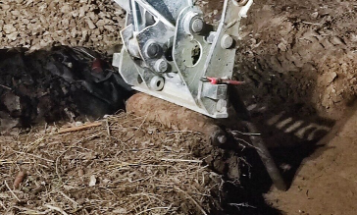 © Préfecture de l’Eure
© Préfecture de l’Eure
AN-M30 : 45 kg, explosive mass 24 kg
– Vernon (27). Wednesday, June 28, 2023.
Extraction of a phosphorus grenade in the garden, chemin de la Saudrerie. The 39-45 wartime device was detonated in “a cleared and secured area” by the Versailles de-miners.
– Arnières-sur-Iton (27). Friday, July 7, 2023.
Discovery of an explosive war device. The Versailles de-miners intervene. They will return on July 10 to clear up any doubts about possible storage of war waste.
ORNE DEPARTMENT
2019
– Trun (61). Wednesday, October 2, 2019.
A shell is unearthed in the middle of the afternoon during a network burial site. The Caen de-miners quickly intervened. The mayor thanks them for their responsiveness.
2020
– Andaine National Forest (61). October 2020.
The “trumpets of death” (name of the craterellus mushroom in French) have rarely lived up to their name. Dozens of cars are parked in the roads and lanes of the Andaine forest, more and more every year. Since the end of the Covid-19 lockdown, there has been a trend towards picking and even looting edible mushrooms. In less than 10 days, 10 shells were discovered. The Germans were bivouacking and storing ammunition and fuel in the forest. Allied aircraft were bombing. The gendarmerie was on the alert. They reminded us of the basic rule: don’t touch the ammunition. “Simply photograph them, geolocate them and alert the gendarmerie (number 17)”. The gendarmes fear that those who find shells, grenades and rockets will bring them back to their brigades. In La Ferté-Macé, Bagnoles-de-l’Orne and Domfront en Poiraie, waste collection centers and town halls are also threatened by these initiatives, which are both well-intentioned and misguided.
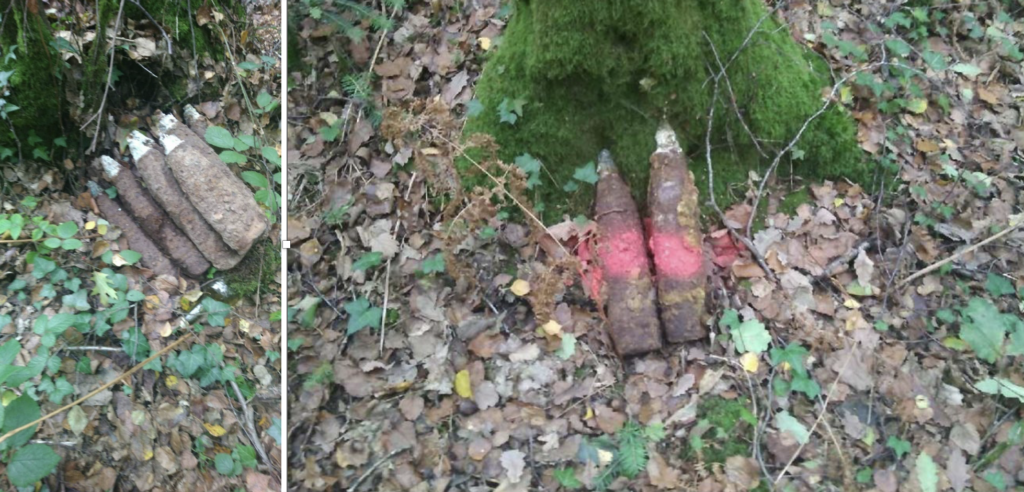 © Compagnie de gendarmerie de Domfront
© Compagnie de gendarmerie de Domfront
– Silly-en-Gouffern and Almenêches (61). Tuesday, October 20, 2020.
A jogger, metal detectorist and “39-45 enthusiast” is angry and tells the Journal de l’Orne. On Tuesday 20th, he found a rocket and a shell on a stump in the Gouffern forest. Unmistakable! In 2017, he had already found 2 Panzerfaust, German anti-tank grenade launchers on a stump not far from the second one. “When I see assholes like that! The detonator is still on the rocket, and the shell isn’t hit. If a kid finds them and brings them back, he goes off with them!”
– Saint-Quentin-les-Chardonnets (61). Thursday 12th and Thursday 19th November, 2020.
At a roadworks site near Route Départementale 924, an Eiffage excavator pulled a large American bomb out of the ground, which, to the amazement of witnesses, soon afterwards found its way into the skip of a truck loaded with earth, ready for export. The Gendarmerie was immediately alerted to the bad manoeuvre. Work was suspended and the bomb secured. On Thursday 19th, from 9am, it was installed in a specially dug pit. It weighs 226 kg with a 119 kg explosive mass. On flat ground, it can kill up to 800 metres with the missile effects of its shrapnel. With this protective shield in place, the safety radius was reduced from 800 to 400 meters, and the twenty or so inhabitants of the hamlet of La Morousière were evacuated by 8 a.m. Four people were accommodated in the local village hall. It was forbidden to fly over the area up to 1000 meters. While the refugees played chromino, the demining team worked hard to remove ignition systems and detonators. The progress of their work was visible on the command post screens. Once the operation had been successfully completed, the bomb, deactivated but still full of explosives, was transported by road to a quarry in La Ventrouze (130 km away) for blasting.
2023
– Camembert (61). Saturday, March 6, 2023.
A bomb in the Viette, a tributary of the Vie, which flows through the garden of Mr. and Mrs. Prieur. “It’s 57 cm long” and contains a good twenty kilos of explosives. The bomb squad is expected to arrive. To prevent the spindle-shaped, muddy device of war from rolling further downstream, it is held in place by a chained magnet.
– Mauves-sur-Huisne (61). Wednesday, February 22, 2023.
There’s another inhabitant who confuses the sorting area with the firing zone. Two alleged shells were discovered in the morning near the sorting bins by a resident leaving his home. The town hall and gendarmerie were immediately alerted. In mid-afternoon, the de-miners from the French civil protection organization (Sécurité Civile) took charge of them. In the meantime, the mayor had frozen the site by erecting nets around the containers, surrounded by ribbon tape, with a large exclamation mark road sign and a hand-written sign reading “Attention explosive!!”.
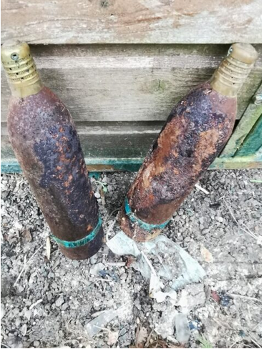 Probably German shells of 8.8 cm, fired and unexploded
Probably German shells of 8.8 cm, fired and unexploded
– Ecouché-les-Vallées (61). Monday, March 6, 2023.
While clearing access to the war memorial, the town’s 2 technical staff discovered a shell at around 9:30 am. The deminers from the Caen interdepartmental center intervened around midday. Next to the war memorial is the school.
SOURCES
Maps:
Atlas de la France Toxique (édition Arthaud, 2016) and Robin des Bois archives; OSPAR Convention for the Protection of the Marine Environment of the North-East Atlantic; Geomines; Grieme (Group for Research and Identification of Wrecks in the Eastern Channel); Ministry of the Armed Forces; Maritime Prefecture for the Channel and North Sea; Regional press; Naval Hydrographic and Oceanographic Service (SHOM).
Wrecks:
14Actu; Robin des Bois archives; Caen Ouistreham Plongée; Captain Class Frigates; D-Day Overlord; Drassm (Department of Subaquatic and Submarine Archaeological Research); Geomines; Grieme; James Martin Center for Nonproliferation Studies; Mémoire & Database; National Memorial to the Sailors who died for France; Mozolak J. New York Ships to Foreign Ports, 1939-1945: A Report of Over 5,000 Ships Sailing from New York; Naval History and Heritage Command; Maritime Prefecture for the Channel and North Sea; Society for Maritime Archaeology and Memory; Wikimanche.
Discoveries:
On the foreshore and offshore : 76actu ; Ver-sur-Mer Town ; France 3 Normandie ; France Bleu Cotentin ; France Bleu Normandie ; L’Éclaireur du Vimeu ; L’Informateur d’Eu ; La Manche Libre ; La Presse de la Manche ; La Renaissance – Le Bessin ; Le Courrier Cauchois ; Le Courrier Picard ; Le Marin; Les Informations Dieppoises ; Liberté – Le Bonhomme Libre ; Marine nationale ; Mer et Marine ; Ministère de la Défense ; Ministère des Armées ; Navy News, juillet 2010; Normandie44lamemoire.com ; Ouest France ; Paris-Normandie ; Prefecture of Calvados ; Maritime Prefecture for the Channel and North Sea; Tendance Ouest.
Manche Department : Cerema ; La Gazette de la Manche ; La Manche Libre ; La Presse de la Manche ; Memories of Men, Ministry of Defence; Ouest France ; Paris-Normandie ; Prefecture of Manche ; Wikimanche.
Calvados Department : D-Day Overlord ; Department of Calvados ; France 3 Normandie ; France Bleu Normandie ; La Manche Libre ; La Presse de la Manche ; La Renaissance – Le Bessin ; La Voix – Le Bocage ; Le Pays d’Auge ; Liberté – Le Bonhomme Libre ; Ouest France ; Paris Normandie ; Prefecture of Calvados ; Tendance Ouest.
Seine-Maritime Department : 76actu ; France 3 Normandie ; France Bleu Normandie ; L’Éclaireur – La Dépêche ; L’informateur d’Eu ; Le Courrier Cauchois ; Le Courrier Picard ; Le Réveil de Neufchâtel ; Les Informations Dieppoises ; Ouest France ; Paris-Normandie ; Prefecture of Normandie Region ; Prefecture of Seine-Maritime ; Tendance Ouest ; Rouen City.
Orne Department : L’Orne Combattante ; La Manche Libre ; Le Journal de l’Orne ; Le Perche ; Le Publicateur Libre ; Le Réveil Normand ; Ouest France ; Prefecture of Orne.
Eure Department : L’Éveil de Pont-Audemer ; L’Impartial ; La Dépêche ; La Dépêche de Louviers ; La Manche Libre ; Le Journal d’Elbeuf ; Le Réveil Normand ; Ouest France ; Paris-Normandie ; Prefecture of Eure.
Robin des Bois
14, rue de l’Atlas 75019 Paris, France
Tel: +33 (0)1 48 04 09 36 contact@robindesbois.org
Research : François Gasnier, Jacky Bonnemains, Gaëlle Guilissen, Elodie Crépeau and Charlotte Nithart
Writing : Jacky Bonnemains and Charlotte Nithart
Cartography and infography : Charlotte Nithart
Publication director : Jacky Bonnemains
Published on May 27, 2024, update on June 4, 2024
 Imprimer cet article
Imprimer cet article





